slashdot
description: a social news website that originally focused on technology and science-related news and discussions
132 results

Emergence
by
Steven Johnson
But it is increasingly recognized as the birthplace of Slashdot.org—the closest thing to a genuinely self-organizing community that the Web has yet produced. Begun as a modest bulletin board by a lifetime Hollander named Rob Malda, Slashdot came into the world as the ultimate in knowable communities: just Malda and his friends, discussing programming news, Star Wars rumors, video games, and other geek-chic marginalia. “In the beginning, Slashdot was small,” Malda writes. “We got dozens of posts each day, and it was good. The signal was high, the noise was low.” Before long, though, Slashdot floated across the rising tsunami of Linux and the Open Source movement and found itself awash in thousands of daily visitors.
…
The Slashdot system might seem a little complex, a little esoteric for consumers who didn’t grow up playing D&D, but think of the millions of people who learned how to use a computer for the first time in the past few years, just to get e-mail or to surf the Web. Compared to that learning curve, figuring out the rules of Slashdot is a walk in the park. And rules they are. You can’t think of a system like the one Malda built at Slashdot as a purely representational entity, the way you think about a book or a movie. It is partly representational, of course: you read messages via the Slashdot platform, and so the components of the textual medium that Marshall McLuhan so brilliantly documented in The Gutenberg Galaxy are on display at Slashdot as well.
…
A button that lets you e-mail a response to a published author; a tool that lets you build your own home page; even a collection of interlinked pages that let you follow your own path through them—these are all examples of interactivity, but they’re in a different category from the self-organizing systems of eBay or Slashdot. Links and home-page-building tools are cool, no question. But they are closer to a newspaper letters-to-the-editor page than Slashdot’s collective intelligence. First-generation interactivity may have given the consumer a voice, but systems like Slashdot force us to accept a more radical proposition: to understand how these new media experiences work, you have to analyze the message, the medium, and the rules. Think of those thousand-post geek-Dionysian frenzies transformed into an informative, concise briefing via the Slashdot quality filters. What’s interesting here is not just the medium, but rather the rules that govern what gets selected and what doesn’t.
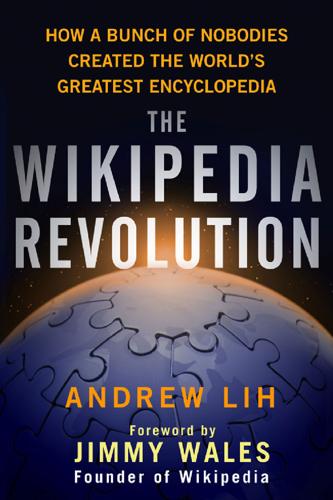
The Wikipedia Revolution: How a Bunch of Nobodies Created the World's Greatest Encyclopedia
by
Andrew Lih
Published 5 Jul 2010
He also set a goal: “I predict 1,000 [articles] by February 15.” In fact, they hit it three days early. Slashdotting If there was ever a salon for the technical elite and a grand senate of the computing community, it was Slashdot.org. Started originally as a user-contributed news 68_The_Wikipedia_Revolution site, Slashdot boldly proclaims as its pedigree: “News for nerds. Stuff that matters.” It lists significant technology stories in a blog format to foster discussion, but it started even before blogging became part of the Internet lexicon. What makes Slashdot more than just a blog is its unique community formula. A handful of the site operators serve as editors, sifting through user submissions to post on their front page taken from important technology stories from other outlets.
…
In fact, diving directly into the conversation without bothering to read the original story is such a typical action, one of the most common exclamations by regulars is “RTFA”—long-standing Internet jargon for “Read the friggin article!” Conversations in Slashdot are laced with inside jokes, ranging from bad 1980s Yakov Smirnoff laments about Soviet Russia, to cherished Simpsons quotes like “I for one welcome our insect overlords,” when talking about the risks of technology. Slashdot gained an intense following in the technology crowd because of its high caliber of contributors. It was a lively community that grew in size, but maintained quality as well. Slashdot became the tech elite’s peanut gallery and salon. If you won the hearts of Slashdot readers, you captured the in-crowd and gained extremely influential technology street cred.
…
But the story is simply a starting point. The real interesting content comes from the community discussion that ensues. Slashdot has become so popular that discussions are overrun by hundreds and thousands of comments, some pure gold, but many more pure crap. How do you sift the good from the bad when there are thousands of comments each day? Slashdot pioneered a way for self-policing the community with an innovative solution. In an era before the interactive and participatory Web 2.0 movement, Slashdot experimented with using something called meta-moderation. The system employed moderation techniques by tapping readers from time to time, not unlike the random marketing surveys found on many Web sites.

Epic Win for Anonymous: How 4chan's Army Conquered the Web
by
Cole Stryker
Published 14 Jun 2011
Their logo was a cartoonish parody of the goatse shock image, and their motto was “Gaping Holes Exposed.” Nerd News: Slashdot & Metafilter Slashdot founder Rob Malda, aka “Commander Taco,” says that he created Slashdot because he missed the high-minded technical community he enjoyed in the BBS era that discussed the sort of “news for nerds, stuff that matters” that interested him. In 1997, Slashdot offered something new: user-submitted stories. Each story became its own discussion thread. The site became so popular that when a story was linked by Slashdot, the site’s host would often buckle under the weight of all the traffic. This phenomenon became known as the Slashdot Effect. This phenomenon is not unique to Slashdot, but Slashdot was one of the first to be routinely recognized as a server killer.
…
You might not know that “CmdrTaco” is actually a dude named Rob, but on Slashdot at least, you know that each time you see a post with that name attached, you know it’s the same guy. I felt for Slashdot that it was important to provide that for people that wanted it. I don’t think that creates a sense of “personal responsibility” in any sort of globalized sense, but it allows you to build a reputation and history which might be important if you want to be taken seriously. Interestingly, anonymous posters on Slashdot are jokingly labeled “Anonymous Coward.” Matt Haughey was a big fan of Slashdot, but he wasn’t crazy about the interface. Slashdot had editors that picked from submitted stories.
…
This phenomenon is not unique to Slashdot, but Slashdot was one of the first to be routinely recognized as a server killer. Other sites can be farked, for example, or undergo the Digg Effect, demonstrating the power that content aggregators wield. Malda says that Slashdot developed its own unique memetic culture almost instantly. He remembers lots of gross-out memes popping up in addition to stuff from the Star Wars prequels, which were hugely popular during Slashdot’s early years. I asked him if there was a specific moment when he realized that memes were a thing. He replied, “Long before I heard the word, that’s for sure.”

Peer-to-Peer
by
Andy Oram
Published 26 Feb 2001
A thorough comparison of this with PGP’s web of trust and PKI systems is given by Yang, Brown, and Newmarch.[69] All of this brings up many issues of trust and public key semantics, about which we refer to Khare and Rifkin.[70] The point we’re interested in here is the way in which the web of trust depends on reputation to extend trust to new parties. Who will moderate the moderators: Slashdot The news site Slashdot.org is a very popular news service that attracts a particular kind of " Slashdot reader”—lots of them. Each and every Slashdot reader is capable of posting comments on Slashdot news stories, and sometimes it seems like each and every one actually does. Reputations based on this interaction can help a user figure out which of the many comments are worth reading. To help readers wade through the resulting mass of comments, Slashdot has a moderation system for postings. Certain users of the system are picked to become moderators.
…
As of this writing, the open source development site http://www.sourceforge.net (host to Freenet) is considering using a similar reputation system. The stakes at Advogato are higher than they are at Slashdot. If the Slashdot moderation system fails, a user sees stupid posts or misses something important. If the Advogato trust metric incorrectly certifies a potential volunteer as competent when he or she is not, a software project may fail. At least, this would be the case if people depended on the trust metric to find and contact free software volunteers. In practice, Advogato’s trust metric is used mostly for the same application as Slashdot’s: screening out stupid posts. The method of determining trust at Advogato also contains features that distinguish it from a simple rating system like Slashdot moderation.
…
Groove, Why secure email is a failure sandboxing, Sandboxing and wrappers Saudi Arabia and legal status of ISPs, Precedents and parries scalability, Performance Freenet and, Scalability Gnutella and, Scalability web of trust and, Codifying reputation on a wide scale: The PGP web of trust scale-free link distributions, Link distribution in Freenet Schmidt, Bob, Placing nodes on the network, Host caches Schmidt, Eric, File sharing: Napster and successors Schneier, Bruce, Cryptography fundamentals, Groove versus email scoring algorithms, Scoring algorithms–Scoring algorithms factoring credibility into, Credibility Free Haven, Reputation systems incorporating credibility into, Scoring algorithms Reputation Server, Reputation metrics–Reputation metrics treating reputations as probabilities, Scoring algorithms vs. privacy of transaction data, Privacy and information leaks scoring postings/posters on Slashdot, Who will moderate the moderators: Slashdot scoring systems, Scoring systems–True decentralization adversarial approach to, Scoring algorithms aspects of, Aspects of a scoring system attacks against, Attacks and adversaries, Attacks and adversaries bootstrapping, Bootstrapping collecting ratings, Collecting ratings confidence values and, Personalizing reputation searches decentralizing, Decentralizing the scoring system–True decentralization default reputation score, Bootstrapping detecting suspicious behavior, Scoring algorithms importance of user interface in, Personalizing reputation searches meta-reputation problem, Multiple trusted parties privacy/information leaks, Privacy and information leaks–Privacy and information leaks qualitative vs. quantitative information, Personalizing reputation searches qualities of good, Scoring systems Reputation Server, Identity as an element of reputation, Scoring system separating performance and credibility, Scoring algorithms timing attacks against privacy of, Privacy and information leaks true decentralization, True decentralization using multiple trusted parties, Multiple trusted parties using transactions to calculate ratings, Attacks and adversaries weighting a score, Reputation systems Scott, Tracy, Distributed intelligence SDMI (Secure Digital Music Initiative), Yesterday’s technology at tomorrow’s prices, two days late SDSI/SPKI (Simple Distributed Security Infrastructure/Simple Public Key Infrastructure), Codifying reputation on a wide scale: The PGP web of trust, Shared space formation and trusted authentication search algorithms and centralization, Decentralization search engines centralized vs. distributed, Trust and search engines–Distributed search engines problems with, Searching trust issues and, Trust and search engines–Deniability secret sharing algorithms, Anonymity for anonymous storage Publius, Secret sharing Secure Digital Music Initiative (SDMI), Yesterday’s technology at tomorrow’s prices, two days late Secure Sockets Layer (see SSL) security, Security–Taxonomy of Groove keys centralizing crucial aspects of, Central control and local autonomy–Central control and local autonomy collaboration and, Groove versus email email and, Groove versus email granular, distributed at workgroup level, Groove versus email guarantees made by Groove, Security Red Rover weaknesses and, Putting low-tech “weaknesses” into perspective–Putting low-tech “weaknesses” into perspective of reputation systems, Attacks and adversaries selecting favored users, Accountability Semantic Web, Resources and relationships: A historical overview SERENDIP project, Radio SETI server deniability, Anonymity for anonymous storage server software, Publius, Publius, Publish operation, Server software server volunteers, Denial of service attacks, Mojo Nation and Free Haven, Freenet server-anonymity, Anonymity for anonymous storage attacks on, Attacks on anonymity Eternity Usenet and, An analysis of anonymity Free Haven and, An analysis of anonymity Freenet and, An analysis of anonymity Gnutella and, An analysis of anonymity Publius and, An analysis of anonymity servers dormant, Introducers web (see web servers) servnet, Free Haven (see Free Haven, servnet) SETI@home, Some context and a definition, Maximizing use of far-flung resources: Distributed computation, SETI@home–The peer-to-peer paradigm client program of, How SETI@home works computations, How SETI@home works data distribution server, How SETI@home works detecting signals, How SETI@home works difficulties and challenges, Trials and tribulations drift rates and, How SETI@home works floating-point operations and, The world’s most powerful computer how it began, SETI@home–Radio SETI how it works, How SETI@home works–How SETI@home works peer-to-peer paradigm and, The peer-to-peer paradigm processor-specific optimizations, Trials and tribulations security challenges, Trials and tribulations SERENDIP and, How SETI@home works server performance problems, Trials and tribulations user interest in, Human factors world’s most powerful computer, The world’s most powerful computer SHA-1 hash function (Publius), Hash functions Shamir, Adi, Nonparallelizable work functions, Micropayment digital cash schemes Shamir’s secret sharing algorithm (Publius), Secret sharing, True decentralization shared databases, Ways to fill shared databases–Napster: Harnessing the power of personal selfishness shared spaces cryptographic algorithms, Security characteristics of a shared space email, Groove versus email weaknesses of, Why secure email is a failure–Why secure email is a failure forming, Shared space formation and trusted authentication–Shared space formation and trusted authentication Groove, Security, The solution: A Groove shared space inviting people into, Inviting people into shared spaces joining or leaving, Anatomy of a mutually-trusting shared space mutually-suspicious, Mutually-suspicious shared spaces–Fetching lost messages mutually-trusting, Mutually-trusting shared spaces–The key to mutual trust projecting identities into, Anatomy of a mutually-trusting shared space security characteristics of, Security characteristics of a shared space–Security characteristics of a shared space using a relay server for peer communication, Message fanout shares Free Haven expiration dates of, Share expiration splitting files into, Publication trading, The design of Free Haven, Trading Publius, System architecture, Publius in a nutshell protecting against update attacks, Using the Update mechanism to censor retrieving, Retrieve operation splitting the key into, Publish operation–Publish operation shilling, Attacks and adversaries categorizing reputations to defend against, Scoring algorithms tying feedback to transactions to avoid, Collecting ratings Shirky, Clay, Contents of this book, Listening to Napster–New winners and losers, Contributors Shostack, Adam, Communications channel signals, detecting (SETI@home), How SETI@home works Signature Verification Keys (SVKs), Signature Verification Keys (SVKs) signature/verification key pairs, Anatomy of a mutually-trusting shared space, Taxonomy of Groove keys signatures, digital (see digital signatures) Simon and Rackoff, Future work Simple Object Access Protocol (SOAP) and web services, Web services and content syndication Simple Symmetric Transport Protocol (SSTP), Message fanout simulating behavior over time Freenet, Initial experiments–Initial experiments Gnutella, Initial experiments–Initial experiments fault tolerance in a Freenet network, Simulating fault tolerance in Gnutella, Fault tolerance and link distribution in Gnutella growth, in a Freenet network, Simulating growth–Simulating growth Sipser, Michael, Open source software Slashdot effect, Freenet protecting against, Active caching and mirroring resource allocation and, Conclusion Slashdot moderation system, Who will moderate the moderators: Slashdot vs. Advogato trust metric, A reputation system that resists pseudospoofing: Advogato small-world effect, It’s a small, small world achieving performance gains, Initial experiments finding short routes between vertices, Initial experiments fundamental to Freenet, Case study 1: Freenet random node removal and, Simulating fault tolerance web of trust and, Codifying reputation on a wide scale: The PGP web of trust small-world graphs, The small-world model scaling properties of, Scalability Smirnov, Sergei, Acknowledgments Smith, Adam, Acknowledgments Sniffen, Brian, Attacks on the reputation system, Acknowledgments sniffers and compromised internal networks, Groove versus email SOAP (Simple Object Access Protocol) and web services, Web services and content syndication social inefficiencies data loss due to insufficient short-term storage, Moderating security levels: An accountability slider due to excessive micropayments, General considerations in an economic analysis of micropayment design social networks computer networks and, It’s a small, small world graph theory and, It’s a small, small world understanding link distribution in, The small-world model World Wide Web and, It’s a small, small world social pressure as censorship, Attacks on documents or the servnet SOCKS protocol, Technical solutions: Return to the old Internet Sokol-Margolis, Joseph, Acknowledgments spam (see junk mail) spent-coin database, Varieties of micropayments or digital cash spikes (signals), How SETI@home works SSL (Secure Sockets Layer) encrypting traffic between Publius client/server, SSL hub/client relationship in Red Rover, Putting low-tech “weaknesses” into perspective protecting online shopping, Why secure email is a failure SSTP (Simple Symmetric Transport Protocol), Message fanout stack model (Freenet), The data store–The data store statistical models of behavior, using to calculate reputation, Reputation metrics–Reputation metrics storage flooding attacks (see flooding attacks) streaming media applications and network congestion, The TCP rate equation: Cooperative protocols Strogatz, Steven, The small-world model–The small-world model Stubblebine, Stuart, Reputation metrics Stutz, Dave, Remaking the Peer-to-Peer Meme subpuzzles, Extended types of nonfungible micropayments, Moderating security levels: An accountability slider subscribers (Red Rover), The subscribers risks involved in becoming, Putting low-tech “weaknesses” into perspective Sullivan, Woody, SETI@home Sun Microsystems and revocation of browser certificates, Codifying reputation on a wide scale: The PGP web of trust super peers Gnutella and, File sharing: Napster and successors, Scalability Napster and, File sharing: Napster and successors SVKs (Signature Verification Keys), Signature Verification Keys (SVKs) symmetric algorithm, default, Security characteristics of a shared space symmetric ciphers, Encryption and decryption symmetric keys encrypting disk files, Anatomy of a mutually-trusting shared space instant messages, Anatomy of a mutually-trusting shared space, Taxonomy of Groove keys pairwise, Mutually-suspicious shared spaces synchronizing data, Security, The solution: A Groove shared space Syverson, P.F., Communications channel T tamper-check mechanism (Publius URL), Publius and other systems in this book, Retrieve operation, Publius in a nutshell tampering with files, Message digest functions TCP rate equation, The TCP rate equation: Cooperative protocols–The TCP rate equation: Cooperative protocols TCP-based broadcasts (Gnutella), TCP broadcast technology copyright infringement issues, Afterword–Who gets to innovate?

Peers, Pirates, and Persuasion: Rhetoric in the Peer-To-Peer Debates
by
John Logie
Published 29 Dec 2006
“Re: Look, this is silly.” Slashdot. 26 Feb. 2000. slashdot.org. 20 Aug. 2006 <http://slashdot.org/comments.pl?sid=10781&cid=401279>. “When David Steals Goliath’s Music.” New York Times. 28 Mar. 2005. Nytimes.com. 20 Aug. 2006 <http://select.nytimes.com/search/restricted/ article?res=F30914FB3E5B0C7B8EDDAA0894DD404482>. Wu, Tim. “Exit Valenti.” Lessig Blog. 2 Aug. 2004. 20 Aug. 2006 <http:// www.lessig.org/blog/archives/002065.shtml>. Yoos, George. “Ethos.” Encyclopedia of Rhetoric and Composition. Ed. Theresa Enos. New York: Garland, 1996. 410–14. Zikzak. “Re: Look, this is silly.” Slashdot. 26 Feb. 2000. slashdot.org. 20 Apr. 2005 <http://slashdot.org/comments.pl?
…
<http:// www.unc.edu/~cigar/papers/FileSharing_March2004.pdf>. Patterson, Lyman Ray. Copyright in Historical Perspective. Nashville, TN: Vanderbilt UP, 1968. Porter, James E. “Intertextuality and the Discourse Community.” Rhetoric Review 5.1 (1986): 34–47. Rader. “Re: Look, this is silly.” Slashdot. 26 Feb. 2000. slashdot.org. 20 Aug. 2006 <http://slashdot.org/comments.pl?sid=10781&cid=401120>. Recording Industry Association of America. “725 Additional Illegal File Sharers Cited In New Wave of Copyright Infringement Lawsuits.” RIAA. 27 Apr. 2005. riaa.com. 20 Aug. 2006 <http://www.riaa.com/News/ newsletter/042705.asp>. —.
…
But the carelessness with which Rader draws this analogy prompted an incredulous response from another Slashdot correspondent: ZIKZAK: Holy shit! Are you really claiming that the battle over MP3 pirating could be equivalent in importance to the Vietnam War? Fuck, I have now seen the absolute pinnacle of pathetic justification. Equating the slightly over-priced and admittedly greedy recording industry’s practices to the death of thousands and thousands of young men is absolutely the lowest thing I’ve ever seen on slashdot. Congratulations. You have scraped absolute bottom. Zikzak’s outburst prompted what appeared to be an embarrassed silence from Rader, and other participants, in what had, to that point, been a lively discussion.

The Wealth of Networks: How Social Production Transforms Markets and Freedom
by
Yochai Benkler
Published 14 May 2006
They spend time selecting sites for inclusion in the directory (in small increments of perhaps fifteen minutes per site reviewed), producing the most comprehensive, highest-quality human-edited directory of the Web--at this point outshining the directory produced by the company that pioneered human edited directories of the Web: Yahoo!. 155 Perhaps the most elaborate platform for peer production of relevance and accreditation, at multiple layers, is used by Slashdot. Billed as "News for Nerds," Slashdot has become a leading technology newsletter on the Web, coproduced by hundreds of thousands of users. Slashdot primarily consists [pg 77] of users commenting on initial submissions that cover a variety of technology-related topics. The submissions are typically a link to an off-site story, coupled with commentary from the person who submits the piece.
…
The initial submissions themselves, and more importantly, the approach to sifting through the comments of users for relevance and accreditation, provide a rich example of how this function can be performed on a distributed, peer-production model. 156 First, it is important to understand that the function of posting a story from another site onto Slashdot, the first "utterance" in a chain of comments on Slashdot, is itself an act of relevance production. The person submitting the story is telling the community of Slashdot users, "here is a story that `News for Nerds' readers should be interested in." This initial submission of a link is itself very coarsely filtered by editors who are paid employees of Open Source Technology Group (OSTG), which runs a number of similar platforms--like SourceForge, the most important platform for free software developers.
…
In other words, Slashdot very self-consciously is organized as a means of facilitating peer production of accreditation; it is at the comments stage that the story undergoes its most important form of accreditation--peer review ex-post. 157 Filtering and accreditation of comments on Slashdot offer the most interesting case study of peer production of these functions. Users submit comments that are displayed together with the initial submission of a story. Think of the "content" produced in these comments as a cross between academic peer review of journal submissions and a peer-produced substitute for television's "talking heads." It is in the means of accrediting and evaluating these comments that Slashdot's system provides a comprehensive example of peer production of relevance and accreditation. Slashdot implements an automated system to select moderators from the pool of users.

Content: Selected Essays on Technology, Creativity, Copyright, and the Future of the Future
by
Cory Doctorow
Published 15 Sep 2008
s ability to read, review, rank and categorize them. Hence Slashdot, a system of distributed slushreading. Rather than professionalizing the editorship role, Slashdot invites contributors to identify good stuff when they see it, turning editorship into a reward for good behavior. But as well as Slashdot works, it has this signal failing: nearly every conversation that takes place on Slashdot is shot through with discussion, griping and gaming on the moderation system itself. The core task of Slashdot has become editorship, not the putative subjects of Slashdot posts. The fact that the central task of Slashdot is to rate other Slashdotters creates a tenor of meanness in the discussion.
…
The early experimental days of the Internet saw much experimentation with alternatives to traditional editor/author divisions. Slashdot, a nerdy news-site of surpassing popularity [fn: Having a link to one's website posted to Slashdot will almost inevitably overwhelm your server with traffic, knocking all but the best-provisioned hosts offline within minutes; this is commonly referred to as "the Slashdot Effect."], has a baroque system for "community moderation" of the responses to the articles that are posted to its front pages. Readers, chosen at random, are given five "moderator points" that they can use to raise or lower the score of posts on the Slashdot message boards. Subsequent readers can filter their views of these boards to show only highly ranked posts.
…
Other readers are randomly presented with posts and their rankings and are asked to rate the fairness of each moderator's moderation. Moderators who moderate fairly are given more opportunities to moderate; likewise message-board posters whose messages are consistently highly rated. It is thought that this system rewards good "citizenship" on the Slashdot boards through checks and balances that reward good messages and fair editorial practices. And in the main, the Slashdot moderation system works [fn: as do variants on it, like the system in place at Kur5hin.org (pronounced "corrosion")]. If you dial your filter up to show you highly scored messages, you will generally get well-reasoned, or funny, or genuinely useful posts in your browser.
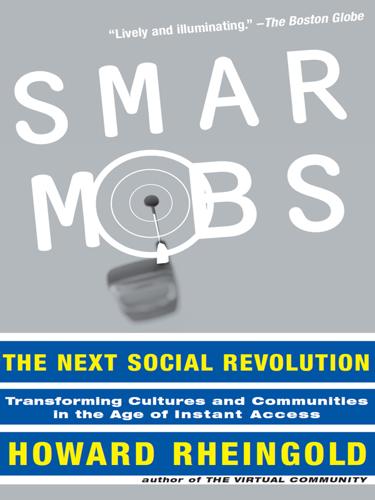
Smart Mobs: The Next Social Revolution
by
Howard Rheingold
Published 24 Dec 2011
They deleted spam and awarded points to posts that seemed valuable. Then the Slashdot population grew unmanageable even for twenty-five volunteers. By 1999, if a link to a Web site was posted as a top-level story on Slashdot, that Web site would get so many hits that host servers often crashed, a phenomenon that came to be known Netwide as “being Slash-dotted.” The original twenty-five moderators chose four hundred more. The Slashdot karma system emerged to filter out noise, point out good postings, and protect against abuse of power from moderators. When a registered user logs in often enough and reads postings over a sustained period, Slashdot’s “Slashcode” software automatically puts that user in a pool of candidates for jury-like service.
…
Official editors would select relevant stories every day, post links and commentary, and the Slashdot community around the world added commentary in the form of sequential posts. Malda, who goes by the online handle “Commander Taco,” called it “Slashdot,” after a commonly used Linux command. Malda later wrote: “We got dozens of posts each day, and it was good. The signal was high, the noise was low.”22 The time was right for a virtual watering hole to appear as a hangout for the programmers around the world who shared the open source zeitgeist. The Slashdot population grew, and soon there were too many posts to police and too much noise to ignore.
…
Moderators use their allotment of points to raise or lower the settings of selected posts and hence affect the karma of the selected posters. Slashdot readers can use a menu to set their “quality filter” reading level. Some readers can choose to read every one of hundreds of posts in a particular discussion; others can set their quality filter to read only those with a rating of 3 or above, usually reducing the number of posts to dozens, or set their quality filter to show only those with the highest rating of five, sometimes reducing a thread of hundreds of posts to a handful. By 2001, the Slashdot community of registered users exceeded 300,000. At that scale, there was no way to organize except self-organize.

Robots Will Steal Your Job, But That's OK: How to Survive the Economic Collapse and Be Happy
by
Pistono, Federico
Published 14 Oct 2012
http://en.wikipedia.org/wiki/Internet_censorship_in_the_United_States 96 PROTECT IP / SOPA Breaks The Internet, Kirby Ferguson, 2012. http://vimeo.com/31100268 97 Stop Online Piracy Act. Wikipedia. http://en.wikipedia.org/wiki/Stop_Online_Piracy_Act 98 Anti-Counterfeiting Trade Agreement What is ACTA?. Electronic Frontier Foundation. https://www.eff.org/issues/acta 99 Extracts from the Slashdot discussion on SOPA, 2012. Slashdot. http://tech.slashdot.org/story/11/12/16/1943257/congresss-techno-ignorance-no-longer-funny 100 The Top 0.1% Of The Nation Earn Half Of All Capital Gains, Robert Lenzner, 2011. Forbes. http://www.forbes.com/sites/robertlenzner/2011/11/20/the-top-0-1-of-the-nation-earn-half-of-all-capital-gains/ 101 A nationally representative and continuing assessment of English language literary skills of American Adults, National Assessment of Adult Literacy (NAAL).
…
https://en.wikipedia.org/wiki/Watson_\%28computer 87 Mission Control, Built for Cities. I.B.M. Takes ‘Smarter Cities’ Concept to Rio de Janeiro, Natasha Singer, 2012. New York Times. http://www.nytimes.com/2012/03/04/business/ibm-takes-smarter-cities-concept-to-rio-de-janeiro.html?pagewanted=all 88 Will IBM Watson Be Your Next Mayor?, 2012. Slashdot. http://yro.slashdot.org/story/12/04/27/0029256/will-ibm-watson-be-your-next-mayor 89 Computers to Acquire Control of the Physical World, P. Magrassi, A. Panarella, N. Deighton, G. Johnson, 2001. Gartner research report. T-14-0301. 90 A World of Smart Objects, P. Magrassi, T. Berg, 2002. Gartner research report.
…
http://www.gallup.com/poll/126560/americans-global-warming-concerns-continue-drop.aspx 104 Climate scepticism ’on the rise’, BBC poll shows, 2010. BBC. http://news.bbc.co.uk/2/hi/8500443.stm 105 Climate change: How do we know?. NASA. http://climate.nasa.gov/evidence/ 106 Climate Change Skeptic Results Released Today, 2011. Slashdot. http://news.slashdot.org/story/11/10/31/1255205/climate-change-skeptic-results-released-today 107 Robotic Nation, Marshall Brain. http://marshallbrain.com/robotic-nation.htm 108 Employed persons by detailed occupation, sex, race, and Hispanic or Latino ethnicity. Bureau of Labor Statistics. ftp://ftp.bls.gov/pub/special.requests/lf/aat11.txt 109 Employment Situation Summary.

Digital Gold: Bitcoin and the Inside Story of the Misfits and Millionaires Trying to Reinvent Money
by
Nathaniel Popper
Published 18 May 2015
Martti agreed with a handful of other users that Slashdot would be the best place to do this. “Slashdot with its millions of tech-savvy readers would be awesome, perhaps the best imaginable!” Martti wrote on the forum. “I just hope the server can stand getting ‘slashdotted.’” A small crew went back and forth about the right language to submit to the Slashdot editors. Satoshi got his hackles up when someone suggested Bitcoin be sold as “outside the reach of any government.” “I am definitely not making any such taunt or assertion,” Satoshi wrote. He quickly apologized for being a wet blanket: “Writing a description for this thing for general audiences is bloody hard.
…
But this, and the derogatory comments that showed up under the Slashdot item, did not dampen his enthusiasm. This was what he’d been waiting for for months. CHAPTER 5 July 12, 2010 When he awoke late, the morning after the Slashdot posting, Martti Malmi saw that the attention was not a hit-and-run phenomenon. People weren’t just taking a look at the site and moving on. They were also downloading and running the Bitcoin software. The number of downloads would jump from around three thousand in June to over twenty thousand in July. The day after the Slashdot piece appeared, Gavin Andresen’s Bitcoin faucet gave away 5,000 Bitcoins and was running empty.
…
CHAPTER 4 44But on May 22, 2010, a guy in California offered to call Lazlo’s local Papa John’s: Information about the Bitcoin transaction is available at https://blockchain.info/tx/a1075db55d416d3ca199f55b6084e2115b9345e16c5cf302fc80e9d5fbf5d48d. 44small item on the website of InfoWorld: Neil McAllister, “Open Source Innovation on the Cutting Edge,” Info World, May 24, 2010, http://www.infoworld.com/article/2627013/open-source-software/open-source-innovation-on-the-cutting-edge.html. 47“Slashdot with its millions of tech-savvy readers”: Martti Malmi to BTCF, June 22, 2010. 48“How’s this for a disruptive technology?”: “Bitcoin Releases Version 0.3,” Slashdot, July 11, 2010, http://news-beta.slashdot.org/story/10/07/11/1747245/bitcoin-releases-version-03. CHAPTER 5 49The number of downloads would jump from around three thousand: Data on software downloads available at http://sourceforge.net/projects/bitcoin/files/stats/timeline. 49“Over the last two days of Bitcoin being”: Gavin Andresen to BTCF, July 14, 2010. 53the difficulty of mining new Bitcoins jumped 300 percent: Data on mining difficulty available at https://blockchain.info/charts/difficulty?
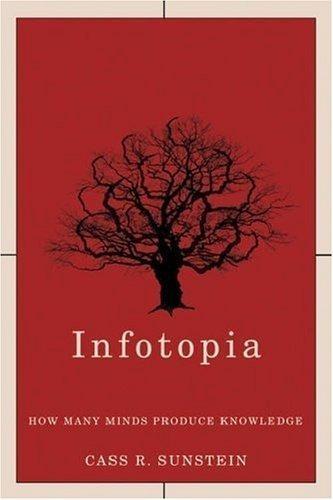
Infotopia: How Many Minds Produce Knowledge
by
Cass R. Sunstein
Published 23 Aug 2006
Consider a few of many examples. Slashdot, the largest community-driven technology site on the Internet, has long identified itself as “news for nerds, stuff that matters.” Slashdot is, among other things, an edited compilation of news abstracts, focusing on a wide range of topics related to technology. A first-time visitor to Slashdot will notice that the site resembles an ordinary news site, with story headlines, synopses, and links to follow. But its real value lies in the fact that it permits its users to discuss both news articles and one another’s posts. Specifically, Slashdot users can spark discussions by posting ideas and responses to particular articles, thus facilitating discussion.
…
Specifically, Slashdot users can spark discussions by posting ideas and responses to particular articles, thus facilitating discussion. Of course, the system is vulnerable to irrelevant, silly, and abusive comments. Slashdot’s ingenious response is a “moderation system,” by which users judge comments and rank them by score. At first, the founders of Slashdot Many Working Minds / 191 moderated posts themselves. But as the user base expanded, the job of moderating became unmanageable and was therefore delegated to users. As a result, a group of moderators has been selected from a pool of active users. Many minds thus evaluate the contributions of many minds.
…
Moderators can add or deduct points from a comment’s score, thus influencing whether a comment will be immediately visible to a reader. (Confession: Slashdot had a discussion of my 2001 book, Republic.com; as the author, I ventured a nonanonymous comment, which was ranked very low: 0, as I recall. True, I probably deserved the low ranking.) Of course, there is a risk that the moderators will promote an agenda of their own. To combat that risk, Slashdot has produced the ingenious mechanism of “metamoderation,” which operates as a review process of the moderation system. Instead of rating the usefulness of a comment, metamoderation rates the fairness and accuracy of the moderator’s judgment.58 According to the metamoderation statistics, 92 percent to 93 percent of moderations are judged fair.59 (Hence, it is not necessary, to date, to create metametamoderation, reviewing the metamoderators!)

Bitcoin: The Future of Money?
by
Dominic Frisby
Published 1 Nov 2014
The pizza arrived. For several days after that, Hanyecz bought 10,000-bitcoin pizzas. I bet he regrets it now. Ten thousand bitcoins would at one stage be worth over 12 million dollars. Twelve million bucks for a pizza! July 2010 saw Bitcoin’s first step out of obscurity. It was mentioned on the website Slashdot and there was a sudden increase in interest. The value of a bitcoin went up over ten times in a week – from eight-tenths of one cent to eight cents. The price would slide back to six cents and remain there for several months. Then another Bitcoin exchange sprung up, one that would become the biggest and most notorious – MtGox. 3 The Rise of Bitcoin and the Disappearance of its Maker I think that the internet is going to be one of the major forces for reducing the role of government.
…
39It was the most prominent site yet to mention Bitcoin and suggested it may be the answer to WikiLeaks’ funding problems. A sudden flood of traffic overwhelmed Bitcoin’s website and it went down. When it came back up again, Satoshi wrote, ‘It would have been nice to get this attention in any other context. WikiLeaks has kicked the hornet’s nest, and the swarm is headed towards us.’ Then Bitcoin was mentioned on Slashdot again, alongside WikiLeaks and the outspoken libertarian US congressman, Ron Paul. Meanwhile, the Financial Action Task Force issued warnings that digital currencies were being used to finance terrorist groups.40 The following morning, on December 12th 2010, Satoshi outlined some technical developments he had made.
…
It’s unlikely he wanted accusations of terrorism levelled against him. Even if they were unfounded, they could have ruined his life and the lives of those close to him. Whether it was WikiLeaks, the CIA or both that caused it, Satoshi had vanished. The rise of Bitcoin That July 2010 mention on Slashdot was a catalyst. More and more users flocked to Bitcoin over the following months. New operations sprung up to mine coins. Open-source development of the protocol continued. At first, the price of a bitcoin remained flat at around six cents, but then it began to rise. In November, it touched 50 cents.
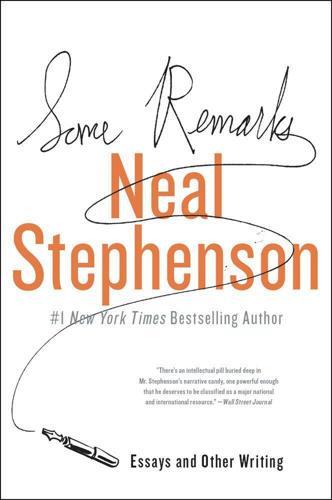
Some Remarks
by
Neal Stephenson
Published 6 Aug 2012
It sounds a bit odd, and it would definitely constitute a revolution in office culture, but we already heading in that direction; it’s getting difficult to walk safely in places like airports and Manhattan streets because of all the busy people striding blindly ahead with their eyes fixed on the screens of their iPhones. Putting them in a place devoid of brick walls and speeding taxicabs would make the world healthier for them, and safer for all of us. Slashdot Interview (2004) [questions contributed by Slashdot readers] THE LACK OF RESPECT . . . —BY MOSESJONES Science Fiction is normally relegated to the specialist publications rather than having reviews in the mainstream press. Seen as “fringe” and a bit sad it’s seldom reviewed with anything more than condescension by the “quality” press.
…
Visit www.AuthorTracker.com for exclusive information on your favorite HarperCollins authors. Also by Neal Stephenson Reamde Anathem The System of the World The Confusion Quicksilver Cryptonomicon The Diamond Age Snow Crash Zodiac Permissions A version of “Slashdot Interview” previously appeared on Slashdot.org. A version of “Metaphysics in the Royal Society 1715–2010” previously appeared in Seeing Further: The Story of Science & the Royal Society edited by Bill Bryson. Published by HarperCollins in 2010. A version of “It’s All Geek to Me,” “Turn On, Tune In, Veg Out,” and “Blind Secularism” previously appeared in The New York Times.
…
Some Remarks Essays and Other Writing Neal Stephenson Contents Introduction Arsebestos (2012) Slashdot Interview (2004) Metaphysics in the Royal Society 1715–2010 (2012) It’s All Geek to Me (2007) Turn On, Tune In, Veg Out (2006) Gresham College Lecture (2008) Spew (1994) In the Kingdom of Mao Bell (selected excerpts) (1994) Under-Constable Proudfoot (2012) Mother Earth, Mother Board (1996) The Salon Interview (2004) Blind Secularism (1993) Time Magazine Article About Anathem (2012) Everything and More Foreword (2003) The Great Simoleon Caper (1995) Locked In (2011) Innovation Starvation (2011) Why I Am a Bad Correspondent (1998) About the Author Also by Neal Stephenson Permissions Footnotes Credits Copyright About the Publisher Introduction Certain persons who know what they are talking about where publishing is concerned have assured me that I have reached the stage in my life and career where it is not only possible, but advisable, to release a compilation of what are drolly referred to as my “shorter” works.

Programming Collective Intelligence
by
Toby Segaran
Published 17 Dec 2008
If you'd like to enter the data manually, add this to the top of the file: my_data=[['slashdot','USA','yes',18,'None'], ['google','France','yes',23,'Premium'], ['digg','USA','yes',24,'Basic'], ['kiwitobes','France','yes',23,'Basic'], ['google','UK','no',21,'Premium'], ['(direct)','New Zealand','no',12,'None'], ['(direct)','UK','no',21,'Basic'], ['google','USA','no',24,'Premium'], ['slashdot','France','yes',19,'None'], ['digg','USA','no',18,'None'], ['google','UK','no',18,'None'], ['kiwitobes','UK','no',19,'None'], ['digg','New Zealand','yes',12,'Basic'], ['slashdot','UK','no',21,'None'], ['google','UK','yes',18,'Basic'], ['kiwitobes','France','yes',19,'Basic']] If you'd prefer to download the dataset, it's available at http://kiwitobes.com/tree/decision_tree_example.txt.
…
If you collect the data and put it in a table, it might look like Table 7-1. Table 7-1. User behavior and final purchase decision for a web site Referrer Location Read FAQ Pages viewed Service chosen Slashdot USA Yes 18 None Google France Yes 23 Premium Digg USA Yes 24 Basic Kiwitobes France Yes 23 Basic Google UK No 21 Premium (direct) New Zealand No 12 None (direct) UK No 21 Basic Google USA No 24 Premium Slashdot France Yes 19 None Digg USA No 18 None Google UK No 18 None Kiwitobes UK No 19 None Digg New Zealand Yes 12 Basic Google UK Yes 18 Basic Kiwitobes France Yes 19 Basic Arrange the data in a list of rows, with each row being a list of columns.
…
T-> {'Basic': 1} F-> {'None': 1} F-> 0:slashdot? T-> {'None': 3} F-> 2:yes? T-> {'Basic': 4} F-> 3:21? T-> {'Basic': 1} F-> {'None': 3} This is a visual representation of the process that the decision tree will go through when trying to make a new classification. The condition on the root node is "is Google in column 0?" If this condition is met, it proceeds to the T-> branch and finds that anyone referred from Google will become a paid subscriber if they have viewed 21 pages or more. If the condition is not met, it jumps to the F-> branch and evaluates the condition "is Slashdot in column 0?" This continues until it reaches a branch that has a result.

More Joel on Software
by
Joel Spolsky
Published 25 Jun 2008
Instead of deleting posts, why don’t you have a moderation scheme, where people vote on how much they like a post, and people can choose how high the vote has to be before they read it? A. This is, of course, how Slashdot works, and I’ll bet you 50% of the people who read Slashdot regularly have never figured it out. There are three things I don’t like about this. One: it’s more UI complication, a feature that people need to learn how to use. Two: it creates such complicated politics that it make the Byzantine Empire look like third-grade school government. And three: when you read Slashdot with the filters turned up high enough that you see only the interesting posts, the narrative is completely lost.
…
Building Communities with Software 113 On most investment discussion boards, it’s practically impossible to follow a thread from beginning to end, because every post is its own page, which makes for a lot of banner ad inventory, but the latency in reading a conversation will eventually drive you nuts. The huge amount of flashing commercial crap on all four sides of the conversation makes you feel like you were trying to make friends in Times Square, but the neon lights keep demanding all the attention. On Slashdot, every thread has hundreds of replies, many of which are identical, so the conversation there feels insipid and stupid. In a moment, I’ll reveal why Slashdot has so many identical replies, and the Joel on Software forum doesn’t. And on FuckedCompany.com, the discussion board is completely, utterly worthless; the vast majority of posts consist of irrelevant profanity and general abusiveness, and it feels like a fraternity rudeness contest, without any fraternity.
…
Of course, I can’t physically grab your eyeballs and move them from left to right, forcing you to read the entire thread before letting you post, but if I put a “Reply” link anywhere but the bottom of the page, that would positively encourage people to spew their little gems before they’ve read what’s already there. This is why Slashdot topics have 500 replies but only 17 interesting replies, and it’s why nobody likes to read Slashdot discussions: they sound like a classroom full of children all shouting out the same answer at the same time. (“Ha ha . . . Bill Gates! That’s an oxymoron!”) Q. The damn “Start a New Topic” link is all the way at the bottom . . . A. Uh huh, same thing.

Rebel Code: Linux and the Open Source Revolution
by
Glyn Moody
Published 14 Jul 2002
The analogy with the continued honing of the Linux kernel through the successive application of patches sent in by hackers around the world is clear. The “Slashdot effect”—the deluge of visitors to a Web site if it is mentioned in a story—is by now famous, but more important is the other Slashdot effect of creating a powerful distributed news gathering and filtering machine that is independent of the ordinary media companies (Slashdot is owned by VA Linux). Slashdot is a highly visible example of where the open source philosophy challenges the traditional structures of information, especially economic and legal, and its dissemination.
…
But the story took an even more interesting turn when hackers flouted the licensing requirements and posted the full details of Microsoft’s extension to the Slashdot.org site at the beginning of May. On 11 May 2000, Microsoft responded by sending an e-mail to Slashdot regarding what it termed “unauthorized reproductions of Microsoft’s copyrighted work” on the site. That is, Microsoft invoked copyright law, specifically the relatively new U.S. Digital Millennium Copyright Act, which grants copyright owners wide-ranging powers to pursue copyright infringement. Slashdot responded by declaring its “hesitation to engage in censorship” through withdrawal of postings made by its readers.
…
Since then, the Open Directory database has been taken up by several other high-profile sites, including Lycos, Google and HotBot, in some cases displacing proprietary content. Open source methodology has also been applied with great success in what might be called open journalism; it is best exemplified by the Slashdot.org Web site, created in September 1997 by Rob “CmdrTaco” Malda, which has as its motto “News for nerds. Stuff that matters.” The “stuff that matters” is essentially free software, together with a range of related subjects. The site’s most important feature is that it offers not so much news for nerds as news by nerds: Most of the material is sent in by readers and the stories that appear each day on the site are chosen from the submissions.

This Is for Everyone: The Captivating Memoir From the Inventor of the World Wide Web
by
Tim Berners-Lee
Published 8 Sep 2025
These Apache servers worked really well for hosting individual web pages, but they had a weakness: if a website suddenly became popular, the host would be overwhelmed with requests, causing the page to become unresponsive and the server to crash. I termed this the ‘hot spot’ problem, although it is better known as getting ‘slashdotted’. Slashdot was a website popular in the tech community that allowed users to post and upvote new links – it was one of the first mechanisms for making content go ‘viral’. A post that made it to the top of Slashdot might result in hundreds of thousands of users clicking on the link at once, enough traffic to bring down all but the most powerful web servers. In the mid-1990s, I was very concerned that slashdotting would limit the growth of the web. Now, the advantage of being at a place like MIT is that you will often find yourself in the company of some rather clever people.
…
Sometime in the mid-1990s, Professor Tom Leighton began complaining at a faculty lunch that the web, while obviously useful, didn’t really lead to any ‘deep’ problems in computer science that an academic could study. Offended, I immediately brought up the slashdotting problem, which certainly seemed to me like a worthy challenge for an ambitious academic! Soon, Tom was presenting the slashdotting problem to a lecture hall full of MIT graduate students. One of those students was Daniel Lewin, a star PhD candidate and wizard in computational complexity theory. In this hall of geeks, Daniel – or Danny, as everyone called him – cut a somewhat unusual figure; he’d spent several years in a special forces unit of the Israeli Defence Forces, rising to the rank of captain.
…
R. ref1 MasterCard ref1 Mastodon ref1, ref2 mathematics ref1, ref2, ref3, ref4 Matrix ref1 media industry ref1 mental health and social media ref1, ref2, ref3 ‘Mesh’ memo ref1 Meta ref1, ref2, ref3 see also Facebook metadata ref1 metasystems ref1 Metaverse ref1 Metcalf, Bob ref1 MeWe ref1 micropayments ref1 microprocessors ref1, ref2 Microsoft ActiveX ref1 Clippy ref1 Copilot ref1 copyright infringement ref1 early lack of browser ref1 Internet Explorer ref1, ref2, ref3, ref4, ref5 MS-DOS ref1 Office ref1 standards ref1, ref2 Teams ref1 XML ref1 Microsoft Exchange Server ref1 microtargeting ref1, ref2 Middle Earth ref1 Middle Earth map ref1 military applications ref1 Millennium Technology Prize ref1 Miller, Kaia ref1 Minnesota, University of ref1, ref2 misinformation ref1, ref2 MIT Center for Constructive Communication ref1 Computer Science and Artificial Intelligence Lab (CSAIL) ref1, ref2 speaking tours ref1 Tim Berners-Lee’s arrival ref1 Tim Berners-Lee’s early visits ref1, ref2 World Wide Web Consortium (W3C) ref1, ref2, ref3 mobile phones CSS (cascading style sheets) ref1 licences legislation ref1 touchscreens ref1 see also smartphones model railway ref1 modems broadband ref1 dial-up ref1, ref2 download speeds ref1, ref2 Moffat, John ref1, ref2, ref3 monopolization ref1, ref2, ref3, ref4, ref5, ref6 Montulli, Lou ref1 moon landings ref1 Moore’s Law ref1 Morsi, Mohammed ref1 Mosaic browser ref1, ref2, ref3, ref4 ‘The Mother of all Demos’ (Engelbart) ref1 motivation-hygiene theory ref1 Motorola ref1 Mount Stromlo Observatory ref1 Mozilla foundation ref1, ref2, ref3 MP3s ref1 Mubarak, Hosni ref1 multimedia ref1, ref2 Murthy, Vivek ref1 music collaboration ref1 copyright ref1 illuminated Italian Renaissance website ref1 MP3s ref1 recommendation services ref1, ref2 Tim Berners-Lee’s interest ref1 Musk, Elon ref1, ref2 MyData ref1 MySpace ref1 Myst (game) ref1 narrowcasting ref1, ref2, ref3 National Science Foundation ref1 National Theatre, London ref1 Naver Maps ref1 NCSA (National Center for Supercomputing Applications) ref1, ref2, ref3, ref4, ref5, ref6 Nelson, Ted ref1, ref2 neoliberalism ref1 net neutrality ref1, ref2, ref3 Netflix ref1, ref2 netiquette ref1 Netscape ref1, ref2, ref3, ref4, ref5, ref6 networking fractal ref1 humans as social animals ref1 neural networks ref1, ref2, ref3, ref4 URLs ref1 New York Times, The ref1, ref2, ref3 Newmark, Craig ref1 news organizations ref1 newsgroups ref1, ref2 NeXT ref1, ref2, ref3, ref4, ref5, ref6, ref7, ref8 NFT of original WWW code ref1 Ng, Andrew ref1 NHS ref1, ref2 Nigeria ref1 Nilekani, Nandan ref1 9/11 attacks ref1, ref2 Nix, Alexander ref1 Nobel Prize ref1, ref2, ref3, ref4 Nokia ref1 nuclear weapons ref1 Nupedia ref1 Nvidia ref1, ref2 Objective-C code ref1 Olympics, 2012 London ref1, ref2 Ong, Jonathan Corpus ref1 Open Data Institute (ODI) ref1, ref2, ref3, ref4 see also Solid open-source software ref1, ref2, ref3, ref4, ref5, ref6 Open Systems Interconnection (OSI) ref1 OpenAI ref1, ref2, ref3, ref4, ref5 OpenStreetMap ref1, ref2 Opera browser ref1, ref2, ref3, ref4 Opzoomer, Indi (Leith) ref1 Opzoomer, Jamie (Leith) ref1 Opzoomer, Lyssie (Leith) ref1 Order of Merit of the British Empire ref1, ref2 O’Reilly ref1, ref2, ref3 Oxford University ref1, ref2, ref3, ref4 PACER ref1 packet-switching ref1 Page, Larry ref1, ref2 PageRank ref1 pantomime ref1 ‘paperclip maximizer’ ref1 paradigm shift, artificial intelligence (AI) ref1 passkeys ref1 passwords ref1 patents ref1 peace ref1 Pellow, Nicola ref1 Penrose, Roger ref1 Pentagon ref1, ref2, ref3 Pets.com ref1 philanthropy ref1 Philippines ref1 photographs, metadata ref1 physics ref1, ref2 pi.ai ref1 Pinterest ref1, ref2 Pioch, Nicolas ref1 plagiary ref1 Plessey ref1, ref2, ref3 Plewe, Brandon ref1 PNG (Portable Network Graphics) ref1 podcasts ref1 PODS (Personal Online Data Stores) ref1, ref2, ref3, ref4, ref5, ref6 polarization ref1, ref2, ref3, ref4, ref5, ref6 Polis ref1 Pollerman, Bernd ref1 Polly, Jean Armour ref1 Poole ref1 Pordes, Ruth ref1 Postel, Jon ref1 Postscript language ref1 Priceline ref1 printers, dot-matrix ref1 printing presses ref1, ref2 privacy apps ref1 Contract for the Web ref1, ref2 data sovereignty ref1, ref2, ref3, ref4, ref5, ref6, ref7, ref8 location data ref1 MyData ref1 principle ref1, ref2 regulations ref1 RSA system ref1 Solid ref1, ref2 Prodigy ref1 programming languages ECMAScript ref1 HTML5 ref1 Java ref1 Objective-C ref1 Python ref1, ref2 Timpl ref1 Unix ref1 see also HTML Project Liberty ref1 protein-folding ref1, ref2 protocols CERN ref1 internet ref1, ref2 open ref1 see also HTTP; Solid provenance ref1 Prud’hommeaux, Eric ref1 public-key encryption ref1, ref2, ref3 punting ref1 Purnell, ‘Daffy’ ref1 Putz, Steve ref1 Python ref1, ref2, ref3, ref4, ref5 quantum mechanics 151n queuing theory ref1, ref2 Quicken ref1 Quint, Vincent ref1 Raggett, Dave ref1, ref2 RAGs (Retrieval-Augmented Generation systems) ref1 railway, model ref1 The Ranch ref1 Raytheon ref1 RDF (Resource Description Format) ref1, ref2 read–write web ref1 Readers ref1, ref2 RECAP ref1 Reddit ref1, ref2, ref3 religion ref1, ref2, ref3 retail sites ref1, ref2 Richmond Park ref1 Rimmer, Peggie ref1, ref2, ref3, ref4, ref5, ref6 Rivest, Ron ref1, ref2 Rogers, Kevin ref1, ref2 Rouse, Paul ref1, ref2 Royal Society ref1 RSA system ref1, ref2, ref3, ref4 RSS (Really Simple Syndication) ref1, ref2 running ref1, ref2 Rwanda ref1 Safari ref1, ref2 Sahel ref1 sailing ref1, ref2 Sainsbury’s ref1 Sandberg, Sheryl ref1 Sanger, Larry ref1 Sawadogo, Yacouba ref1 Scheifler, Bob 118n Schneier, Bruce ref1 schools ref1, ref2, ref3 science fiction ref1, ref2, ref3 Science Museum, London ref1 search engines ref1, ref2, ref3, ref4, ref5 see also Google Searls, Doc ref1 Second Life ref1 secure systems ref1 Segal, Ben ref1, ref2 semantic web Applied Semantics ref1 initial concept ref1 ‘layer cake’ ref1 machine learning ref1 PODS (Personal Online Data Stores) ref1 RDF (Resource Description Format) ref1 semantic winter ref1 Semantic Web Institute ref1 Sendall, Mike ref1, ref2, ref3, ref4, ref5, ref6 Seoul Peace Prize ref1, ref2 server software ref1, ref2 Sesri, Rudina ref1, ref2, ref3, ref4 SGML (Standard Generalized Markup Language) ref1, ref2 Shadbolt, Nigel ref1, ref2 Shamir, Adi ref1 Sheen Mount school ref1 Silicon Valley ref1, ref2 silos ref1, ref2, ref3, ref4 simplified text ref1 singularity ref1 Siri ref1, ref2 skiing ref1, ref2, ref3 Slack ref1 Slashdot ref1 slashdotting ref1 Smarr, Larry ref1 smartphones apps ref1, ref2 children ref1 global growth ref1, ref2 interoperability ref1 Smith, Adam ref1, ref2 Social Dilemma, The (film, 2020) ref1 social media addiction ref1, ref2, ref3, ref4 advertisements ref1, ref2, ref3 algorithms ref1, ref2, ref3, ref4, ref5, ref6 Arab Spring ref1 attention economy ref1, ref2 collaborative filtering and polarization ref1 early development ref1 Institute for Rebooting Social Media ref1 liability of hosts ref1 mental health ref1 mental health issues ref1, ref2 MeWe ref1 silos ref1 social graph ownership ref1 users as the product ref1, ref2 social trust ref1 software copyright development ref1 open-source ref1, ref2, ref3, ref4, ref5, ref6 Solid (Social Linked Data protocol) adoption ref1, ref2, ref3, ref4, ref5 Charlie ref1, ref2 development ref1, ref2 functionality ref1, ref2, ref3 Inrupt ref1 organization and structure ref1 potential ref1 Seoul Peace Prize ref1 server protocol ref1 trust ref1 see also PODS; data wallets Sollins, Karen ref1 Sony ref1 South Korea ref1, ref2 spiders ref1 Spotify ref1, ref2, ref3 Spyglass ref1 standards ref1, ref2, ref3, ref4, ref5 see also protocols; World Wide Web Consortium Stanford Linear Accelerator Center (SLAC) ref1, ref2, ref3 stock brokers ref1, ref2 Stoppard, Tom ref1 Stover, Mr (music teacher) ref1 style sheets ref1, ref2, ref3 Suleyman, Mustafa ref1, ref2, ref3 Sun Microsystems ref1 Sunak, Rishi ref1 superintelligence ref1 surveillance ref1, ref2, ref3, ref4, ref5, ref6 Swick, Ralph ref1 Switzerland ref1, ref2, ref3 T-Mobile ref1 tabulator ref1 tags ref1 Tahrir Square ref1 Taiwan ref1 TCP/IP ref1, ref2 TED talks ref1, ref2, ref3 teleconferencing ref1, ref2, ref3 teletypes ref1 television cathode-ray tubes ref1 closed captioning ref1 Telnet ref1 Tencent ref1 Texas Instruments ref1 text-to-speech services ref1 third-party distribution networks ref1, ref2 This Is For Everyone ref1, ref2 TikTok ref1, ref2 timbl ref1 Time magazine ref1 Timpl ref1 Tolkein, J.
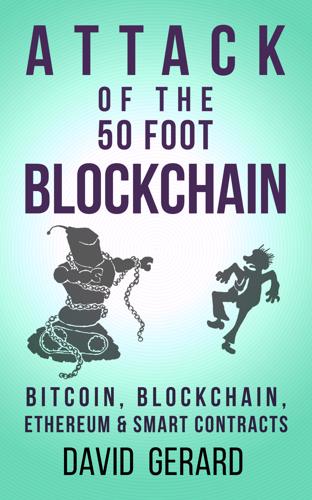
Attack of the 50 Foot Blockchain: Bitcoin, Blockchain, Ethereum & Smart Contracts
by
David Gerard
Published 23 Jul 2017
Gox.91 (He later apologised.92) Bitcoin got its first big publicity push with the announcement of version 0.3 on technology news site Slashdot on 11 July 2010.93 94 95 At this time, Jed McCaleb was a programmer at a loose end. He had previously developed eDonkey, an early file sharing network, which was shut down in late 2005 after being sued by the Recording Industry Association of America. He then went on to develop a game, The Far Wilds, leaving that to its community in 2009. McCaleb saw the Slashdot post, tried and failed to buy some bitcoins, and thought an exchange would be a good idea. (Early Bitcoin core developer Martti Malmi had an exchange site, but it wasn’t very usable.96) He had run the “Magic: The Gathering Online Exchange,” a trading site for an online card game, for a few months in 2007, using the domain name mtgox.com;97 he quickly wrote some exchange software in PHP and reused the name because his girlfriend liked it.
…
The first known conversion to conventional currency was by Martti Malmi, ardent anarcho-capitalist and Bitcoin core coder: “I sold 5,050 BTC for $5,02 on 2009-10-12.”53 The first exchange site was bitcoinmarket.com, which opened 6 February 2010. The famous first commercial transaction (two pizzas, cost $30 including tip, for 10,000 BTC54) was a few months later, on 22 May 2010.55 From there the price rose steadily to 1c in July 2010. Bitcoin version 0.3 was mentioned on 11 July by tech news site Slashdot, gaining it some notice in the technology world, and inspiring the founding of the Mt. Gox exchange. In November 2010, WikiLeaks released the US diplomatic cables dump; the site was cut off from Visa, Mastercard and PayPal shortly after at the behest of the US government, but could still receive donations in Bitcoin.
…
Gox 37, 44, 62, 82, 139 MTFLabs 132, 137 Mullins, Eustace 17, 21 Music On The Blockchain 132 MusicGlue 125 MusicTechFest 132 MyBus 75 Mycelia 129 mycrimes.txt 51 Nakamoto, Dorian 59, 60 Nakamoto, Satoshi 20, 22, 48, 59, 61, 122 Namecoin 91 NASA 105, 107 NASCAR 93 nChain 68 nCrypt 65 Netflix 130 New York Times 32, 64 Newsweek 60, 64 NHS 73, 113 Nicolle, Raphael 40, 89 nonce 14 nTrust 63 O’Hagan, Andrew 63 OKCoin 82 Open Music Initiative 134 OpenOffice 59 oracle problem 103, 117 Overstock.com 76 Palmer, Jackson 93 Paul, Ron 21, 49 PayPal 18, 28, 36, 62 PC Cyborg Trojan 72 Pedersen, Allen 66 PeerTracks 134 Pembury Tavern 79 Penn State 49 permissioned blockchain 119 Pink Floyd 132 Pirate Bay, The 92, 136 Pirateat40 37, 40, 89 police virus 72 Ponzi 30, 38, 107 PonzICO : Popper, Nathaniel 64, 141 Potter, Phil 87 praxeology 23 press.one 99 Project Black Flag 54 Proof of Elapsed Time 123 Proof of Stake 91, 94 Proof of Work 13, 91, 94, 118, 131 prosecution futures 52 provably fair gambling 39 Provenance, Inc. 116 pump-and-dump 30 quantum computer 96 R3 Blockchain Consortium 111, 123 R3 Corda 123 ransomware 69, 72 RationalWiki 141 Reason (magazine) 31 Rebit.ph 29 Recording Industry Association of America 45 Recovery Right Token 86 Reddit /r/bitcoin 38, 69, 75, 76 /r/buttcoin 143 /r/dogecoin 93 Bitfinex discussion 87 remittances 28 Revelator 135 Ripple 48 Rodrigue, Jean-Paul 36 Rogers, Benji 135 Ron, Dorit 30 Rothbard, Murray 24, 49 RRT 86 Rubixi 108 RuneScape 39 Sandifer, Phil 24 Sartre, Jean-Paul 67 SatoshiDice 111 Sawtooth Lake 123 secured by math 13, 25, 27, 57 Semetric 134 SGI 65 SGX™ 123 SHA-256 96 Shamir, Adi 30 ShapeShift 130 Shavers, Trendon 40 Sheep Marketplace 54 Shiba Inu 92 sidechains 28, 70 SiliconAngle 67 Silk Road 26, 37, 48, 64, 69 Silk Road 2.0 54 Silver, Jeremy 125 133 SingularDTV 98, 136 Singularity 137 Skunk House 71 Slashdot 36, 45 Slock.it 108 smart contract 94 SNGLS 136 SNT 98 Solarstorm 107 Solidity 106, 107, 109, 122 Sony 127 SoundExchange 126 South Sea Bubble 35 Spotify 130, 131, 137 St. Petersburg Bowl 77 Status 95, 98 Stellar 48 Stephenson, Neal 19 streaming 127 Szabo, Nick 19, 32, 59, 101, 102, 105, 107 TAO, The 135 TechUK 115 Telstra 73 Temkin, Max 75 Thiel, Peter 18 Thornburg, Jonathan 23 Tiny Human 129 Today (Radio 4) 67 Todd, Peter 59, 68 Top500 65 Tor 49, 59 Tual, Stephen 109 Tucker, Jeffrey 40 Tulip Mania 35 Tulip Trust 64 Turing completeness 107 Ujo Music 129 UK Government Office for Science 123 Ukash 73 Ulbricht, Lyn 53 Ulbricht, Ross 26, 48, 64 unbanked 29 Underhanded C Contest 106 Underhanded Solidity Coding Contest 106 Venezuela 31 Ver, Roger 17, 37, 44, 47, 48, 50 virtual reality 135 Visa 28, 36 wallet 12 Walpole, Sir Mark 123 WannaCry 73 Washington Post 32 Wells Fargo 87 Western Union 28 Westwood, Adam 64 WhollyHemp 76 WikiLeaks 36, 62 Wikimedia Foundation 76 Wikipedia 76 Wilcke, Jeffrey 94 Willybot 82 Winter Olympics 93 Wired 64 Wise, Josh 93 Wood, Gavin 94 WordPress 75 Wright Family Trust 63 Wright, Craig 61, 139 Yapizon 89 YouTube 137 Zamovskiy, Andrey 120 Zero Hedge 24 Zhoutong 83 Notes [1] Satoshi Nakamoto.

Nomad Citizenship: Free-Market Communism and the Slow-Motion General Strike
by
Eugene W. Holland
Published 1 Jan 2009
Attempts like Wikipedia to combine distributed intelligence and distrib uted sovereignty abound on the Internet. Slashdot and Kuro5hin are both cooperative online information portals (and therefore somewhat differ ent from full-fledged encyclopedias): they are designed to make breaking information—either pulled from elsewhere on the Web or written specifi cally for the sites—available to their members. Anyone can join Slashdot or Kuro5hin, although both are intended for people specifically interested and involved in Internet technology. (Slashdot presents itself as “News for Nerds. Stuff that M atters”; Kuro5hin’s declared focus is “technology and culture, from the trenches.”)
…
More recently, a Web site for free software developers called Advogato has undertaken the development of a “trust metric” that would assure a near-perfect self-mo derating process by eliminating the possibility of any one participant or group of participants unfairly distorting peer input and ratings; it remains to be seen how successful the attempt will be and how widely it will be adopted. The posting, comment, and modera tion systems used by Slashdot and Kuro5hin and proposed by Advogato may seem complicated, but the aim is to offer both open-access and highquality debate and to do so with little or no top-down interference from the editors: the sites are designed to offer a self-moderating platform for the dissemination and discussion of im portant information for specific subgroups of the Internet community. Slashdot and Kuro5hin are by no means the only sites attempting to combine distributed intelligence and distributed sovereignty by capitalizing on the ability of Internet-linked computers to collect and make use of vast amounts of information for the benefit of users.
…
Stuff that M atters”; Kuro5hin’s declared focus is “technology and culture, from the trenches.”) The two sites attempt to promote both openaccess and high-quality debate without resorting to top-down control of either content or participation. Slashdot does exercise a modicum of topdown control regarding content: its editors decide which of the hundreds of items sent to them by members each day will be posted to the homepage or one of the special-topic sections of the Web site. But the debate portion of the site is self-moderated in bottom-up fashion. Anyone (member or not) can post comments in response to an article, and moderators then rate the quality of the comments.
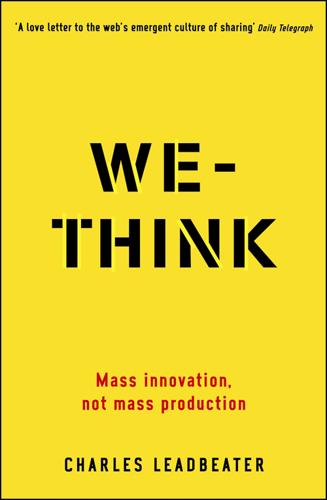
We-Think: Mass Innovation, Not Mass Production
by
Charles Leadbeater
Published 9 Dec 2010
Sites that aggregated and collated blogs were set up, such as Brigitte Eaton’s Eatonweb, which began with 50 blogs in early 1999; by 2007 it had 65,000.6 That year Technorati, the specialist blog search service, claimed to be tracking 1.6 million updates a day to 75 million blogs, and monitoring the 175,000 new blogs that were being created every day.7 Further sites such as Slashdot and Digg, Plastic and Fark aggregate and sort blogs and user contributions using tools like collaborative filters, while Trackback services allow bloggers to keep track of other blogs that are linked to their own.8 The net result is that bloggers can swarm together and produce something like shared intelligence.
…
Sites that aggregated and collated blogs were set up, such as Brigitte Eaton’s Eatonweb, which began with 50 blogs in early 1999; by 2007 it had 65,000.6 That year Technorati, the specialist blog search service, claimed to be tracking 1.6 million updates a day to 75 million blogs, and monitoring the 175,000 new blogs that were being created every day.7 Further sites such as Slashdot and Digg, Plastic and Fark aggregate and sort blogs and user contributions using tools like collaborative filters, while Trackback services allow bloggers to keep track of other blogs that are linked to their own.8 The net result is that bloggers can swarm together and produce something like shared intelligence. In 2004 a self-organised investigation by US bloggers forced a television news network to withdraw a story claiming that President George W. Bush had received preferential treatment during his military service, by showing that the documents the network had relied upon were fakes. The website Slashdot, a meeting-place for nerds and geeks, gets 3 million visitors a day, mainly people who take part in scores of self-moderated discussions.9 OhmyNews in South Korea brings together 55,000 citizen journalists to provide a news service that rivals that of traditional, mainly conservative newspapers and television stations.10 YouTube and Flickr have enabled the widespread sharing of video and photographs and allow people to rate and sort content using tags and collaborative filters.
…
We-Think takes off only by getting the right answer to each of the following questions: Who contributes? What do they contribute? Why do they do so? And how do they do it? Creative communities have a social structure. As we have seen, a relatively small, committed core group tends to do most of the heavy lifting: the discussion moderators in Slashdot; the original inhabitants of Second Life. These are the Web 2.0 aristocracy: people who because they have been around longer and done more work tend to get listened to more. There is nothing unusual in this. Most innovative projects, whether inside a company or a theatre group or a laboratory, start with intense collaboration among a small group which shares a particular passion or wants to address a common problem – as did the worm researchers who gathered around Sydney Brenner at Cambridge.13 Often, however, such communities can become closed and inward-looking.

Technical Blogging: Turn Your Expertise Into a Remarkable Online Presence
by
Antonio Cangiano
Published 15 Mar 2012
Let your readers know when an important new industry-related book has been released—even if you haven’t read it yet and therefore can’t write a full review at that point in time. One time I announced that a new edition of a book was out. I wasn’t the first to announce it, so I didn’t even promote the post (it was a heads-up for my regular readers); however, someone saw it and submitted it on Slashdot. My announcement made the frontpage of Slashdot, bringing me an unexpected few thousand dollars. Results like this are not typical, but it does happen from time to time. Beside, you are offering a very valuable service to your readers. (Feel free to use my service, http://anynewbooks.com, to discover new books in the first place.)
…
Most blogs have a comment section for this specific purpose, and that’s definitely a positive thing, as your readers will want to interact with you by leaving comments (that you will often reply to as a means of further engaging your commenters). Some readers may even contact you directly by email or link back to your post from their blogs. Other discussions about your content may pop up on sites or communities such as Twitter, Facebook,[3] Reddit,[4] Hacker News,[5] or Slashdot.[6] Thinking of blogging as a conversation can also be freeing because you don’t need to have all the answers before approaching a subject you intend to write about. You are not expected to. A blog post is a conversation starter that can lead to lengthy discussions that have the potential to spread far and wide across the Internet.
…
Footnotes [1] http://techcrunch.com, http://gizmodo.com, http://venturebeat.com, http://smashingmagazine.com, http://venturebeat.com, http://joelonsoftware.com, http://37signals.com/svn, and http://codinghorror.com/blog [2] http://tumblr.com and http://twitter.com, respectively. [3] http://facebook.com, [4] http://reddit.com [5] http://news.ycombinator.com [6] http://slashdot.org Copyright © 2012, The Pragmatic Bookshelf. Part 1 Plan It Chapter 1 What Kind of Blog Are You Going to Run? The Internet is really about highly specialized information, highly specialized targeting. Eric Schmidt The first step when beginning to plan your blog is to determine the type of blog you intend to run.

Dreaming in Code: Two Dozen Programmers, Three Years, 4,732 Bugs, and One Quest for Transcendent Software
by
Scott Rosenberg
Published 2 Jan 2006
“When you program, you spend”: Paul Graham, “The Python Paradox,” August 2004, at http://www.paulgraham.com/pypar.htm. Vaporware Hall of Fame: Jon Zilber in MacUser, January 1, 1990. Dan Gillmor’s piece: “Software Idea May Be Just Crazy Enough to Work,” San Jose Mercury News, October 20, 2002. The original Slashdot posting and discussion is at http://slashdot.org/articles/02/10/20/1827210.shtml?tid=99. Complete archives of OSAF’s mailing lists can be accessed at http://www.osafoundation.org/mailing_lists.htm. “We will first put out code”: Kapor’s blog post from November 14, 2002, is at http://blogs.osafoundation.org/mitch/000044.htm# 000044.
…
But it was enough to excite the software enthusiasts and open source devotees who noticed the announcement. The word that Mitch Kapor was working on an innovative new “interpersonal information manager” hit the geek street with a jolt. Press coverage spread out in widening circles from Gillmor’s initial piece, including a link from Slashdot, the Web’s best trafficked and noisiest virtual hangout for programmers. Hundreds of outsiders posted their views and wishes to OSAF’s newly public mailing lists. Most of the missives fell into these categories: I need Chandler immediately. Where is it? You mean you haven’t written it yet? Why aren’t you using [this or that particular] open source project as the basis for [this or that element] of Chandler?
…
Why aren’t you using [this or that particular] open source project as the basis for [this or that element] of Chandler? I will only consider using a PIM that provides this extremely specific feature that I have been using for many years and can’t live without. Outlook blows. Microsoft sucks. Slashdot’s headline, “Mitch Kapor’s Outlook-Killer,” set the tone of the publicity: Kapor was taking on Gates. Chandler would slay Outlook. Up with open source; down with Microsoft! The reaction was inevitable, but it pained Kapor. He knew that attacking Microsoft was asking for trouble—both because Microsoft’s products are so deeply entrenched and because the company has a long record of squashing competitors when it perceives a threat.

Coding Freedom: The Ethics and Aesthetics of Hacking
by
E. Gabriella Coleman
Published 25 Nov 2012
I am thrilled he decided that something dear to him would be of interest to me. And it was. I was floored to discover working alternatives to existing intellectual property instruments. After months of spending hour after hour online, week after week, reading about the flurry of exciting developments reported on Linux Weekly News, Kuro5hin, and Slashdot, it became clear to me that much more than the law was compelling about this world, and that I should turn this distractingly fascinating hobby into my dissertation topic or run the risk of never finishing graduate school. Now I not only know why Patrick was happy to have received the Slackware CD back in 1996—and I found he was not alone, because many people have told me about the joy of discovering Slackware—but also hope I can convey this passion for technology to others in the pages of this book.
…
He firmly came to believe that knowledge access and transactions of sharing facilitate production, that most types of software should be open source, and that the world would be a better place if we were just given choices for software licensing. Although not exactly motivated to engage in F/OSS production to fulfill a political mandate, he understood the political dimension of coding in an entirely new light. In fact, since reading Lawrence Lessig’s Code and Other Laws of Cyberspace, and through his daily reading of Slashdot and Boing Boing, popular Web sites reporting technology news and geek esoterica, he came to understand that code is law; code regulates behavior. But so do the copyright industries, which are using everything in their arsenal to fundamentally shape legal policy and even behavior. They suck. This chapter expands the narrative introduced above to present some consistent features of the hacker lifeworld by visiting the sites, practices, events, and technical architectures through which hackers make as well as remake themselves individually and collectively.
…
But most often when I am done with corporate software, it’s dead, and when I am done with free software, it is alive. Free Software Spreads A nascent, circumscribed political sensibility that differentiated proprietary software from F/OSS was fertilized by everyday geek news on Web-based periodicals like Linux Weekly News and Web sites such as Slashdot, which presented moral and political analyses alongside mainstream news features as well as prolific analyses about life as a coder. “Programmers started writing personally, intently, voluminously,” observes journalist Scott Rosenberg (2007, 301), “pouring out their inspirations and frustrations, their insights and tips and fears and dreams on Web sites and in blogs.

Joel on Software
by
Joel Spolsky
Published 1 Aug 2004
The thousands or millions of developer hours it takes to revise every existing device driver are going to have to come at the expense of something. And until that's done, Linux will be once again handicapped in the marketplace because it doesn't support existing hardware. Wouldn't it be better to use all that "zero cost" effort making Gnome better? Or supporting new hardware? __________ 2. Slashdot interview with Moshe Bar, June 7, 2002. See http://interviews.slashdot.org/interviews/02/06/07/1255227.shtml?tid=156. Debugged code is not free, whether proprietary or open source. Even if you don't pay cash dollars for it, it has opportunity cost, and it has time cost. There is a finite amount of volunteer programming talent available for open source work, and each open source project competes with each other open source project for the same limited programming resource, and only the sexiest projects really have more volunteer developers than they can use.
…
But you're still losing that $15,000 a day. It's a good thing you hired Jason. Jason is a 14-year-old programmer who hacked into the computers that run the factory, and believes that he has come up with a way to speed up the assembly line by a factor of two. Something about overclocking that he heard on Slashdot. And it seemed to work in a test run. There's only one thing stopping you from rolling it out. There's a teeny tiny wee little bug that causes a sandwich to be mushed once an hour or so. Jason wants to fix the wee bug. He thinks he can fix it in three days. Do you let him fix it, or do you roll out the software in its bug-addled state?
…
At the very least, Windows programmers will concede the faults of their culture and say pragmatically, "Look, if you want to sell a word processor to a lot of people, it has to run on their computers, and if that means we use the Evil Registry instead of elegant ~/.rc files to store our settings, so be it." The very fact that the UNIX world is so full of self-righteous cultural superiority, "advocacy," and Slashdot-karma-whoring sectarianism while the Windows world is more practical ("yeah, whatever, I just need to make a living here") stems from a culture that feels itself under siege, unable to break out of the server closet and hobbyist market and onto the mainstream desktop. This haughtiness-from-a-position-of-weakness is the biggest flaw of The Art of UNIX Programming, but it's not really a big flaw: On the whole, the book is so full of incredibly interesting insight into so many aspects of programming that I'm willing to hold my nose during the rare smelly ideological rants because there's so much to learn about universal ideals from the rest of the book.

Autistic Community and the Neurodiversity Movement: Stories From the Frontline
by
Steven K. Kapp
Published 19 Nov 2019
Retrieved from https://web.archive.org/web/20130401040535/ http://neurodiversity.com/weblog/article/150. 63. Slashdot. (2008, April 11). Blogger subpoenaed for criticizing trial lawyers (Newsgroup post). Retrieved from https://yro.slashdot.org/story/08/04/11/ 1812225/blogger-subpoenaed-for-criticizing-trial-lawyers. 7 Neurodiversity.Com: A Decade of Advocacy 105 64. Slashdot. (2008, April 22). Blogger successfully quashes subpoena (Newsgroup post). Retrieved from https://yro.slashdot.org/story/08/04/22/ 1939219/blogger-successfully-quashes-subpoena. 65. Slashdot. (2008, June 24). Lawyer who subpoenaed blogger Seidel sanctioned (Newsgroup post). Retrieved from https://news.slashdot.org/story/08/06/ 24/1232258/lawyer-who-subpoenaed-blogger-seidel-sanctioned. 66.
…
Barely four hours later, Shoemaker issued a subpoena for me to be deposed in Sykes v. Bayer, demanding my financial records, tax returns, information about my religious beliefs, and all correspondence about any subject discussed on Neurodiversity.com [62]. After I blogged my motion to invalidate the subpoena, all hell broke loose. Slashdot covered the case three times, nearly crashing the server with each flood of hits [63–65]. Opinionistas across the blogosphere offered their support. Attorney Paul Levy of Public Citizen submitted a brief recommending that Shoemaker be sanctioned [66]. Harvard’s Digital Media Law Project featured the case on their site [67].

Collaborative Futures
by
Mike Linksvayer
,
Michael Mandiberg
and
Mushon Zer-Aviv
Published 24 Aug 2010
Links between individual users are weak, but uncooperative tendencies are mitigated by protocols that require reciprocity or bias performance in favour of generous participants (eg BitTorrent, emule). (5) Slashdot, the technology related news and discussion site is extraordinary in not actually producing articles at all. Instead stories are submi ed by users and then filtered. Those published are either selected by paid staff, or voted on by the user-base. Following this, the stories are presented on the web page and the real business of Slashdot begins: voluminous commentary ranging from additional information on the topic covered (of varying levels of accuracy), to analysis (of various degrees of quality), to speculation (of various degrees of pertinence), taking in jokes and assorted trolling along the way.
…
These new platforms use a pleasant social terminology in an a empt to a ract more users. But this polite pale e of social interactions misses some of the key features that the pioneering systems were not afraid to use. For example, while most social networks only support binary relationships, Slashcode (the so ware that runs Slashdot.org, a pioneer of many features wrongly credited to “Web 2.0”) included a relationship model that defined friends, enemies, enemies-of-friends, etc. The reputation system on the Advogato publishing tool supported a fairly sophisticated trust metric, while most of the more contemporary blog platforms support none.
…
This miasma is then ordered by the users themselves, a changing subset of whom have powers to evaluate comments, which they assess for relevance and accuracy on a sliding scale. The number and quality of comments presented is then determined by users themselves by configuring their viewing preferences. User moderation is in turn moderated for fairness by other users, in a process known as metamoderation. In addition to the news component of the site, Slashdot also provides all users with space for a journal (which predates the blog), and tools to codify relations with other users as ‘friends’ or ‘foes’ (predating and exceeding Facebook). The system behind the site, Slashcode, is free so ware and is used by numerous other web communities of a smaller scale. (6) Vimeo, a portal for user-produced video, shelters a wide variety of subcultures/communities under one roof.

We Are the Nerds: The Birth and Tumultuous Life of Reddit, the Internet's Culture Laboratory
by
Christine Lagorio-Chafkin
Published 1 Oct 2018
Huffman had the distinct impression that Graham disliked the way comments worked on competing sites, such as Slashdot, and wouldn’t welcome them on Reddit. Spolsky joined that camp, telling Huffman that he didn’t think comments worked well anywhere on the Internet; they were a write-only medium, meaning, individuals loved to type in their thoughts the same way they loved to hear themselves speak. His conclusion: “Comments are going to ruin Reddit.” Huffman, though, had already made up his mind. At the time, Slashdot’s comments relied on an intricate moderator-based system for ranking and displaying comments, in order from best to worst.
…
It was too early to be focused completely on mobile development. Few people were yet using their cell phones for much Internet browsing. Text messaging and BlackBerry Messenger were still in their infancy. Graham had an entirely different sort of Internet business in mind. You know who was on to something, Graham mused: Slashdot. He pulled up the site and showed the young men its trove of interesting but somewhat mainstream tech-centric links. There was also, similarly, Delicious (known often by its curious domain name, del.icio.us), a site many people used to bookmark their favorite websites and articles, or find topical content, based on freeform hashtags suggested by users.
…
He knew what he wanted: a way for users to submit links, and to give a virtual thumbs-up to content they enjoyed with a single click. That click, or an upvote, would help Reddit rank its homepage—the most interesting, most upvoted stuff would rise to the top. It would be a massively collaborative content popularity contest and key to their model. Their competitors, Delicious and Slashdot, constantly refreshed their “popular” pages; Reddit’s homepage would only be a “popular” page. Also scribbled in Huffman’s notebook was the word “karma.” Huffman and Ohanian had concocted another secret sauce. They’d give readers feel-good points that would accrue with every activity they partook in on Reddit.

Layered Money: From Gold and Dollars to Bitcoin and Central Bank Digital Currencies
by
Nik Bhatia
Published 18 Jan 2021
The highly publicized, earliest Bitcoin transaction occurred when in May 2010, one Bitcoin software developer paid an online acquaintance 10,000 BTC for a $25 Papa John’s pizza order, equating to a BTC/USD price of $0.0025. The transaction valued the total market value of BTC at approximately $7,000.25 On February 10, 2011, the tech blog Slashdot posted an article titled “Online-Only Currency Bitcoin Reaches Dollar Parity.” Because of Slashdot’s popularity among software engineers, many early Bitcoin adopters reference this specific article as the moment they first heard about Bitcoin. After this first slice of internet publicity, barely two years into the project, Bitcoin started to gain serious popularity and attention.

Too Big to Know: Rethinking Knowledge Now That the Facts Aren't the Facts, Experts Are Everywhere, and the Smartest Person in the Room Is the Room
by
David Weinberger
Published 14 Jul 2011
From this have come new lines of business—created out of a stew in which the beef, peas, and carrots all have the same rank. “Other”-credentialed. At the tech-geek site Slashdot.com (its motto is “News for Nerds”), you’ll find rapid bursts of argumentation on the geeky news of the day. To cite your credentials generally would count against you, and if you don’t know what you’re talking about, a credential would do you no good. At Slashdot, a slash-and-burn sense of humor counts for more than a degree from Carnegie Mellon. Unsettled. We used to rely on experts to have decisive answers. It is thus surprising that in some branches of biology, rather than arguing to a conclusion about how to classify organisms, a new strategy has emerged to enable scientists to make progress together even while in fundamental disagreement.
…
One guess at the number of developers who worked on Windows 7 is 1,000, based on a post by Steve Sinofsky at the “Engineering Windows 7” blog on August 17, 2008 (http://blogs.msdn.com/b/e7/archive/2008/08/18/windows_5f00_7_5f00_team.aspx). But it is extremely difficult to do an apples-to-apples comparison, so to speak. 17 Eric Steven Raymond, “The Cathedral and the Bazaar,” http://catb.org/~esr/writings/homesteading (May 1997). Raymond later published a book by the same name. 18 “The Scalability of Linus,” Slashdot, July 23, 2010, http://linux.slashdot.org/story/10/07/23/123209/The-Scalability-of-Linus? 19 See http://www.debian.org/devel/constitution as well as Mathieu O’Neil, Cyberchiefs: Autonomy and Authority in Online Tribes (Pluto Press, 2009), p. 132. 20 O’Neil, Cyberchiefs. 21 Interview with Noel Dickover, February 25, 2011. 22 See http://www.fantasypumpkins.com/. 23 Peter J.
…
See also Books and book publishing Paper-based tools Parenting experts Patent Office, US PatientsLikeMe.com Pavement performance Peer-review journals Perception, facts and Permission-free knowledge Philosophy defining and quantifying knowledge information overload reality unresolved knowledge Pinker, Steven Planetary Skin initiative Plato PLoS One online journal Pogue, David Polio vaccine Politics Politifact.com Popper, Karl Population growth, Malthusian theory of Pornography Postmodernism Pragmatism PressThink.org Primary Insight Principles of Geology (Lyell) Prize4Life Protein folding ProteomeCommons.org Pseudo-science Public Library of Science (PLoS) Punchcard data Pyramid, knowledge Pyramid of organizational efficiency Quora Racial/ethnic identity Ramanujan, Srinivasa RAND Corporation Random Hacks of Kindness Rauscher, Francis Raymond, Eric Reagan, Ronald Reality Reason as the path to truth and knowledge critical debate on unresolved knowledge Reliability Repositories, open access Republic of Letters Republican Party Republic.com (Sunstein) Revolution in the Middle East Rheingold, Howard Richards, Ellen Swallow Riesman, David Robustness “The Rock” (Eliot) Rogers, William Rorty, Richard Rosen, Jay Roskam, Peter Rushkoff, Douglas Russia: Dogger Bank Incident Salk, Jonas Sanger, Larry Schmidt, Michael School shootings Science amateurs in crowdsourcing expertise failures in goals of hyperlinked inflation of scientific studies interdisciplinary approaches media relations Net-based inquiry open filtering journal articles open-notebook overgeneration of scientific facts philosophical and professional differences among scientists public and private realms scientific journals transformation of scientific knowledge Science at Creative Commons Science journal Scientific journals Scientific management Scientific method Self-interest: fact-based knowledge Semantic Web Seneca Sensory overload Sexual behavior The Shallows (Carr) Shapiro, Jesse Shared experiences Shilts, Randy Shirky, Clay Shoemaker, Carolyn Simplicity in scientific thought Simulation of physical interactions Slashdot.com Sloan Digital Sky Survey Smart mobs “Smarter planet” initiative Smith, Arfon Smith, Richard Soccer Social conformity Social networks crowdsourcing expertise Middle East revolutions pooling expertise scaling social filtering Social policy: social role of facts Social reform Dickens’s antipathy to fact-based knowledge global statistical support for Bentham’s ideas Social tools: information overload Society of Professional Journalists Socrates Software defaults Software development, contests for Sotomayor, Sonia Source transparency Space Shuttle disaster Spiro, Mary Sports Sprinkle, Annie Standpoint transparency Statistics emergence of Hunch.com Stopping points for knowledge The Structure of Scientific Revolutions (Kuhn) Stupidity, Net increasing Sub-networks Suel, Gurol Sunlight Foundation Sunstein, Cass Surowiecki, James Systems biology Tag cloud Tagging Tatalias, Jean Taylor, Frederick Wilson TechCamps Technodeterminism Technology easing information overload Technorati.com Television, homophily and Temptation of hyperlinks Think tanks Thoreau, Henry David The Tipping Point (Gladwell) Todd, Mac Toffler, Alvin TopCopder Topic-based expertise Torvalds, Linus Traditional knowledge Tranche Transparency hyperlinks contributing to objectivity and of the Net Open Government Initiative Transparency and Open Government project Triangular knowledge Trillin, Calvin Trust: reliability of information Trust-through-authority system Truth elements of knowledge reason as the path to value of networked knowledge Twitter Tyme, Mae Unnailing facts Updike, John USAID UsefulChem notebook Vaccinations Verizon Vietnam Virginia Polytechnic Institute and State University Wales, Jimmy Wallace, Alfred Russel Walter, Skip Washington Post Watson, James Welch, Jack Welfare The WELL (The Whole Earth’Lectronic Link) Whole Earth Catalog Wikipedia editorial policy LA Times wikitorial experiment policymaking Virginia Tech shootings Wikswo, John Wilbanks, John Wired magazine The Wisdom of Crowds (Surowiecki) Wise crowds Wittgenstein, Ludwig Wolfram, Stephen WolframAlpha.com World Bank World Cup World War I Wurman, Richard Saul Wycliffe, John York, Jillian YourEncore Zappa, Frank Zeleny, Milan Zettabyte Zittrain, Jonathan Zuckerman, Ethan a I’m leaving this as an unsupported idea because it’s not the point of this book.
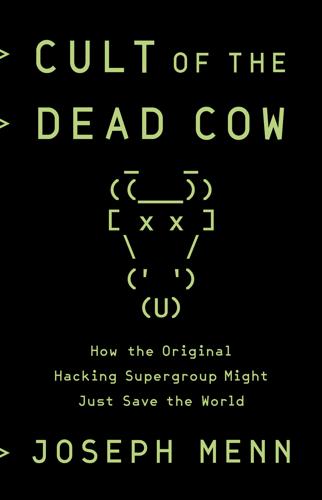
Cult of the Dead Cow: How the Original Hacking Supergroup Might Just Save the World
by
Joseph Menn
Published 3 Jun 2019
“One Lockheed Martin expert wrote to a security mailing list”: The email went to subscribers of the list called NTBugtraq. “Carrie wanted to help Microsoft do better”: My sources for this anecdote are Carrie and Beck. “the leading tech discussion site Slashdot”: “Bizarre Answers from Cult of the Dead Cow,” Slashdot, October 22, 1999, https://news.slashdot.org/story/99/10/22/1157259/bizzare-answers-from-cult-of-the-dead-cow. Chapter 7: Oxblood “John Lester’s personal account”: Count Zero, “HoHoCon 1994… The Insanity Continues,” January 6, 1995, www.cultdeadcow.com/oldskool/HoHo94.html. “Laird said he was working for a not-for-profit”: He later told me he had been volunteering at the Toronto group Web Networks, which built websites for progressive groups, native tribes, and government agencies, and supported himself with other jobs on the side.
…
Security budgets rose across the industry as companies spent more on deeper security research and bought firewalls and intrusion-detection systems. Pulling off feats like the Orifice launches two years in a row cemented cDc’s position in security culture as the internet boom was peaking. In a format later adopted by Reddit for its AMAs, the leading tech-discussion site Slashdot arranged that fall for cDc to answer reader questions under their various handles. Amid a lot of joking and posed crudeness, they articulated quite a few beliefs and goals for security that had many tech-industry readers nodding. They especially wanted software companies to put more thought, effort, and money into user safety and privacy, even if they did not consider themselves to be in the security business.
…
See Monsegur, Hector Sadofsky, Jason Scott, 38, 46–47, 58–59, 67, 69 Salon (online magazine), 151 San Antonio Express-News, 60 Sandberg, Sheryl, 200 San Francisco, California, 1–8, 22, 30, 65, 113, 123, 128, 155, 186 satellite communications, 61, 93, 95, 131, 177 Schneier, Bruce, 82–83, 155, 210 script kiddies, 64, 83, 122 secrecy, role of, 117–120, 134, 145, 171, 196 WikiLeaks, 142–151, 155–156, 158–159, 163, 166, 169–170, 192 “Secrets of the Little Blue Box” (Rosenbaum), 18 Secure Sockets Layer encryption, 127 security, 3–5, 43, 51, 84, 136, 182–184, 199 advisories to public, 56–57, 59, 61, 72–74, 108–110, 113, 193, 197 consulting, 56, 109–111 industry, 29–30, 79–80, 85, 171, 177–180, 197 self-driving car technology, 7, 175, 178, 186–187 Sendmail, 48, 56 Setec Astronomy, 65 sexism, in tech world, 158, 170, 193–194 sexual misconduct, in tech world, 150, 152–156, 193 Shadow Brokers, 167 Shea, Dylan (FreqOut), 49, 65 Sid Vicious. See Brewer, Brandon Signal, 152, 162, 171, 178 Silicon Valley, 3–4, 37, 121, 130, 133, 184–185, 191–192, 201–202 Sir Dystic (Josh Buchbinder), 63–68, 78, 81, 93, 186 Six/Four System, 128–129, 162 Slack, 193 Slashdot, 84 Slick, Grace, 22 smartphones, 124, 130–131, 163, 178 Smith, Val, 121, 177–178 Sneakers (film), 65, 109 Snowden, Edward, 138, 167, 172, 177, 181–182, 211 contents of leak, 4, 120, 137, 139, 151, 172 Freedom of the Press Foundation, 150–151, 155 ramifications of leak, 122, 153, 161, 196–198 Snyder, Window (Rosie the Riveter), 49–50, 63, 110–111, 121–123, 171 social engineering, 35, 141, 153 social media, 6, 192–195, 203 Facebook, 4–6, 152, 157–158, 190–196, 198–201, 211 Instagram, 192, 199–200 See also Twitter software, pirated, 15–16, 21, 30, 54, 68, 121 software flaws.

Designing Social Interfaces
by
Christian Crumlish
and
Erin Malone
Published 30 Sep 2009
Figure 15-5. At Slashdot, only comments above a rating threshold are displayed automatically in the thread. A reader can still expand a hidden comment to read it, or change her preferences to move the threshold. Why The collective wisdom of the community can help filter out the best contributions and conversations. Related patterns “Reputation Influences Behavior” on page 154 “Thumbs Up/Down Ratings” on page 269 “Vote to Promote” on page 266 Download at WoweBook.Com 394 Chapter 15: Good Cop, Bad Cop As seen on Kuro5hin (http://www.kuro5hin.org/) Slashdot (http://slashdot.org/) Yahoo! Answers (http://answers.yahoo.com/) Report Abuse What Any active, successful social system online is subject to abuse.
…
They have learned to share sophisticated tools (like breaking captcha) so effectively the pros and the least sophisticated script-kiddies are no longer two separate groups. The good news is that there is a better way, but it requires a totally new and fresh approach. In particular, I’ve become a true believer in community-moderation and collaborative filtering, after seeing the success of schemes like those of Y! Answers and Slashdot. What these successful sites are doing in essence is empowering their (good) users to take ownership of the abuse and qualitylevel goals. They create strong incentives for good users to put an effort into moderating the sites. Users who consistently exhibit good judgments and willingness to contribute, get “strength points” making them more and more powerful in the never ending game of stamping-out abuse.
…
As well, if your product or idea is just bad, and you still need to get the word out, do what people in your situation have been doing for years: spend a great deal of money marketing it. Community is precious, and it’s great when it works, but it’s not viral marketing. —Robyn Tippins, Yahoo! Developer Network, http://developer.yahoo.com Collaborative Filtering What People need help finding the best contributions to online community (Figure 15-4). Figure 15-4. Slashdot popularized the idea of harnessing the preferences of the site’s readership to vote articles up or down and (in theory) bring the highest-quality articles and comments to the surface while burying the worst. Download at WoweBook.Com Group Moderation 393 Use when Use this pattern when you have a large base of contributors and a wide range of quality.

Digital Wars: Apple, Google, Microsoft and the Battle for the Internet
by
Charles Arthur
Published 3 Mar 2012
Yet, if Jobs had been expecting a rapturous reception from the technical press for the iPod’s design, he may have been disappointed. Hard-core technologists weren’t positive. The response by CmdrTaco – real name Rob Malda – head of the ‘news for nerds’ site Slashdot, then one of the most influential technology discussion sites, was typical: ‘No wireless. Less space than a Nomad. Lame.’6 Yet Slashdot denizens liked the idea of an ultraportable hard drive that could boot a Mac. Some began seeing iPods as a futuristic personal computer that would store your personal data in your pocket and plug in to any computer you liked and work with it – as long as the computer was a Mac, of course, though some geeks were considering whether they could reformat the disk to a Windows version.
…
Universal didn’t re-sign the contract – but the songs remained available on an ‘as is’ basis.) Word about the project started leaking out in June. Because it included Wi-Fi, an application for compliance testing had to be filed in August 2006 with the US Federal Communications Commission (FCC), where reporters immediately picked up on it. On Slashdot, news of the device’s capabilities earned the ironic comment: ‘Wireless. More space than a Nomad. Lame.’33 Technology reviewers liked some of the ideas of the Zune, but were dubious about its colour – brown – and limitations. The sharing limits in particular struck many as peculiar. Despite the undercurrents of unease – and the fact that Apple had sold more than 8 million iPods in each of the first three quarters of 2006– Allard sought to rally the troops.
…
atype=tp 42 http://www.businessinsider.com/microsoft-bing-losing-billions-2011-4 43 http://www.businessinsider.com/henry-blodget-bing-revisited-still-toast-but-slightly-less-burnt-2010-3 44 http://press.nokia.com/2011/04/21/nokia-and-microsoft-sign-definitive-agreement-ahead-of-schedule/ 45 http://money.cnn.com/magazines/fortune/fortune_archive/2005/05/02/8258478/index.htm 46 http://www.nytimes.com/2006/12/09/technology/09msn.html Chapter Four Digital music: Apple versus Microsoft 1 http://www.theregister.co.uk/2000/12/06/apple_to_fall_into/ 2 Walter Isaacson (2011) Steve Jobs, Little, Brown, London. 3 Private conversation with Gayle Laakmann. 4 http://www.wired.com/gadgets/mac/commentary/cultofmac/2006/10/71956?currentPage=all 5 http://www.youtube.com/watch?v=kN0SVBCJqLs 6 http://slashdot.org/story/01/10/23/1816257/Apple-releases-iPod 7 http://news.cnet.com/Apples-iPod-spurs-mixed-reactions/2100-1040_3-274821.html 8 Private conversation with Paul Griffin. 9 http://www.apple.com/pr/library/2002/jan/16results.html 10 Private conversation with Bob Ohlweiler. 11 http://www.wired.com/wired/archive/4.02/jobs_pr.html 12 http://www.macobserver.com/tmo/article/A_Few_Of_Her_Favorite_Things_Oprah_Gives_iPods_To_Everyone_In_Audience/ 13 Private conversation with Don Norman. 14 http://www.thesun.co.uk/sol/homepage/showbiz/bizarre/165843/iCant-believe-Geri-hasntBRgot-an-iPod.html 15 http://money.cnn.com/magazines/fortune/fortune_archive/2003/05/12/342289/index.htm 16 http://www.microsoft.com/presspass/features/2003/oct03/10-15MusicServices.mspx 17 http://www.guardian.co.uk/uk/2003/dec/14/gadgets.christmas 18 http://www.youtube.com/watch?

Engineering Security
by
Peter Gutmann
References 645 [204] Miller Smiles scam report 5864-78694-286039, 19 November 2009, http://www.millersmiles.co.uk/report/12818. [205] Miller Smiles scam report 5941-79445-287373, 22 November 2009, http://www.millersmiles.co.uk/report/12885. [206] Miller Smiles scam report 6283-84449-295388, 6 December 2009, http://www.millersmiles.co.uk/report/13171. [207] Miller Smiles scam report 6286-84510-295482, 7 December 2009, http://www.millersmiles.co.uk/report/13174. [208] Miller Smiles scam report 6429-86374-298493, 12 December 2009, http://www.millersmiles.co.uk/report/13302. [209] “3DS is also broken from a human factors POV”, ‘gilgongo’, 28 January 2010, http://news.slashdot.org/comments.pl?sid=1528586&no_d2=1&cid=30943342. [210] “Not only insecure, WORTHLESS”, ‘macbuzz01’, 28 January 2010, [211] [212] [213] [214] http://news.slashdot.org/comments.pl?sid=1528586&no_d2=1&cid=30944372. “Re:Lol”, ‘tatsuyame’, 28 January 2010, http://news.slashdot.org/comments.pl?sid=1528586&no_d2=1&cid=30939322. “Re:Lol”, ‘Kamokazi’, 28 January 2010, http://news.slashdot.org/comments.pl?sid=1528586&no_d2=1&cid=30939456. “Re:Lol”, ‘Lord Byron II’, 28 January 2010, http://news.slashdot.org/comments.pl?sid=1528586&no_d2=1&cid=30940032.
…
Designing for evil requires asking yourself the question “what if some of my users are evil?” [1]. Slashdot’s reputation-based posting mechanism, which filters out spammers and other nuisance posters, is a good example of designing for evil (on the other hand this kind of social-rating system can be defeated if the stakes are high enough, as has been demonstrated on eBay where cybercriminals bypass the reputation-based rating system either indirectly using cliques and stolen credit cards to inflate their feedback ratings or directly by buying highly-rated accounts from phishers). Slashdot also uses a few other tricks like randomisation, allocating the ability to rate other people’s posts on a random basis, which makes it much harder to game than other reputation-based sites.
…
An example of this type of behaviour is shown in Figure 143, in which the TargetAlert plugin for the Mozilla web browser is indicating that clicking on the link will cause the browser to hang while it loads the Adobe Acrobat plugin. TargetAlert has other indicators to warn the user about links that are executable, pop up new windows, execute Javascript, and so on [78]. Figure 144: Slashdot displaying the true destination of a link A variation of this technique is used by the Slashdot web site to prevent link spoofing, in which a link that appears to lead to a particular web site instead leads to a completely different one. This measure, shown in Figure 144, was introduced to counter the widespread practice of having a link to a supposedly informational site lead instead to the (now-defunct) goatse.cx, a site that may euphemistically be described as “not work-safe”, the Internet equivalent of a whoopee cushion.
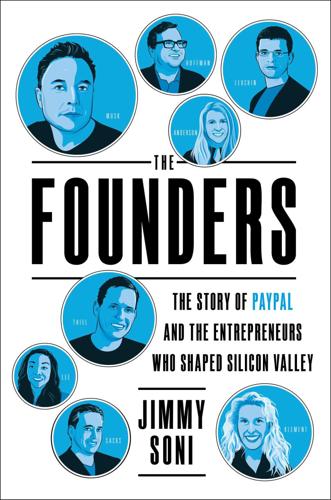
The Founders: The Story of Paypal and the Entrepreneurs Who Shaped Silicon Valley
by
Jimmy Soni
Published 22 Feb 2022
“It’s kind of funny in retrospect because we didn’t know anything about payments… we had never written code that had interacted with a database.… We didn’t know well enough to know that we should be more intimidated by the problem,” Simmons said. As news of PalmPilot money beaming made its way onto technology forums like Slashdot, the company faced its first set of critics. One Slashdot poster wrote a post about the technology, bracingly titled “What an amazingly bad idea”: Bad idea becauses there’s at least three points at which to break in and subvert the system. On the IR level, such as copying someone’s transaction from a distance. At the software level, such as getting a legit payment, then hacking the software on the Palm to up the amount by a large number.
…
Probably vaporware anyway. Slashdot’s tech-savvy users were sharply—and often comically—critical. One commenter wrote an “Extract From Galactic Encyclopedia, May 2010,” describing robberies of the future “And from that point on, robbers had PalmPilots in their equipment, along with switchblades and guns. When they robbed somebody, their usual words were: ‘point your Pilot to mine and beam all your money and nobody gets hurt.’ ” The team hustled to write a technical FAQ, in which they acknowledged the criticism: “Was this technical FAQ created in response to the postings on Slashdot?” Their response: “Yes.
…
“For as much as people”: Author interview with Giacomo DiGrigoli, December 9, 2020. “We worked”: Author interview with Max Levchin, June 29, 2018. “None of us”: Author interview with Erik Klein, April 25, 2021. “It’s kind of funny”: Author interview with Russel Simmons, August 24, 2018. “What an amazingly”… “nobody gets hurt”: SlashDot thread “Beaming Money,” July 27, 1999, https://slashdot.org/story/99/07/27/1754207/beaming-money#comments. “Was this technical FAQ”: FAQ section of paypal.com website, October 12, 1999, accessed through Internet Archive paypal.com/FAQ.HTML. “If you’re an engineer”: Author interview with Max Levchin, June 29, 2018. “After Peter had”: Author interview with David Wallace, December 5, 2020.
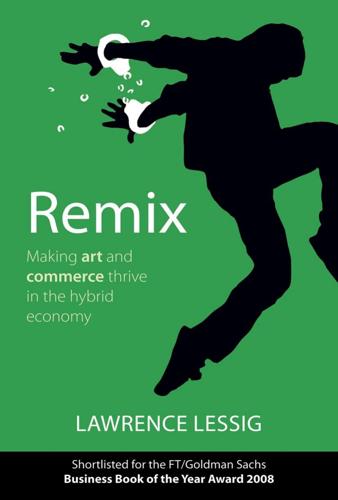
Remix: Making Art and Commerce Thrive in the Hybrid Economy
by
Lawrence Lessig
Published 2 Jan 2009
Nothing confidential would be shared, but the community could be drawn upon to help this journalist produce good work. And not just good work. Politech members gather for dinners in big cities. McCullagh connects with them as he travels. The site thus spawned a community—and not just one community. As McCullagh told me as we ended our interview, “Oh, I should say: I met my wife through the list.” Slashdot Slashdot began in September 1997 as a Web site covering technologyrelated news. Its angle, however, was a technology that enabled users to both comment upon the articles that got referenced, and comment upon the comments. The consequence of the second set of comments would be to filter out comments not thought useful.
…
That meant the site could self-edit, and hence present to any reader 80706 i-xxiv 001-328 r4nk.indd 198 8/12/08 1:55:43 AM H Y BRID EC O NO MIE S 199 a high-quality public debate about issues important to the technology community. Today there are more than a quarter million people collaborating in just this way on Slashdot.30 Their work—work they don’t get paid for, don’t even get frequent-flier miles for—produced a site worth millions of dollars. In 1999, Slashdot was sold to Andover .net, and ads were added to the layout. So readers edit, and readers and Andover.net then profit. Collaboration here winnows a potentially endless array of comments to a relative few that people reading the site would or should want to see.
…
K., 206 RW (Read/Write) culture, 28–29, 33, 34–35, 50, 51–83, 116, 252, 253, 274 copyright law and, 97, 100–105, 108 economic value promoted by, 88–90 importance and value of, 106–8 media in, 68–83 RO culture compared with, 84–114 text in, 57–68, 69 value of works created in, 90–97 values and, 85–88 Sadler, Sim, 72–73 Safari Books Online, 235–36 sampling, 53–54, 104, 273 San Francisco Chronicle, 190 Sanger, Larry, 156, 157 Saturday Night Live, 227–28 Scherf, Steve, 237–28 Scholastic, 206 Second Life, 213, 214–20, 236 Sefton-Green, Julia, 78 segregation, 257–58 SETI, 167 Sendmail, 163–64 sharecropping, 243–48 sharing economies, 116, 118–19, 143–76, 177, 223 commercial economies and, 145–51, 177–78, 225–26, 252 crossovers and, 227–28 hybrid economies and, 177–78, 225; see also hybrid economies on Internet, 119, 155–72 motivations for participation in, 151–54, 172–76, 291 parallel economies and, 225–26 thick, 152, 154 thin, 152–54 tools signaling, 226–27 Sherman, Cary, 114 Shuttleworth, Mark, 184–85 SilviaO, 15–17, 95 Sims, Charles, 91–92, 93, 95 8/12/08 1:56:33 AM 326 IND E X Six Apart, 233 Skype, 153 slander, 275 Slashdot, 198–99 Smith, Adam, 49–50 Smith, Marc, 201–2 Söderberg, Johan, 70, 73, 75, 273 software, 221 free and open-source, 163–66, 172, 173–75, 179–85, 219, 220, 240–43, 291 Sony, xxi, 2, 10, 40, 102, 241, 244, 249 Sousa, John Philip, 23–29, 31–33, 35, 36, 50, 56, 82, 132, 254, 280 Southwestern Bell, 181–82 spam, 58 Spears, Britney, 95–96 spillovers, 229–31 Stallman, Richard, 157, 163, 179, 182, 183 Star Wars, 245–46, 247 Sterling, Thomas, 180 stock markets, 152–53, 154 Stone, Victor, 75, 97 Success of Open Source, The (Weber), 174–75 Sun Microsystems, 181, 232 Sunstein, Cass, 126 Supreme Court, U.S., 102, 110, 123, 225, 291–92 MGM v.

Toast
by
Stross, Charles
Published 1 Jan 2002
Manfred takes it and heads for the back of the split-level bar, up the steps to a table where some guy with greasy dreadlocks is talking to a suit from Paris. The hanger-on at the bar notices him for the first time, staring with suddenly wide eyes: nearly spills his coke in a mad rush for the door. Oh shit, thinks Manfred, better buy some more server PIPS. He can recognize the signs: he's about to be slashdotted. He gestures at the table: “this one taken?” Be my guest,” says the guy with the dreads. Manfred slides the chair open then realises that the other guy -- immaculate double-breasted suit, sober tie, crew-cut -- is a girl. Mr Dreadlock nods. “You're Macx? I figured it was about time we met.” “Sure.”
…
Just then a bandwidth load as heavy as a pregnant elephant sits down on Manfred's head and sends clumps of humongous pixellation flickering across his sensorium: around the world five million or so geeks are bouncing on his home site, a digital flash crowd alerted by a posting from the other side of the bar. Manfred winces. “I really came here to talk about the economic exploitation of space travel, but I've just been slashdotted. Mind if I just sit and drink until it wears off?” “Sure, man.” Bob waves at the bar. “More of the same all round!” At the next table a person with make-up and long hair who's wearing a dress -- Manfred doesn't want to speculate about the gender of these crazy mixed-up Euros -- is reminiscing about wiring the fleshpots of Tehran for cybersex.
…
Another fourteen months and the larger part of the cumulative conscious processing power of the human species will be arriving in silicon. And the first meat the new AI's get to know will be the uploaded lobsters. Manfred stumbles back to his hotel, bone-weary and jet-lagged; his glasses are still jerking, slashdotted to hell and back by geeks piggybacking on his call to dismantle the moon. They stutter quiet suggestions at his peripheral vision; fractal cloud-witches ghost across the face of the moon as the last huge Airbuses of the night rumble past overhead. Manfred's skin crawls, grime embedded in his clothing from three days of continuous wear.

Lurking: How a Person Became a User
by
Joanne McNeil
Published 25 Feb 2020
For years, I could have sworn HotBot had the most relevant results, and I was surprised to learn many, many years later that it was only the skin for search that the Inktomi database provided. In addition to the Lycos and Yahoo model of directories, there was a user-sorted directory called DMOZ, which shut down in 2017. Slashdot noted that the “site was so old that its hierarchical categories were originally based on the hierarchy of Usenet newsgroups” (“After 19 Years, DMOZ Will Close, Announces AOL,” Slashdot, March 4, 2017). Mark Hansen and Ben Rubin’s installation Listening Post was first presented at Brooklyn Academy of Music in December 2001. Rubin has a video clip on his Vimeo page. On YouTube, one might find a 2006 user-created video depicting a screen broadcasting live search results.
…
Indymedia, a collectively authored platform that spun out from the 1999 “Battle of Seattle” WTO protests, operated as a major online hub for activism for a decade, prioritizing information on local events and on-the-ground reporting. Contributors often uploaded video footage or reports about a protest while it was under way, bypassing the approval process and time delays that slowed down traditional publications. The Indymedia interface resembled other collective publishing platforms like Slashdot, where users could submit stories and comment on them. MetaFilter, also known as the “blue,” for its deep cerulean background (HEX color #006699, to be exact), did not look like the other collectively authored blogs. Its emphasis on brief setups to provide context for the links shared, followed by sarcasm and banter from the community, predated the kind of collective joshing that happens on Twitter nowadays.
…
This process mitigates the openness of the Reddit channel, and while it does not perfectly prevent trolling on Discord, it is manageable. Diverse as its communities are today, Lo thinks of Reddit as inheriting “forum dwelling behavior.” The culture on this platform was set by “young white men who were already on forums.” These first users had plenty of alternatives when Reddit launched; there was already Digg, Slashdot, and Something Awful—all built for a certain sort of online guy. But these “forum dwellers” preferred Reddit, and their loyalty is what brought other communities along to create their own subreddits. In Lo’s words, Reddit has “idiot libertarian” founding principles; it did nothing to improve the diversity of its users; it did nothing special for them at all—it was just easy for everyone to use.

The Future of the Internet: And How to Stop It
by
Jonathan Zittrain
Published 27 May 2009
, NEW YORKER (July 21, 2006), available at http://www.newyorker.com/archive/2006/07/31/060731fa_fact. 24. Wikipedia, Nupedia, http://en.wikipedia.org/wiki/Nupedia (as of Apr. 30, 2007, 18:01 GMT). 25. Id. 26. Nupedia, The Free Encyclopedia, http://nupedia.8media.org (last visited June 1, 2007). 27. Posting of Timothy to Slashdot, The Early History of Nupedia and Wikipedia: A Memoir, http://features.slashdot.org/features/05/04/18/164213.shtml (Apr. 18, 2005, updated Apr. 20, 2005 19:19 GMT). 28. Also known as the “robustness principle.” See INFO. SEI. INST., UNIV. OF S. CAL., TRANSMISSION CONTROL PROTOCOL: DARPA INTERNET PROGRAM PROTOCOL SPECIFICATION (Jon Postel ed., Sept. 1981), available at http//rfc.sunsite.dk/rfc/rfc793.html. 29.
…
See FCC, Memorandum Opinion and Order in re Cablevision Systems Corporation’s Request for Waiver of Section 76.1204(a)(1) (Jan. 10, 2007), available at http://hraunfoss.fcc.gov/edocs_public/attachmatch/DA-07-48A1.pdf; FCC, Memorandum Opinion and Order in re Bend Cable Communications, LLC Request for Waiver of Section 76.1204(a)(1) (Jan. 10, 2007), available at http://hraunfoss.fcc.gov/edocs_public/attachmatch/DA-07-47A1.pdf However, others have been denied. FCC, Memorandum Opinion and Order in re Comcast Corporation, LLC Request for Waiver of Section 76.1204(a)(1) (Jan. 10, 2007), available at http://hraunfoss.fcc.gov/edocs_public/attachmatch/DA-07-49A1.pdf; Posting of Cowboy Neal to Slashdot, FCC Opens Market for Cable Boxes (Jan. 11, 2007, 21:51), http://hardware.slashdot.org/article.pl?sid=07/01/12/0043249. See Press Release, FCC, Media Bureau Acts on Requests for Waiver of Rules on Integrated Set-Top Boxes and Clarifies Compliance of Downloadable Conditional Access Security Solution (Jan. 10, 2007), available at http://hraunfoss.fcc.gov/edocs_public/attachmatch/DOC-269446A1.pdf, for information regarding decisions on integrated boxes, and Todd Spangler, FCC: Set-Top Fines Capped at $325K, MULTICHANNEL NEWS, Feb. 15, 2007, http://www.multichannel.com/article/CA6416753.html, for general information about the rulings. 29.
…
Search engines can also more explicitly invite the public to express its views on the items it ranks, so that users can decide what to view or buy on the basis of others’ opinions. Amazon users can rate and review the items for sale, and subsequent users then rate the first users’ reviews. Sites like Digg and Reddit invite users to vote for stories and articles they like, and tech news site Slashdot employs a rating system so complex that it attracts much academic attention.87 eBay uses reputation to help shoppers find trustworthy sellers. eBay users rate each others’ transactions, and this trail of ratings then informs future buyers how much to trust repeat sellers. These rating systems are crude but powerful.

Convergence Culture: Where Old and New Media Collide
by
Henry Jenkins
Published 31 Jul 2006
The idea of reader-moderated news content is not new. Slashdot was one of the first sites to experiment w i t h user-moderation, gathering a wealth of information w i t h a five-person paid staff, mostly part time, b y empowering readers not only to submit their o w n stories but to w o r k collectively to determine the relative value of each submission. Slashdot's focus is explicitly on technology and culture, and so it became a focal point for information about Internet privacy issues, the debates over mandatory filters i n public libraries, the open source movement, and so forth. Slashdot attracts an estimated 1.1 million unique users per month, and some 250,000 per day, constituting a user base as large as that of many of the nation's leading online general 1 240 Skenovâno pro studijni ucely Conclusion interest and technology-centered news sites.
…
Slashdot attracts an estimated 1.1 million unique users per month, and some 250,000 per day, constituting a user base as large as that of many of the nation's leading online general 1 240 Skenovâno pro studijni ucely Conclusion interest and technology-centered news sites. Yet, this w o u l d be the first time that something like the Slashdot model was being applied to television. Even before the network reached the air, Current's promise to "democratize television" became a focal point for debates about the p o l i tics of participation. Cara Mertes, the executive producer for the PBS documentary program POV, itself an icon of the struggle to get alternative perspectives on television, asked, "What are y o u talking about when you say 'democratizing the media'?
…
A12. Notes to the Conclusion 1. A r i Berman, " A l Gets D o w n , " The Nation, A p r i l 28, 2005, h t t p : / / w w w . t h e nation.com/doc.mhtml?i=20050516&c=l&s=berman. 2. See A n i t a J. C h a n , "Distributed Editing, Collective A c t i o n , and the C o n struction of Online N e w s on Slashdot.org," Masters thesis, Comparative M e d i a Studies Program, MIT, Cambridge, Mass., 2002. For more on participatory journalism, see D a n G i l m o r , We the Media: Grassroots Journalism By the People, For the People (New York: O'Reilly, 2004), and Pablo J. B o c z k o w s k i , Digitizing the News: Innovation in Online Newspapers (Cambridge, Mass.: M I T Press, 2005). 3.
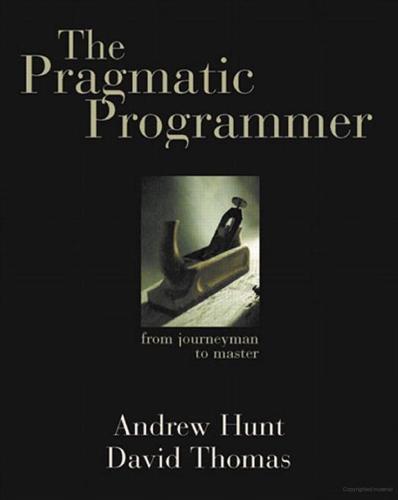
The Pragmatic Programmer
by
Andrew Hunt
and
Dave Thomas
Published 19 Oct 1999
In addition, the O'Reilly Nutshell series (www.ora.com) gives quick, comprehensive treatments of miscellaneous topics and languages such as perl, yacc, sendmail, Windows internals, and regular expressions. The Web Finding good content on the Web is hard. Here are several links that we check at least once a week. Slashdot. Billed as "News for nerds. Stuff that matters," Slashdot is one of the net homes of the Linux community. As well as regular updates on Linux news, the site offers information on technologies that are cool and issues that affect developers. ⇒ www.slashdot.org Cetus Links. Thousands of links on object-oriented topics. ⇒ www.cetus-links.org WikiWikiWeb. The Portland Pattern Repository and patterns discussion. Not just a great resource, the WikiWikiWeb site is an interesting experiment in collective editing of ideas
…
Dobbs Journal, 263 DRY principle, 27, 29, 42 see also Duplication Duck, rubber, see Rubber duck Dumpty, Humpty, xxii, 165 Duplication, 26 code generators avoid, 28 and code reviews, 33 design errors, 30 documentation and code, 29 DRY principle, 27, 29 interdeveloper, 32 in languages, 29 multiple representations, 28 teams, 226 under time pressure, 32 types of, 27 Dynamic configuration, 144 Dynamic data structure, 135 Dynamics of Software Development, 264 E E-mail, 22 address for feedback, xxiii Editor, 82 auto-indenting, 85 cursor movement, 84 features, 83 generating code, 103 how many to learn, 82 template, 84 types of, 266 Windows notepad, 84 Effective C++, 265 Eiffel, 109, 114, 267 EJB, see Enterprise Java Beans elvis editor, 267 Emacs editor, 84, 266 Viper vi emulator, 267 Embedded mini-language, 62, 145 Embellishment, 11 Encapsulation, object, 127, 158 Eno, Brian, 205 Enterprise Java Beans (EJB), 39, 147 Entropy, 4 Error DBC messages, 115 design, 30 domain-specific, 59 early crash, 120 log messages, 196 orthogonality, 41 testing, 240, 247 see also Exception Error handler, 127 Estimating, 64 accuracy, 64 algorithms, 177, 178 iterative, 69 models, 66 problem domain, 66 project schedules, 68 records, 68 testing, 182 Eton College, xxi Event, 157 Event channel, 160 Example code add logging, 40 airline reservations, 164, 296 assert macro, 122 auto_ptr example, 134 bad resource balancing, 129, 130 downloading, xxiii exception error handling, 125 good resource balancing, 131 JavaDoc example, 250 method chaining, 139 normalized class, 31 open password file, 126 open user file, 127 resources and exceptions, 132, 133 side effect, 124 spaghetti error handling, 125 square root, 190 string parsing with StringTokenizer, 156 string parsing with strtok, 155 unnormalized class, 30 Example code by name AOP, 40 Misc.java, 156 assert, 122 bad_balance.c, 129, 130 balance.cc, 134 balance.c, 131–133 class Line, 30, 31 exception, 125 findPeak, 250 interface Flight, 164, 296 misc.c, 155 openpasswd.java, 126 openuserfile.java, 127 plotDate, 139 side_effect, 124 spaghetti, 125 sqrt, 190 Exception, 121 effects of, 127 and error handlers, 127 missing files, 126 resource balancing, 132 when to use, 125 Excuses, 3 Executable document, 251 expect, 269 Expert, see Guru Expiring asset, 12 eXtensible Style Language (XSL), 253 Extinction, 148 eXtreme Programming, 238n, 258, 272 F Feature creep, 10 Feedback, e-mail address, xxiii File exception, 126 header, 29 implementation, 29 log, 196 makefile, 232 source, 103 Final build, 234 Fish, dangers of, 34 Flexibility, 46 Formal methods, 220, 221 Four Posts Puzzle, 213 Fowler, Martin, xxiii, 186, 273 Free Software Foundation, see GNU Project Frog, boiled, see Boiled frog Function accessor, 31 Law of Demeter for ~s, 140 similar, 41 G Gamma, Erich, 194 Garbage collection, 134 Gardening metaphor, 184 Gehrke, Peter, xxiv Glass, Robert, 221, 236 Global variables, 40, 130, 154 Glossary, project, 210 GNU Project, 274 C/C++ compiler, 267 General Public License (GPL), 80 GNU Image Manipulation Program (GIMP), 274 SmallEiffel, 267 “Good-enough software”, see Software, quality Gordian knot, 212 Goto, 127 GUI system vs. command shell, 78 interface, 78 testing, 244 Guru, 17, 198 H Hash, secure, 74 Header file, 29 “Heisenbug”, 124, 289 Helicopter, 34n Hopper, Grace, 8n, 90 “Hot-key” sequence, 196 HTTP Web server, 196 Human factors, 241 Humpty Dumpty, xxii, 165 Hungarian notation, 249 Hungry consumer model, 153 Hypertext document, 210 I iContract, 110, 114, 268 IDE, see Integrated Development Environment IEEE Computer Society, 262 IEEE Computer, 262 IEEE Software, 263 Imperative language, 60 Implementation accidents, 173 coding, 173 specifications, 219 Imposed duplication, 28 Inadvertent duplication, 30 Indentation, automatic, 85 Independence, see Orthogonality Infrastructure, 37 Inheritance, 111 assertions, 113 fan-in/fan-out, 242 Inner tennis, 215 Inspection, code, see Code reviews Insure++, 136 Integrated circuit, 189n Integrated Development Environment (IDE), 72, 232 Integration platform, 50 Integration testing, 239 Interface blackboard system, 168 C/Object Pascal, 101 concurrency, 155 error handler, 128 GUI, 78 prototyping, 55 user, 203 Invariant, 110, 113, 155 loop, 116 semantic, 116, 135 ISO9660 format, 233n Iterative development, 69 J Jacobson, Ivar, 204 Jargon, xxii, 210 Jargon file, 273 Java, 46, 267 code generation, 232 DBC, 114 Enterprise Java Beans, 39, 147 error messages, 115 exceptions, 121 iContract, 110, 114, 268 javaCC, 59, 269 JavaDoc, 248, 251 JavaSpaces, 166, 273 JUnit, 195 multithreaded programming, 154 property access, 100 property files, 145 resource balancing, 134 RMI, 128 string parser, 156 tree view, 161 unit tests, 193 and Windows shells, 81 JavaDoc, see Java K K Desktop Environment, 273 Kaizen, xxi, 14 see also Knowledge portfolio Kernighan, Brian, 99 Keybinding, 82 Kirk, James T., 26 Knowledge producers and consumers, 166 Knowledge portfolio, 12 building, 13 critical thinking, 16 learning and reading, 14 researching, 15 Knuth, Donald, 183, 248 Korn, David, 81 Kramer, Reto, xxiv Kruchten, Phillipe, 227n L Lakos, John, xxiv, 9, 142, 265 Lame excuses, 3 Language, programming conversions, 103, 105 DBC, 114 domain, 57 duplication in, 29 learning, 14 prototypes, 55 scripting, 55, 145 specification, 58, 62 text manipulation, 99 see also Mini-language Large-Scale C++ Software Design, 142, 265 LATEX system, 103 Law of Demeter, 140 Lawns, care of, xxi Layered design, 37 Layered system, see Modular system “lazy” code, 111 Lex and Yacc, 59 Librarian, see Project librarian Library code, 39 Linda model, 167 Linear algorithms, 177 Linux, 15, 254, 265 Liskov Substitution Principle, 111 Listening, 21 Literate programming, 248 Logging, 39, 196 see also Tracing Lookup table, 104 Loop nested, 180 simple, 180 Loop invariant, 116 M Macro, 78, 86 assertions, 122 documentation, 252 error handling, 121 Maintenance, 26 imperative languages, 61 Makefile, 232 recursive, 233 Managing expectations, 256 Mark-up language, 254 Martin, Robert C., 273 McCabe Cyclomatic Complexity Metric, 242 Member variables, see Accessor functions Memory allocation, 135 Metadata, 144, 203 business logic, 146 configuration, 147 controlling transactions, 39 decoupled code, 145 and formal methods, 221 in plain text, 74 Metric, 242 Meyer, Bertrand, 31n, 109, 184, 264 Meyer, Scott, 265 Microsoft Visual C++, 198 Microsoft Windows, 46 Mini-language, 59 data language, 60 embedded, 62 imperative, 60 parsing, 62 stand-alone, 62 Mixing board, 205 MKS Source Integrity, 271 Model, 160 calculations, 67 components and parameters, 66 and estimating, 66 executable documents, 251 view, 162 Model-view-controller (MVC), 38, 160 Modular system, 37 coding, 138 prototyping, 55 resource allocation, 135 reversibility, 45 testing, 41, 190, 244 More Effective C++, 265 Mozilla, 273 Multithreaded programming, 154 MVC, see Model-view-controller The Mythical Man Month, 264 N Name, variable, 249 Nana, 114, 268 Nest allocations, 131 Nested loop, 180 Netscape, 145, 273 Newsgroup, 15, 17, 33 Nonorthogonal system, 34 Normalize, 30 Novobilski, Andrew J., 189n O() notation, 178, 181 Object coupling, 140n destruction, 133, 134 persistence, 39 publish/subscribe protocol, 158 singleton, 41 valid/invalid state, 154 viewer, 163 Object Management Group (OMG), 270 Object Pascal, 29 C interface, 101 Object-Oriented Programming, 189n Object-Oriented Software Construction, 264 Obsolescence, 74 OLTP, see On-Line Transaction Processing system OMG, see Object Management Group On-Line Transaction Processing system (OLTP), 152 Options, providing, 3 Ordering, see Workflow Orthogonality, 34 coding, 34, 36, 40 design, 37 documentation, 42 DRY principle, 42 nonorthogonal system, 34 productivity, 35 project teams, 36, 227 testing, 41 toolkits & libraries, 39 see also Modular system Over embellishment, 11 P Pain management, 185 paint() method, 173 Painting, 11 Papua New Guinea, 16 Parallel programming, 150 Parrots, killer, see Branding Parsing, 59 code generators, 105 log messages, 196 mini-language, 62 strings, 155 Partitioning, 168 Pascal, 29 Passive code generator, 103 Performance testing, 241 Perl, 55, 62, 99 C/Object Pascal interface, 101 database schema generation, 100 home page, 267 Java property access, 100 power tools, 270 test data generation, 100 testing, 197 and typesetting, 100 Unix utilities in, 81 web documentation, 101 Perl Journal, 263 Persistence, 39, 45 Petzold, Charles, 265 Pike, Rob, 99 Pilot landing, handling, etc., 217 who ate fish, 34 Plain text, 73 vs. binary format, 73 drawbacks, 74 executable documents, 251 leverage, 75 obsolescence, 74 and easier testing, 76 Unix, 76 Polymorphism, 111 Post-it note, 53, 55 Powerbuilder, 55 The Practice of Programming, 99 Pragmatic programmer characteristics, xviii e-mail address, xxiii Web site, xxiii Pre- and postcondition, 110, 113, 114 Predicate logic, 110 Preprocessor, 114 Presentation, 20 Problem domain, 58, 66 metadata, 146 Problem solving, 213 checklist for, 214 Productivity, 10, 35 Programming by coincidence, 173 Programming staff expense of, 237 Programming Windows, 265 Project glossary, 210 “heads”, 228 saboteur, 244 schedules, 68 see also Automation; Team, project Project librarian, 33, 226 Prototyping, 53, 216 architecture, 55 disposable code, 56 kinds of, 54 and programming languages, 55 and tracer code, 51 using, 54 Publish/subscribe protocol, 158 Pugh, Greg, 95n Purify, 136 PVCS Configuration Management, 271 Python, 55, 99, 267 Q Quality control, 9 requirements, 11 teams, 225 Quarry worker’s creed, xx Quicksort algorithm, 180 R Rational Unified Process, 227n Raymond, Eric S., 273 RCS, see Revision Control System Real-world data, 243 Refactoring, 5, 185 automatic, 187 and design, 186 testing, 187 time constraints, 185 Refactoring browser, 187, 268 Refinement, excessive, 11 Regression, 76, 197, 232, 242 Relationship has-a, 304 kind-of, 111, 304 Releases, and SCCS, 87 Remote Method Invocation (RMI), 128 exception handling, 39 Remote procedure call (RPC), 29, 39 Repository, 87 Requirement, 11, 202 business problem, 203 changing, 26 creep, 209 DBC, 110 distribution, 211 documenting, 204 in domain language, 58 expressing as invariant, 116 formal methods, 220 glossary, 210 over specifying, 208 and policy, 203 usability testing, 241 user interface, 203 Researching, 15 Resource balancing, 129 C++ exceptions, 132 checking, 135 coupled code, 130 dynamic data structures, 135 encapsulation in class, 132 Java, 134 nest allocations, 131 Response set, 141, 242 Responsibility, 2, 250, 258 Reuse, 33, 36 Reversibility, 44 flexible architecture, 46 Revision Control System (RCS), 250, 271 Risk management, 13 orthogonality, 36 RMI, see Remote Method Invocation Rock-n-roll, 47 RPC, see Remote procedure call Rubber ducking, 3, 95 Rules engine, 169 S Saboteur, 244 Samba, 272 Sample programs, see Example code Sather, 114, 268 SCCS, see Source code control system Schedule, project, 68 Schrödinger, Erwin (and his cat), 47 Scope, requirement, 209 Screen scraping, 61 Scripting language, 55, 145 Secure hash, 74 sed, 99 Sedgewick, Robert, 183 Self-contained components, see Orthogonality; Cohesion Semantic invariant, 116, 135 sendmail program, 60 Sequence diagram, 158 Server code, 196 Services, design using, 154 Shell, command, 77 vs. GUI, 78 see also Command shell “Shy code”, 40 Side effect, 124 SIGPLAN, 263 Simple loop, 180 Singleton object, 41 Slashdot, 265 SmallEiffel, 267 Smalltalk, 46, 186, 187, 268, 272 Software development technologies, 221 quality, 9 requirements, 11 Software bus, 159 “Software Construction”, 184 Software Development Magazine, 263 Software IC, 189n “Software rot”, 4 Solaris, 76 Source code cat eating, 3 documentation, see Comments downloading, see Example code duplication in, 29 generating, 103 reviews, see Code reviews Source code control system (SCCS), 86 Aegis, 246 builds using, 88 CVS, 271 development tree, 87 plain text and, 76 RCS, 250, 271 repository, 87 tools, 271 Specialization, 221 Specification, 58 implementation, 219 language, 62 as security blanket, 219 writing, 218 Spy cells, 138 Squeak, 268 Stand-alone mini-language, 62 “Start-up fatigue”, 7 Starting a project problem solving, 212 prototyping, 216 specifications, 217 see also Requirement Stevens, W.

Facebook: The Inside Story
by
Steven Levy
Published 25 Feb 2020
Synapse was slow to take off, despite Zuckerberg’s attempts to promote it, including getting Synapse-ai T-shirts made that said [[my brain is better than yours]]. (The brackets were a flourish invoking programming protocol.) It wasn’t until spring that things started happening with Synapse. On April, 21, 2003, Slashdot, the premier source of news for the geek world, ran an item about an “interesting approach to digital music by students at Caltech and Harvard.” It invited the millions of people in the Slashdot community to try it out, and, as was common with the site, a spirited online conversation ensued. One of the discussion threads dealt with the program’s retention of the user’s music preferences.
…
None of your musical listening data will be available to anyone other than you. We hope to use massive amounts of data to aid in analysis, but your individual data will never be seen by anyone else. * * * • • • IT WAS ZUCKERBERG’S first public acknowledgment of the importance of privacy in his work. Certainly not the last. The Slashdot geeks noted another oddity involving Synapse: the callow and creepy language in the program description Zuckerberg had written. There was a rambling paragraph about all the people who would love Synapse (“Programmers. Gangsters. Punks. Nerds. Really big nerds. Even ones from Yemen. Yeah, plenty of those . . .
…
.”); a cringe-worthy Playboy-style passage about how the program could help in romancing “a Chinese girl”; and also some boasting about Zuckerberg’s own computer prowess (“Mark’s mouse, alone, has moved enough to go around the world . . . twice.”) D’Angelo was appalled when he saw this, and demanded Zuckerberg take it down. Of course, the Internet never forgets. Overall, though, the Slashdot attention was a boon. Zuckerberg heard from multiple companies interested in the student project, including Microsoft and AOL. Zuckerberg and D’Angelo got an offer approaching a million dollars from one of those suitors. But the payout would be contingent on Zuckerberg and D’Angelo committing to work for that company for three years.

Simple and Usable Web, Mobile, and Interaction Design
by
Giles Colborne
Published 14 Sep 2010
Expert customers are enthusiasts, they’re vocal and opinionated about how to improve what’s on offer. But experts aren’t typical customers and their judgment is often skewed. They don’t experience the problems that mainstream customers have. And they want things that mainstream customers don’t care about. Here’s what one responder on Slashdot (a blog run by experts and enthusiasts) had to say when the iPod was announced: “No wireless. Less space than a Nomad. Lame.” Another commenter wrote: “I don’t see many sales in the future of iPod.” And another: “All I can say is, as an Apple ‘fan’, I’m sad.” Commenters on another enthusiast blog, MacRumors, also wanted more: ”I still can’t believe this!
…
See also design features changes, importance versus feasibility, 14–15 character and personality, 10 descriptions concise, clear, and complete, 46 experiences, 44 one-line, 18 dissatisfaction with complexity, 6 incorrect approaches, 66–67 fake simplicity of interfaces, 12–13 lightening users’ load, 84–85 guidelines, 18 overburdening users’ decisionmaking, 86–87, 94–95 needs poorly implemented features, 70–71 prioritizing features, 82–83 providing options and preferences, 92–93 smart defaults, 90–91 versus removing too many features, 104–105 control issues, 34 emotional, 32–33 of self and customers, 14–15, 36 strategies for achieving, 2 Skitch app, 154 Slashdot blog commenters on iPods, 26 Sless, David, 108 Standish Group poll, 64 versus satisfied users, 106–107 INDEX • 195 Download from WoweBook.com strategies for simplicity, 2 needs DVD remote controls, 56–59 for details, 182 displacing buttons, 60–61 emotional, 32–34 hiding buttons, 60–61 for simplicity, 184 organizing buttons, 60–61 self-knowledge, 14–15 removing buttons, 60–61 willing adopters, 24 SUV principle, 6 versus other users, 28 world/natural environment, 18–21 T homes, 22 Ta-da List (37signals), 174 interruptions, 22–23 Telewest, 52, 68–69 offices, 22 Tesler, Larry, 180 outdoors, 22 Things app, 32–34 37signals V Basecamp, 64 Volkswagen advertisement, 102–103 Ta-da List app, 174 VW Beetle (original), 4 Thompson, Debora Viana, 78 to-do list apps, 32–34, 174 touch interfaces, 127 travel planning software, 166–169 Tufte, Edward, 98 TUI Ski, 70 Tumblr’s blog service, 64, 180 W Whac-A-Mole game, 180–181 Which?

I'm Feeling Lucky: The Confessions of Google Employee Number 59
by
Douglas Edwards
Published 11 Jul 2011
[back] *** * CP+B won Microsoft's $300 million account in 2008 and created the "I'm a PC" campaign. [back] *** * The name was changed to "orkut" because the Eden.com domain was not for sale. It was intentionally not capitalized to distinguish orkut the service from Orkut the engineer. [back] *** * "Slashdotting" was a well-known online phenomenon: a site was mentioned on slashdot.com and all the users congregating there immediately went to check it out, causing the site's servers to crash under the sudden load. [back] *** * And in Finland for a brief time, because "orkut" in Finnish means "multiple sexual climaxes." Once people realized the site was not for romantic hookups, traffic quickly fell off.
…
"I want to kill the perception that we're selling our search results ASAP," she told us. "Our brand has been injured and we need to fix it. We're Google! Let's be outrageous and daring and have some fun with this." Feelings ran deep on the subject of paid placement. When the topic of Google's refusal to sell placement came up on the geek bulletin board Slashdot, the first posted response was "I swear I want to make love to this company." A self-identified Overture employee didn't share those warm and fuzzy feelings. "As for the claim by Google that they are pure," he asked plaintively, "why are they getting into the ad search business?" His implication seemed to be that the whole business was tainted.
…
He had been hearing all day from engineers about unresolved issues: that orkut was running on a single machine with no easy way to scale, that there had been no proper load testing, no security review, and no agreement on the privacy policy. Clearly orkut would not be able to handle the influx of traffic once word got out to the geek news site Slashdot,* which would take about fifteen minutes. It would be smarter, he said, to clean things up for a few days, wait for the execs to return from Switzerland, and avoid a huge mistake. We all breathed a sigh of relief when Jonathan confirmed that he had spoken with most of the executive team and they had agreed with Urs it was better to delay the launch.

Free as in Freedom
by
Sam Williams
Published 16 Nov 2015
Ultimately, however, it is a tale of two cities: New York, New York, the book-publishing capital of the world, and Sebastopol, California, the book-publishing capital of Sonoma County. The story starts in April, 2000. At the time, I was writing stories for the ill-fated BeOpen web site (http://www.beopen.com/). One of my first assignments was a phone interview with Richard M. Stallman. The interview went well, so well that Slashdot (http://www.slashdot.org/), the popular "news for nerds" site owned by VA Software, Inc. (formerly VA Linux Systems and before that, VA Research), gave it a link in its daily list of feature stories. Within hours, the web servers at BeOpen were heating up as readers clicked over to the site. 158 For all intents and purposes, the story should have ended there.
…
In the case of Stallman, never attempt the definitive biography of a man who trusts his every thought to the public record. For the readers who have decided to trust a few hours of their time to exploring this book, I can confidently state that there are facts and quotes in here that one won't find in any Slashdot story or Google search. Gaining access to these facts involves paying a price, however. In the case of the book version, you can pay for these facts the traditional manner, i.e., by purchasing the book. In the case of the electronic versions, you can pay for these facts in the free software manner.

Delete: The Virtue of Forgetting in the Digital Age
by
Viktor Mayer-Schönberger
Published 1 Jan 2009
; Rotenberg, “Fair Information Practices and the Architecture of Privacy,” 80–90; see also Lemley, “Private Property,” 1547; Cohen, “DRM and Privacy,” 577. 25. Mayer-Schönberger, “Beyond Copyright: Managing Information Rights with DRM.” 26. Halderman, Waters, and Felten, “Privacy Management for Portable Recording Devices.” 27. Julian Togelius, comment on Slashdot, May 10, 2007, http://yro.slashdot.org/comments.pl?sid=234167&cid=19065957. 28. Winter, “The Advantages of Amnesia.” 29. Schacter, How the Mind Forgets, 184–206. 30. Anderson and Schooler, “Reflections of the Environment in Memory.” 31. On the very extreme end of measures, drugs may be used to help such a cognitive adjustment.
…
This set of three responses is more speculative than the more familiar set of three I have just described. But as they focus less on the relational dimension of information, they may conceivably be better suited to address the “time” challenge of digital remembering. Cognitive Adjustment When my initial paper on the demise of forgetting in the digital age was discussed at Internet site Slashdot, Julian Togelius, an artificial intelligence researcher in Europe agreed with my diagnosis, but suggested a very different remedy. “Instead,” he wrote, “we have to adapt our culture to the inevitable presence of modern technology. [ . . . ] We will simply have to assume that people can change and restrict ourselves to looking at their most recent behavior and opinions.”27 Togelius’ sentiments were echoed by Harvard Berkman Center fellow danah boyd, who is convinced that “[p]eople, particularly younger people, are going to come up with coping mechanisms.
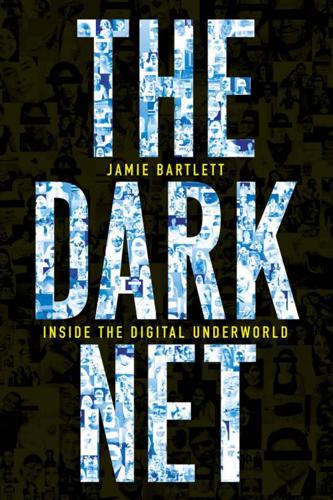
The Dark Net
by
Jamie Bartlett
Published 20 Aug 2014
SomethingAwful.com hosts a wide variety of funny and offensive content – especially blogs, videos and stories – written by editors and forum members; it also hosts several large forums. Fark.com is a satirical site with stories submitted by users of the site. Slashdot.com was more about open-source software and technology but also had a subversive edge and was opposed to censorship. Slashdot, founded in 2000, had a vast online community, many of them Usenetters, and celebrated user-generated in-jokes and memes. SomethingAwful forum members – those who posted regularly on the site called themselves ‘Goons’ – frequently targeted other more serious websites for raids and general mischief-making.
…
Usenet, like most new and exciting technologies, had become outdated. At the turn of the millennium, trolls migrated from Usenet to a new breed of irreverent, user-driven, censorship-free sites, that were soon collectively labelled as ‘Not Safe For Work’ (NSFW), and often created by students or teenagers: SomethingAwful.com, Fark.com and Slashdot.com. Unlike traditional media, these sites were filled with stories, links, suggestions and comments from their readers. Whatever stories were the most read or shared by users would rise up the ranking system, meaning popularity was driven not by centralised editorial control but by whatever happened to capture the attention of the community.

Blood, Sweat, and Tea: Real-Life Adventures in an Inner-City Ambulance
by
Tom Reynolds
Published 1 Apr 2008
I know at least two people (people I’ve met, not including people I’ve read about), who have gotten jobs based on their blogging. In most cases people are happier with their new jobs than their old, if only because their new company understands and supports their blogging. *Slashdotted (verb): to have your website linked to by the incredibly popular technology news website www.slashdot.org. **Don’t ask! Fit Yesterday was busy, but busy in a good way in that most of the calls that I got actually warranted an ambulance. Actually, if I had been dropped on my head repeatedly as a child leading to me believing in the supernatural, I would have thought that there was something strange going on.
…
I would imagine that some of the people who have been fired or disciplined have comforted themselves with the thought that ‘it’s because I have a blog, that’s the only reason’. So be a good worker, then they won’t be so quick to sack you. Just because you blog, it doesn’t make you special. Sure, you might have 10000 page-hits a day, you are ‘Slashdotted’.*This occasionally results in overwhelming levels of traffic, capable of knocking your website over on a regular basis, and you have Dave Weiner’s**home phone number–but that means nothing to your boss. Blogging doesn’t bring with it a ‘Get Out Of Jail Free’ card, you have no ‘Freedom of the Press’, and just because thousands of people hang on your every word it doesn’t mean that they will help you keep your job.

Superbloom: How Technologies of Connection Tear Us Apart
by
Nicholas Carr
Published 28 Jan 2025
Drawing on early studies of hyperlinking patterns and traffic flows among blogs and other informational websites, he argued that a new, grassroots process of content review, accreditation, and filtering had emerged online. Through “peer review by information affinity groups,” clusters of web users who share an interest in and knowledge of a particular topic, the process weeds out falsehoods and fluff. The affinity groups—he offered as an example Slashdot, a technology news aggregator that ranked stories on the basis of readers’ votes—“filter the observations and opinions of an enormous range of people, and transmit those that pass local peer review to broader groups and ultimately to the polity more broadly, without recourse to market-based points of control over the information flow.”
…
Like Stevens before him, he allowed his faith in the democratization narrative to skew his perspective. The evidence he found of people using voting, linking, and commenting systems to make informed judgments about online content was real but misleading. The peer-review tools that worked on news aggregator sites such as Slashdot and in certain quarters of the then-vibrant blogosphere turned out to be peripheral to the development of the so-called networked public sphere. They were of great interest to the net’s geeky pioneers and their fellow travelers in media and academia but of little interest to ordinary people. They ended up being of minor consequence to the broader flows of information and influence online.
…
See also social engagement Reno, Janet, 62 repeaters, humans as, 136–42 Replika, 192–93 Republican Party, 135–36, 145, 198 Revere, Paul, 21 Rieff, Philip, 15 Rogers, Will, 45 Rosen, Jay, 124 Rosen, Jeffrey, 73 Rosenstein, Justin, 147 Ruark, Robert, 44 Rushkoff, Douglas, 123 Russell, Bertrand, 109–10 Russell, Stuart, 183 Ryan, Meg, 83 Samuel, Alexandra, 109, 110 Sanghvi, Ruchi, 64, 66 Scharf, Caleb, 77 Schmidt, Eric, 77 Schudson, Michael, 134 Schwartz, Tony, 66–69 secrecy-of-correspondence doctrine, 29–32, 39, 61–62, 224 Section 230, 61 seeking instinct, 217–19 self affiliations of, 169–70 content and, 159, 168–69 “crisis of self-presentation,” 164–65 dislocation of, 155–79 encoding and decoding of, 158 looking-glass, 166 media programming and, 166–67 mediation of communication and, 158 mirrorball, 165–70 performances of, 160, 164–65 self-expression, 52–53, 108, 111–15, 118, 149, 213–14 self-image, 158, 213–14 self-profiling, 177–78 self-stereotyping, 169 self-viewing, 157 self-harm, 172–73 semantics. See meaning Sermo, 165 Shannon, Claude, 54–57, 60, 64, 68, 75, 78, 91, 138, 139, 184, 185, 189 Shaw, George Bernard, 129 signal processing, semantic processing and, 189–90 Simmel, Georg, 115 Simon, Herbert, 134–35 simulations, 230–31 Siri, 192 Slack, 99, 165 Slashdot, 126, 127 Slotten, Hugh, 36 smartphones, 74, 93, 95–97, 170, 214, 220–21 Smith, Dorothy, 167 Smith, Jaci Marie, 1–2 SMS text messages, 93 Snapchat, 108, 165 Snyder, Charles, 100 social boundaries, erasure of, 109 “social buttons,” 95 social change, 8–10, 13–14, 24, 116 social contexts, blurring of, 163–64 social engagement, 171–75, 192, 216 social media, 12–13, 17, 63–74, 93, 95, 101, 127, 139–41, 162, 170.

Website Optimization
by
Andrew B. King
Published 15 Mar 2008
Send email to reporters, bloggers, and colleagues. Post media to Flickr and YouTube, add a page to Facebook, submit stories to Slashdot, and tag those stories on del.icio.us. Respond to Usenet and blog posts. In other words, use social networking to get your site out there. A link from one of these high PageRank sites drives a lot of traffic and is worth hundreds of links from lesser sites (refer back to Table 1-1). A little preparation can increase your odds when submitting to news sites such as Slashdot, Digg.com, and Yahoo! Buzz because such sites have an extremely large user base that is equally critical to the site's effect.
…
Buzz because such sites have an extremely large user base that is equally critical to the site's effect. First, make sure you submit to the proper category. Submit only your most newsworthy content, because sites such as Slashdot are inundated with submissions. Be sure to follow the headline and deck writing guidelines in this chapter, as well as in Chapter 5. Finally, it helps if you have a story angle or address a current trend, and are relevant to the theme of the target site. Additionally, enabling user-generated content can scale your business without requiring more staff members. Sites that illustrate this trend include Photo.net (the largest photography bulletin board), del.icio.us (rated bookmarks), and YouTube.com (videos).
…
, Microsoft, and Everybody Else, Goals and Values, Goals and Values website focus and, Unprofessional design work cycle overview, The Pay-per-Click Work Cycle press releases, Step 10: Build Inbound Links with Online Promotion, Step 10: Build Inbound Links with Online Promotion primacy effect, New visitors primary content consumption (metric), Website Success Metrics, Primary content consumption, Success Metrics = Reaching Goals PRNewsWire.com, Step 10: Build Inbound Links with Online Promotion, Step 10: Build Inbound Links with Online Promotion product images, Factor #8: Deploy Persuasive, Benefit-Oriented Content, Factor #9: Use Illustrative Product and Service Images—The "Hero Shot", Factor #10: Use Interactive Elements to Engage Users professional website design, Unprofessional design, Make it linkworthy profit-per-impression equation, Measuring Ad Performance progressive enhancement (PE) strategy, Use progressive enhancement, Use progressive enhancement, Use progressive enhancement, Use progressive enhancement Prototype library, Relying on Ajax Libraries prototyping, Put it on paper and build graphical mockups ProxyPass directive, Using mod_cache ProxyScoring (metric), PathWeight and ProxyScoring PRWeb.com, Step 10: Build Inbound Links with Online Promotion, Step 10: Build Inbound Links with Online Promotion psychographics, Discovering personas psychological reactance, The six persuaders psychology of persuasion, The six persuaders, The six persuaders, The six persuaders, The six persuaders, The six persuaders, The six persuaders, Building trust to close the sale, Optimize with persuasive copywriting, Optimize with persuasive copywriting authority, The six persuaders building trust, Building trust to close the sale, Optimize with persuasive copywriting consistency, The six persuaders CRO considerations, Optimize with persuasive copywriting liking, The six persuaders reciprocation, The six persuaders scarcity, The six persuaders social proof, The six persuaders PubSub.com, Delta encoding (delta compression) Q Quality Scores, Optimizing Pay-per-Click Ads optimizing ad groups, Optimizing Pay-per-Click Ads QuickTime Pro, Optimizing videos for the Web, Optimizing videos for the Web, Optimizing videos for the Web, Optimizing videos for the Web, Optimizing videos for the Web, Optimizing videos for the Web, Optimizing videos for the Web, Optimizing videos for the Web, Optimizing videos for the Web Compressor section, Optimizing videos for the Web Data Rate section, Optimizing videos for the Web Encoding area, Optimizing videos for the Web Frame Reordering box, Optimizing videos for the Web Key Frames area, Optimizing videos for the Web Motion section, Optimizing videos for the Web optimizing video, Optimizing videos for the Web Quality area, Optimizing videos for the Web Temporal slider, Optimizing videos for the Web R rankings, Natural Search Engine Optimization, Natural Search Engine Optimization, The Benefits of SEO, Duplicate content, Duplicate content, Best Practices, Tools for keyword research, Optimize key content, Acquire inbound links, Acquire inbound links, Summary, Step 1: Determine Your Keyword Phrases, Find your primary keyphrase, Tools for keyword research, Tools for keyword research, Tools for keyword research, Tools for keyword research, Find your primary keyphrase, Step 2: Sort by Popularity, Step 2: Sort by Popularity, Step 2: Sort by Popularity, Step 2: Sort by Popularity, Step 2: Sort by Popularity, Step 2: Sort by Popularity, Step 3: Refine Keyword Phrases and Re-Sort, Right-size your keyphrases, Keywords trump company name (usually), Right-size your keyphrases, Keywords trump company name (usually), Right-size your keyphrases, Right-size your keyphrases, Target multiple keyphrases, Target multiple keyphrases, Target multiple keyphrases, Keywords trump company name (usually), Keywords trump company name (usually), Keywords trump company name (usually), Step 6: Write a Keywords Meta Tag, Write headlines that pop, Step 8: Add Keywords Tactically, Buy keyphrased domain names, Buy keyphrased domain names, Buy keyphrased domain names, Step 9: Create Valuable Keyword-Focused Content, Sharpen your keyword-focused content, Create search-friendly URIs, Write compelling summaries, Automatically categorize with blogs, Automatically categorize with blogs, Automatically categorize with blogs, Create tag clouds, Create tag clouds, Step 10: Build Inbound Links with Online Promotion, Summary, Step 10: Build Inbound Links with Online Promotion, Step 10: Build Inbound Links with Online Promotion, Step 10: Build Inbound Links with Online Promotion, Don't dilute your PageRank, Be leery of link exchange voodoo, Hurl harmful outlinks, Reduce risky redirects, Measuring inbound links, Measuring inbound links, Summary, Summary acquiring inbound links, Acquire inbound links adding keywords tactically, Buy keyphrased domain names, Buy keyphrased domain names best practices, Best Practices, Tools for keyword research, Tools for keyword research building inbound links, Step 10: Build Inbound Links with Online Promotion, Summary, Step 10: Build Inbound Links with Online Promotion, Measuring inbound links, Summary determining keyphrases, Step 1: Determine Your Keyword Phrases, Find your primary keyphrase, Tools for keyword research, Find your primary keyphrase duplicate website content and, Duplicate content Google factors, Step 2: Sort by Popularity importance of, Natural Search Engine Optimization, The Benefits of SEO keyword stuffing and, Step 2: Sort by Popularity keyword-focused content, Sharpen your keyword-focused content, Automatically categorize with blogs negative factors, Step 2: Sort by Popularity on-site optimization and, Natural Search Engine Optimization optimizing key content, Optimize key content positive factors, Step 2: Sort by Popularity re-sorting keyphrases, Right-size your keyphrases, Keywords trump company name (usually), Target multiple keyphrases, Keywords trump company name (usually) refining keyphrases, Right-size your keyphrases, Keywords trump company name (usually), Target multiple keyphrases, Keywords trump company name (usually) reinforcing site theme, Duplicate content steps for improving, Acquire inbound links, Summary, Tools for keyword research, Tools for keyword research, Step 2: Sort by Popularity, Step 2: Sort by Popularity, Step 3: Refine Keyword Phrases and Re-Sort, Right-size your keyphrases, Right-size your keyphrases, Target multiple keyphrases, Keywords trump company name (usually), Step 6: Write a Keywords Meta Tag, Write headlines that pop, Step 8: Add Keywords Tactically, Buy keyphrased domain names, Step 9: Create Valuable Keyword-Focused Content, Create search-friendly URIs, Write compelling summaries, Automatically categorize with blogs, Automatically categorize with blogs, Create tag clouds, Create tag clouds, Step 10: Build Inbound Links with Online Promotion, Step 10: Build Inbound Links with Online Promotion, Don't dilute your PageRank, Be leery of link exchange voodoo, Hurl harmful outlinks, Reduce risky redirects, Measuring inbound links, Summary RDF (Resource Description Framework), Summary reciprocation (persuader), The six persuaders Red Hat Enterprise platform, Target files by extension for caching reference movies, Step 3: Optimize Multimedia regional compression, Step 2: Resize and Optimize Images remote procedure calls, Load JavaScript on demand (remote procedure calls) remote scripting, Ajax Optimization repeat visitors (metric), Repeat visitors replication, Shorthand properties Resource Description Framework (RDF), Summary return statement, Avoid Optional Constructs and Kill Dead Code Fast revenue per visit (metric), Revenue per visit(or) RewriteEngine directive, How mod_rewrite works RewriteMap directive, How mod_rewrite works RewriteRule directive, How mod_rewrite works RFC 2397, Inline Images with Data URIs, Disadvantages of inline images Rhino JavaScript engine, Bundle Your Scripts, JavaScript Optimization and Packing RIAs (Rich Internet Applications), Ajax Optimization ROAS (return on advertising spend), Differences in Geotargeting, Web Server Log Analysis defined, Differences in Geotargeting web analytics support, Web Server Log Analysis robots exclusion protocol, Duplicate content ROI (return on investment), Summary of the Differences Among AdWords, adCenter, and YSM, Calculating Return on Investment, Pay-per-Click Return on Investment and Goals Summary calculating, Calculating Return on Investment PPC optimization and, Summary of the Differences Among AdWords, adCenter, and YSM, Pay-per-Click Return on Investment and Goals Summary root terms, The Right Keywords and the Myth of the Long Tail, The Right Keywords and the Myth of the Long Tail, Guidelines for Grouping ad group themes, Guidelines for Grouping broad matching, The Right Keywords and the Myth of the Long Tail unique keywords and, The Right Keywords and the Myth of the Long Tail RSS news feeds, Write compelling summaries headline summaries, Write compelling summaries rss2html.pl script, Example RSS cache S sales cycle, Goals and Values, Include multiple conversion points for different stages of the buying cycle, Building trust to close the sale, Factor #7: Include Appealing Offers and Calls to Action building trust, Building trust to close the sale calls to action, Factor #7: Include Appealing Offers and Calls to Action multiple conversion points, Include multiple conversion points for different stages of the buying cycle stages in, Goals and Values scarcity (persuader), The Psychology of Persuasion, The six persuaders scent, Factor #5: Use Benefit-Oriented Headlines script tag, Lazy-Load Your Code, Minimizing HTTP Requests, Load JavaScript on demand (remote procedure calls) scripting, Remap Built-in Objects, Delay Script Loading, Use progressive enhancement, Use progressive enhancement, Use an iframe for external JavaScript delaying loading, Delay Script Loading, Use progressive enhancement, Use progressive enhancement, Use an iframe for external JavaScript remapped objects and, Remap Built-in Objects Search Engine Marketing Professional Organization (SEMPO), Measuring SEM success search engines, Acquire inbound links, Tools for keyword research, Create search-friendly URIs, Original Site estimating search volume, Tools for keyword research ranking considerations, Acquire inbound links search parameters, Create search-friendly URIs simulating with Lynx, Original Site security policies, Minimizing HTTP Requests selectors (CSS), Top 10 Tips for Optimizing CSS replacing inline style with, Top 10 Tips for Optimizing CSS SEM (search engine marketing), Website Success Metrics, Measuring SEM success, Website Success Metrics, Popular Web Metrics, Popular Web Metrics, Measuring SEM success, Search Engine Marketing Metrics, Search Engine Marketing Metrics, Classes of Metrics, Unique visitors, Classes of Metrics, Content, Objectives, Means, Volume Metrics, Content Metrics: Measuring Each Component, Unique visitors, Unique visitors, Content Metrics: Measuring Each Component, Content Metrics: Measuring Each Component, Entries, Objectives, Understanding objectives classes of metrics, Classes of Metrics, Unique visitors, Classes of Metrics, Means, Unique visitors content metrics, Content, Entries, Understanding objectives measuring success, Popular Web Metrics metrics overview, Search Engine Marketing Metrics objectives for metrics, Objectives, Objectives strategies, Search Engine Marketing Metrics volume metrics, Volume Metrics, Content Metrics: Measuring Each Component, Unique visitors, Content Metrics: Measuring Each Component, Content Metrics: Measuring Each Component website success metrics, Website Success Metrics, Measuring SEM success, Website Success Metrics, Popular Web Metrics, Measuring SEM success Semphonic XChange, Unique visitors SEMPO (Search Engine Marketing Professional Organization), Measuring SEM success SEO (search engine optimization), Natural Search Engine Optimization, The Benefits of SEO, Common SEO Barriers, Reinforce the theme of your site, Inadequate inbound links, Drowning in splash pages, Flash fires, Flash fires, Unprofessional design, Unprofessional design, Obscure navigation, Duplicate content, Duplicate content, Reinforce the theme of your site, Step 1: Determine Your Keyword Phrases, Summary benefits, The Benefits of SEO common barriers, Common SEO Barriers, Reinforce the theme of your site, Reinforce the theme of your site duplicate content, Duplicate content, Duplicate content fixing focus, Unprofessional design Flash proliferation, Flash fires, Flash fires inadequate inbound links, Inadequate inbound links increased competition, Step 1: Determine Your Keyword Phrases JavaScript-only navigation, Obscure navigation metadata, Summary process components, Natural Search Engine Optimization splash pages, Drowning in splash pages unprofessional design, Unprofessional design SERPs (search engine result pages), Duplicate content, Keywords trump company name (usually), Buy keyphrased domain names company names in, Keywords trump company name (usually) keyphrased domain names, Buy keyphrased domain names two-URIs-per-hostname limit, Duplicate content server-side includes (SSIs), Eliminate (i)frames and JavaScript includes server-side optimization, Reduce DNS lookups, Caching Frequently Used Objects, Using mod_cache, Caching Frequently Used Objects, Three ways to cache in, Three ways to cache in, A specific caching example, Target files by extension for caching, Target files by extension for caching, Using mod_cache, Using mod_cache, Using HTTP Compression, Delta encoding (delta compression), Average compression ratios for HTTP compression, Average compression ratios for HTTP compression, Delta encoding (delta compression), The Benefits of a Content Delivery Network cache control, Caching Frequently Used Objects, Using mod_cache, Caching Frequently Used Objects, Three ways to cache in, Three ways to cache in, A specific caching example, Target files by extension for caching, Target files by extension for caching, Using mod_cache, Using mod_cache Content Delivery Network, The Benefits of a Content Delivery Network HTTP compression, Using HTTP Compression, Delta encoding (delta compression), Average compression ratios for HTTP compression, Average compression ratios for HTTP compression, Delta encoding (delta compression) parallel downloads, Reduce DNS lookups ServerAlias directive, Optimizing Parallel Downloads ServerTokens command, Target files by extension for caching service command, Target files by extension for caching service images, Factor #9: Use Illustrative Product and Service Images—The "Hero Shot", Factor #9: Use Illustrative Product and Service Images—The "Hero Shot", Factor #10: Use Interactive Elements to Engage Users session IDs, Create search-friendly URIs sessions, Volume Metrics Set-Cookie header, Three ways to cache in setRequestHeader( ) method, Method 3: Make Requests with an Old If-Modified-Since Header Shop.org study, Discovery sign-ups, Sign-ups simple engagement, Bounce rate (and simple engagement) Sistrix study, Buy keyphrased domain names Skip Intro links, Drowning in splash pages Skitz, Load JavaScript on demand (remote procedure calls) Slashdot, Employ social networking and user-generated content slogans, Best Practices for CRO, Factor #4: Write a Memorable Slogan sniffing, Step 4: Convert JavaScript Behavior to CSS , XSSI browser sniffing social networking, Employ social networking and user-generated content social norms, The six persuaders social proof (persuader), The Psychology of Persuasion, The six persuaders socket connections, Speed checklist, Request statistics, AOL Pagetest Solaris platform, Compressing content in Apache Sorenson codec, Optimizing videos for the Web Sorenson Video 3 Pro, Optimizing videos for the Web Souders, Switch to Semantic Markup source credibility, Source Credibility: Designing Gut Reactions, Factor #3: Optimize the Credibility of Your Logo spatial compression, Optimizing videos for the Web speed tax, Request statistics Speed Up Your Site, Average compression ratios for HTTP compression, Speed checklist Web Site Optimization, Average compression ratios for HTTP compression, Speed checklist splash pages, Drowning in splash pages Spontaneous personality type, Building trust to close the sale Start Render time metric, Load times, Reporting the Numbers, Start render Stefanov, Load JavaScript on demand (remote procedure calls) Sterne, Website Optimization Metrics strange attractors, Deploy strange attractors string constants, Use String Constant Macros structural assurance, Building trust to close the sale StuffIt, Speed checklist Sullivan, Don't dilute your PageRank sweetened traffic, Unique visitors T tag clouds, Create tag clouds, Deploy strange attractors, Create tag clouds, Deploy strange attractors taglines, Factor #4: Write a Memorable Slogan Telestream Episode Pro, Optimizing videos for the Web temporal compression, Optimizing videos for the Web ternary operator, Use JavaScript Shorthand testing, Testing ads the easy way: AdWords optimized ad serving, Testing ads the hard way: Confidence interval testing, Testing ads the hard way: Confidence interval testing, Testing ads the hard way: Confidence interval testing, Testing ads the hard way: Confidence interval testing, Testing Landing Pages, Adjusting Bids, Adjusting Bids, Multivariate testing with Google Website Optimizer, User Experience Testing Software, Designing a Sample Test, IBM Page Detailer, IBM Page Detailer ads, Testing ads the easy way: AdWords optimized ad serving, Testing ads the hard way: Confidence interval testing, Testing ads the hard way: Confidence interval testing, Adjusting Bids confidence interval, Testing ads the hard way: Confidence interval testing, Testing ads the hard way: Confidence interval testing, Adjusting Bids designing sample tests, Designing a Sample Test, IBM Page Detailer, IBM Page Detailer landing pages, Testing Landing Pages multivariate, Multivariate testing with Google Website Optimizer UX software, User Experience Testing Software Text-Link-Ads.com, Pay for links Textlinkbrokers.com, Step 10: Build Inbound Links with Online Promotion, Pay for links themed ad groups, Organizing and Optimizing Ad Groups, Guidelines for Grouping, Example Themed Ad Groups, Example Themed Ad Groups advantages, Organizing and Optimizing Ad Groups example, Example Themed Ad Groups, Example Themed Ad Groups guidelines, Guidelines for Grouping themes, Step 1: Look through your site and identify major themes TIFF format, Step 2: Resize and Optimize Images time to live (TTL), Three ways to cache in timeout mechanisms, Timeouts, Retries, and Ordering, Addressing Server and Content Error, Timeouts, Retries, and Ordering, Addressing Server and Content Error title tags, Step 2: Sort by Popularity, Target multiple keyphrases, Keywords trump company name (usually) trackPageview function, JavaScript Page Tagging trademarks, Trademark Issues, Summary, How do I stop advertisers from bidding on my trademark?

Rewired: The Post-Cyberpunk Anthology
by
James Patrick Kelly
and
John Kessel
Published 30 Sep 2007
” — Sterling to Kessel, 22 August 1986 1 The term “postcyberpunk” was first used by writer Lawrence Person, in an essay titled “Notes Toward a Postcyberpunk Manifesto” published in the critical magazine Nova Express in 1998. Person’s essay points toward some of the same developments we are pursuing in this anthology, but we do not use the term in exactly the same way that he sets it forth. As we go to press, Person’s essay is still available at the URL http://slashdot.org/features/99/10/08/2123255.shtml. Sterling-Kessel Correspondence IN THE WAKE of the publication of Neuromancer in 1984 there was a lot of talk about something called “cyberpunk” and a scurrilous fanzine called Cheap Truth, which apparently (I had never seen a copy) had been taking potshots at a number of writers I admired.
…
Manfred takes it and heads for the back of the split-level bar, up the steps to a table where some guy with greasy dreadlocks is talking to a suit from Paris. The hanger-on at the bar notices him for the first time, staring with suddenly wide eyes: nearly spills his Coke in a mad rush for the door. Oh shit, thinks Macx, better buy some more server PIPS. He can recognize the signs: he’s about to be slashdotted. He gestures at the table: “this one taken?” “Be my guest,” says the guy with the dreads. Manfred slides the chair open then realizes that the other guy—immaculate double-breasted suit, sober tie, crew-cut — is a girl. Mr. Dreadlock nods. “You’re Macx? I figured it was about time we met.” “Sure.”
…
Just then a bandwidth load as heavy as a pregnant elephant sits down on Manfred’s head and sends clumps of humongous pixellation flickering across his sensorium: around the world five million or so geeks are bouncing on his home site, a digital flash crowd alerted by a posting from the other side of the bar. Manfred winces. “I really came here to talk about the economic exploitation of space travel, but I’ve just been slashdotted. Mind if I just sit and drink until it wears off?” “Sure, man.” Bob waves at the bar. “More of the same all round!” At the next table a person with make-up and long hair who’s wearing a dress — Manfred doesn’t want to speculate about the gender of these crazy mixed-up Euros — is reminiscing about wiring the fleshpots of Tehran for cybersex.

Higher-Order Perl: A Guide to Program Transformation
by
Mark Jason Dominus
Published 14 Mar 2005
Perl’s standard map() and grep() each take a function and a list and return a new list; for example: # returns 2, 4, 6, 8, 10 map {$_*2} (1..5); # returns 2, 4, 6, 8, 10 grep {$_ % 2 == 0} (1..10); Often it’s more convenient to have curried versions of these functions: sub cmap (&) { my $f = shift; my $r = sub { my @result; for (@_) { push @result, $f->($_); } @result; }; return $r; } sub cgrep (&) { my $f = shift; my $r = sub { my @result; for (@_) { push @result, $_ if $f->($_); } @result; }; return $r; } These functions should be called like this: $double = cmap { $_*2 }; $find_slashdot = cgrep { $_->{referer} =˜ /slashdot/i }; After which $double->(1..5) returns (2, 4, 6, 8, 10) and $find_slashdot ->(weblog()) returns the web log records that represent referrals from Slashdot. It may be tempting to try to make cmap() and cgrep() polymorphic, as we did with slope() (I was tempted, anyway.): sub cmap (&;@) { my $f = shift; my $r = sub { my @result; for (@_) { push @result, $f->($_); } @result; }; return @_ ?

Against Intellectual Monopoly
by
Michele Boldrin
and
David K. Levine
Published 6 Jul 2008
Moschini, Ed Prescott, Paul Seabright, Malik Shukayev, Robert Solow, William Stepp, Stefano Trento, and Edward Welbourne. We learned an immense amount from our fellow bloggers at http:// www.againstmonopoly.org: John Bennett, Andrea Moro, Michael Perelman, Sheldon Richman, and William Stepp. We are grateful also to the Slashdot Web site (http://slashdot.org) and its many contributors for a set of detailed comments on an early version of some of the chapters. Many other people contributed thoughts, ideas, examples, vii P1: PDX head margin: 1/2 gutter margin: 7/8 CUUS245-FM cuus245 978 0 521 87928 6 May 21, 2008 19:26 viii Acknowledgments and discussion: Larry Ausubel, David Backus, Kyle Bagwell, Sandip Baliga, Gary Becker, Robert Becker, James Bessen, William Brock, Andres Bucio, Jorge Capapey, V.
…
June 25, 2000, article, available at http://www.biotech-info.net/basmati patent.html (accessed February 24, 2008). Additional detailed information about the Basmati rice patent is widespread on the Internet. For example, http://www.american. edu/TED/basmati.htm (accessed February 24. 2008), reports detailed, precise information about this and a dozen other cases. 26. Slashdot, http://politics.slashdot.org/article.pl?sid=04/11/13/2023220 (accessed February 24, 2008). The story about the Provisional Authority imposing agricultural IP on Iraq farmers is also widely documented elsewhere. 27. The copyright lawsuit over the Freedom Tower is discussed in Sadeghi (2004). 28. The discussion and quotations are from “Suit Claiming Similarities in Tower Design Can Proceed” New York Times Region Section, August 11, 2005. 29.

Ajax: The Definitive Guide
by
Anthony T. Holdener
Published 25 Jan 2008
That next screen provides more information and entices you to find out even more, but it does provide navigation to the rest of the application if the user desires. 148 | Chapter 6: Designing Ajax Interfaces Panels are probably the most common type of design pattern that developers use. Any site that places an application’s different components in specific spots (or columns) is a paneled design pattern. Slashdot’s web site (http://slashdot.org/) is a good example of a paneled structure, as seen in Figure 6-6. Figure 6-6. Slashdot’s paneled design pattern Looking at Slashdot, you can immediately see a top panel for the site name, slogan, search bar, and so on, and three vertical panels that make up the rest of the site. The left panel is for navigation, the right panel is for information, quick links, and so forth, and the middle panel contains the site content.
…
video on YouTube, 661 what they can do, 664 massive multiplayer online role-playing games (MMORPGs), 730 Matsumoto, Yukihiro, 43 McClanahan, Craig, 60 media types (CSS), 800 menus, 154 button and image navigation, 180–188 buttons, 180–184 image rollovers, 185–188 drop-down, 188–191 file menu, 192–212 adding Ajax, 210 JavaScript code for manipulating, 199–209 navigation, 175–212 simple navigation bar, 175–180 messages element (WSDL), 601 <meta> elements, 566 Meta Content Framework (MCF), 14 metadata GIF images, 436 XML attributes, 845 MetaWeblog interface, 620 methods considerations in web application design, 25 DOM table methods, 137 event, 132 informational DOM stylesheet methods, 126 Internet Explorer differences from DOM 2 stylesheet methods, 127 MgmtAPI, 621 Microsoft adCenter, 902 ASP/ASP.NET, 40 browser wars with Netscape, 10 Excel, 47 MapPoint, 627, 903 .NET Framework, 58 built-in documentation capability, 26 .NET Remoting to implement RPC, 596 SQL Server, 45 open source, Express Edition, 46 Virtual Earth, 628 Visual C# Developer Center, 27 Visual Studio, 59 Windows Live Search, 652 (see also IIS; Internet Explorer; Windows systems) MIME types compression based on, 814 RSS and, 16 Miner, Wilson, 61 mixed content elements, 845 MMORPGs (massive multiplayer online role-playing games), 730 MNG (animated version of PNG), 439 MochiKit library, 886–889 Ajax in (Deferred object), 886–889 Async object, 886 model (data access) module, 30 model-view-controller (see MVC design pattern) modular coding, 789–806 client side, 791–803 CSS, 795–802 JavaScript, 802 XHTML, 791–795 defined, 789 possible modularization in an Ajax application, 790 server side, 804–806 server-side components, 806 SQL, 805 using server side for structure, 804 modules basic three-tier web application, 29 DOM specifications, 13 Event, 129 modulus 10 algorithm, 543 moo.fx, 95 MooTools library, 877–880 effects, 880 form submission, 880 making an Ajax request, 879 simple server requests, 877 mouse click event handling added to character class, 749–753 mouse input (games), 766 MouseEvent module, 129 MouseEvents, image rollovers, 185 movement functionality added to character, 743–747 Mozilla browsers Gecko layout engine, 18 JavaScript error properties, 409 MSDN Internet Explorer handling of stylesheets, 129 Windows Live Search, 652 MSHTML (Trident), 18 MSN Messenger, 903 MSN Spaces, 620, 903 MUD (multiuser dungeon/dimension) games, 728 Index | 943 multidimensional databases, 47 multistable perception, 183 music and video services, 631–636 list of some popular services, 632 YouTube, 632–636 MutationEvent module, 130 MVC (model-view-controller) design pattern, 30 incorporated into RIAs, 30 Jakarta Struts framework, 60 Ruby on Rails, 59 MySQL, 46 mysql_real_escape_string( ) function, 535, 557 Mystery House (adventure game), 727 N name attribute <form> element, 490 deprecation for certain elements in XHTML, 494 document.frames[] array of elements, 322 XHTML 1.0, 321 names (XML), 846 namespaces SOAP, 598 XML, 846–848 Atom 1.0 versus RSS 2.0, 16 navigation, 175–246 general application layout and, 246 lack of, 146 lists used for, 291 menus, 175–212 button and image navigation, 180–188 drop-down menus, 188–191 file menu, 192–212 function of, 154 simple navigation bar, 175–180 other navigation aids, 221–243 accordion navigation, 236–239 Ajax and page loading, 240–243 breadcrumbs, 221–226 links at bottom of a page, 226–228 navigation boxes, 231–235 paged, 228–231 problems with Ajax navigation, 243–245 bookmarks, 244 browser back button, 245 944 | Index tabs, 212–221 CSS tabs using XHTML lists, 213–215 image tabs, 216–217 tab content, 218–221 navigation boxes, 231–235 vertical lists, using, 235 navigation windows, 347–355 placing content into, 347–349 information boxes, 348 pop-up windows, 360–362 replacing alerts, prompts, confirms, etc., 349–355 confirmation window, 349–351 larger forms, 353–355 prompt window, 351–353 tool tips, 355–360 Necker cube, 183 Nederlof, Peter, 188 .NET Framework, 41, 58 architecture, 58 assemblies, 59 .NET Remoting, 596 NETaccounts (financial accounting), 626, 904 Netscape browsers browser wars with Microsoft, 10 layout engines, 18 network databases, 48 network stack, 816 news and weather services, 636–641 list of some services, 637 NewsIsFree, 637–641 NewsCloud, 637, 904 NewsGator, 637, 904 NewsIsFree, 637, 637–641, 905 API functions for use with web service, 638 getNews( ) request, results of, 639 using SOAP and PHP to pull data from, 640 nodes appending by specifying a location, 109 appending node to list of child nodes, 108 methods used to create, 107 referencing table nodes, 136 standardized list of node types, 105 nodeType property, 113 <noframes> element, 318 Nonstandard Event module, 130 O O(n log n) sorting algorithms, 268 O(n2) sorting algorithms, 268 O’Reilly, Tim, 661 OASIS (Organization for the Advancement of Structured Information Standards), 596 object databases, 48 object literals, 825 object manipulations (animation), 467–472 object positioning (Rico), 464 obscurity, avoiding in application design, 145 one-stop shops, 149 onFailure property, 277 onreadystatechange property (XMLHttpRequest), 69, 80 onSuccess property, 277 Open Group, 596 open source services, 668 OpenAJAX Alliance, 94 openPageInDIV( ) function (example), 326 openPopUp( ) function, 340 Opera browsers Presto layout engine, 19 user changes, 363 operating systems alert windows, 335 fonts, 163–166 interoperable communication with SOAP, 597 optimization of Ajax applications, 807–839 Ajax optimization, 838 client and server communication, 838 code optimization, 839 data, 839 client-side, 818–830 JavaScript, 822–830 XHTML and CSS, 819–822 execution speed, 809 file size, 808 HTTP, 809–815 compression, 813–815 headers, 810–813 packets, 815–818 optimal sizes, 817 server side, 830–838 compression, 830–833 SQL, 833–838 Optrata mashup, 662 Oracle, 45 open source version, 10g Express Edition, 46 web site, 45 organic layout, 158 Organization for the Advancement of Structured Information Standards (OASIS), 596 organizing tools, 155 overflow: hidden (CSS rule), 442 P packets, 815–818 optimal sizes, 817 requests for JavaScript, CSS, and media files, 818 TIP/IP, 808 page indexing, 569 page layout, 329–334 dynamic nature of pages, 330 separating structure from presentation, 333–334 page loading, status bar for Ajax, 240–243 page reloads, web pages in 2000, 7 paged navigation, 228–231 Ajax solution, 230 solution using DHTML techniques, 228 pagination, table, 283–291 sorting paginated tables, 289–291 using Ajax, 287–289 using JavaScript, 285–287 palettes, 436 panels, 149 parallel lines, 763 ParseKeypress( ) function (example), 765 ParseMouseClicks( ) function (example), 766 parseResponse function, 100 parsers documentation, 27 validating parsers, 27 parseStateToQueryString( ) function, 245 parseXML( ) function, 80 parsing JSON strings, 90 path between two points approximating a straight line, 748 pause time between frame switching, 442 PC Direct Source storefront, 161 PEAR modules, 63 Index | 945 pen colors (whiteboard), 715–718 People Finders, 666 people searches, 667 perception, 3D objects in 2D space, 183 PeriodicalUpdater object, 868 PeriodicUpdater object, 101 persistent stylesheets, 372 Personal Web Server (PWS), 36 PhishTank, 905 phone number reference service, 650 phone numbers, validating, 539 photo services, 641–649 Flickr, 642–649 list of popular APIs, 641 PHP, 39, 41 adding a post programmatically to del.icio.us, 624–626 adding compression to a site, 831 base64_encode( ) function, 312 calling FeedBurner MgmtAPI’s Find Feeds method, 622 chat client structure, 679 checking on parameters, 556 code to create a table for a server response, 277 error and logging constants, 410 error handler, custom, 411 frameworks, 62 full text site search, 568 get_points.php file, sending whiteboard information to clients, 713 handling a JSON request from the client, 88 inline documentation, 27 logError script, 427 modular server-side components used to build page structure, 805 mysql_real_escape_string( ) function, 535 parsing <meta> elements on a site, 566 preparing and sending search hints back to user, 579 put_message.php file (chat application), 687 REST request to AWS, 610 script handling a RAW POST sent as XML, 526 script handling an XML data request, 74 script handling GET or POST from the client, 525 script handling RAW POST as JSON, 526 946 | Index server-side script handling dynamic bar graph request, 477 slide show application, script for Internet Explorer, 315 slide show application, script sending pictures from server, 312–314 SOAP request to AWS, 607 SoapClient( ), 637 using feeds to distrubute information, 615 using to pull data from NewsIsFree, 640 using with JSON, 87 phpDocumentor parser, 27 pictures (see images; photo services) pipe character (|), separating lists, 226 Pixagogo, 642, 905 pixels (font sizing), 386 planning phase, Ajax web application development, 24 platform games, 731 plug-ins for browsers, 733 Flash, 733 Java applets, 734 Shockwave, 734 PNG alpha-transparency, support by browser engines, 18 PNG image format, 437, 439–453 alpha transparency, 439 building animations with JavaScript looping, 442–444 more robust animation object, 444–448 PNG CSS, 441 using Ajax, 448–453 character animation, 735 differences from GIF, 440 pop-up boxes building custom, 336 CSS styling rules for alert window, 338 dragging functionality, adding, 344–347 keeping focus and closing, 339–343 pop-up windows, 360–362 file sharing application, sending a file, 692 list of features, 361 user consent for, 361 (see also navigation windows) port types element (WSDL), 601 Portable Network Graphics (see PNG image format) portlets, 668 ports element (WSDL), 601 position of an object, animating dynamically, 464–467 POST method (see GET and POST methods) postfix incrementing operators, 830 PostgreSQL, 46 preferred stylesheets, 372 font size, 389 presentation layer, separation from structure or data layer, 250 Presto, 19 standards supported, 18 print files (CSS), units of measurement, 371 processing instructions (PIs) in XML, 849 product codes (UPC Database), 653, 909 professional licenses, 667 Programmable Web, 668, 892 programming languages compiled, optimization of, 807 language for the backend, optimization and, 808 object databases, 48 selecting for mashup backend, 670 Progressive JPEG, support by browser engines, 18 project managers, prerequisites for this book, xiv prompt window, 351–353 properties CSS2 and JavaScript equivalents, 119–124 Event object, 132–133 informational DOM stylesheet properties, 126 informational properties (DOM), 114 innerHTML, 138–140 Internet Explorer alternatives to DOM 2 stylesheet, 127 JavaScript errors, 409 nodeType, 113 traversal properties (DOM), 116 protocol stack, web services, 597 Prototype Framework, 95, 863–869 $F( ) function, 496 accordion object, 238 Ajax response callbacks, 864 Ajax with Prototype, 863 automating requests, 868 dynamic page updating, 867 Element object, show( ) and hide( ) methods, 242 evaluating JSON, 866 event handling, 577 Event object, pointerX( ) and PointerY( ) methods, 704 events and event handling, 342 global responders, 867 helper functions, 98 objects used with Ajax, 99–102 passing parameters to HTTP method, 865 use by Rico library as base, 460 use in file menu example, 198 pseudoselectors, Internet Explorer and, 223 Public Record Finder, 666 public records, 666 differences in availability from states, 666 puzzle games, 730 PWS (Personal Web Server), 36 Pythagorean theorem, 759 Python, 39, 42 frameworks, 61 Q query string, passing page number in, 228, 230 Quest for Glory game series, 727 quick sorts, 268 quote_smart( ) function, 687 R Rademacher, Paul, 660 radio buttons custom, 499 properties, 499 form controls, 493 setting error indicator to, 553 Rails (see Ruby on Rails) RangeError object, 409 RAW POST method, 525 PHP script handling as XML, 526 script handling as JSON, 526 RDF Site Summary (RSS 0.9 and 1.0), 16 reading style for web content, 147 readyState property (xmlDoc), 80 readyState property (XMLHttpRequest), 69 using in status bar, 242 real estate company, mashup for, 671 RealEDA Reverse Phone Lookup, 650, 905 Really Simple Syndication (RSS 2.0), 16 (see also RSS) Index | 947 real-time communication (see communication needs for business) real-time strategy games, 724 receptivity to user feedback, 142 rectangular collision detection, 754–759 reference services, 650 ReferenceError object, 409 regular expressions, 538 checking for valid email addreses, 540 Dojo validation objects, 551 phone number checks, 539 Rehabilitation Act, Section 508, 33 relational databases, 48–54 creating tables, 48–51 deleting records from a table, 53 getting records from the database, 52 implementation of dimensional databases, 47 inserting records into tables, 51 performance improvement with stored procedures, 54 updating records, 53 relative font sizes, 386 release (software development), 23 reloading web pages, classic web sites, 7 Remote Procedure Call (RPC), 595 removeChild( ) method, 110 removeEventListener( ) method, 131 repositioning objects and storing the positions, 403–407 dragging objects, 403 storing information in a database, 404 Representational State Transfer (see REST) Request Entity Too Large error, 421 requirements analysis, 23 Ajax web application development, 24 residential information in the U.S. and Puerto Rico, 651 Resig, John, 96 resolution testing, 26 Responders object, 867 <response> elements code attribute, 612 response headers (HTTP), 810 response to search query, 590 responseText property (XMLHttpRequest), 69 responseXML property (XMLHTTPRequest), 76 948 | Index responseXML property (XMLHttpRequest), 69, 78 REST (Representational State Transfer), 604 eBay API, 653 requesting search results, 654 example request to Flickr web service, 648 Flickr request and response, 642 request to AWS, 609 triangle of nouns, verbs, and content types, 605 RESTful design, 605 Result objects (Google AJAX Search API), 587 CSS classes for each object, 592 Results objects (Google AJAX Search API) CSS styling structures, listed, 592 reusability (web applications), 142 Rhapsody, 632, 906 RIAs (Rich Internet Applications), 30 Rich Site Summary (RSS 0.91 and 1.0), 16 Rico, 97 Rico library animating an element on the page, 466 dragging and dropping capabilities, 460 object positioning through Effect object, 464 reference, 875 role-playing games (RPGs), 728–730 massive multiplayer online RPGs (MMORPGs), 730 root element or root node, 104 rows collection, 136 RPC (Remote Procedure Call), 595 RSS, 614 differences between Atom 1.0 and RSS 2.0, 16 feed results of getNews( ) request on NewsIsFree, 639 feed used to create REST web service, 615 feed validation, 616 GeoRSS feed, 630 standards and versions, 15 support by browser engines, 18 version 2.0, 15 Ruby, 39, 43 Ruby on Rails (RoR or Rails), 59 rule of thirds, 163 rules collection (Internet Explorer), 128 S Safari browsers, WebCore layout engine, 18 sans-serif fonts, 162 Sarissa library, 97, 884–885 Ajax requests, 884 parsing data from the server, 885 web site, 83 XML, 885 XSLT transformation with, 84–86 scraping data for web feeds, 613 screen descriptor (GIF), 435 screen files (CSS), units of measurement, 371 screen.css file, 369 <script> elements needed to use Rico, 466 script.aculo.us, 95, 869–875 auto-completion, 869–872 components, 802 Draggable object, 344–345, 403 dragging and dropping functionality, 455–457 Effect object, 238 effects, 467, 875 online demonstration, 468 inline editing, 873–875 organic site layout, 159 sortable list, integrating Ajax, 303 sorting lists via drag-and-drop solution, 298 scripting languages, 39 server scripting errors, 410 used for ASP, 40 search engines, 154, 565 problems with sites using Ajax, 921 use of databases, 570 using on a local site, 570–575 searches, 565–593 dynamic searching with Ajax, 577–581 giving hints to the user, 577–580 submitting a search from hints, 580 Googling a site, 581–593 search services, 651 types of site searches, 565–576 advanced searching, 576 full text parsing, 568 keyword searches, 566 page indexing, 569 using public search engines on local sites, 570–575 web application search tools, 151 Section 508 of the Rehabilitation Act, 33 security, risks associated with use of Ajax, 919–921 SeeqPod (music service), 632, 906 <select> elements, placement of labels, 485 SELECT statements (SQL), 52 selectNodes( ) method, 83 selectSingleNode( ) method, 83 serialize( ) method, 86 serif fonts, 162 server responses, 531–533 example of client handling complex response, 532 reporting success or failure, 531 Server Side Include (SSI), 38 server side of Ajax applications, 804–806 breaking into components and modularizing, 806 modularizing SQL, 805 optimizations, 830–838 compression, 830–833 SQL, 833–838 using for structure, 804 server-side errors, 410–413 database, 412 external errors, 413 notifying the user, 419 server scripting errors, 410–412 server-side scripting, 28, 39–44 ASP/ASP.NET, 40 handling dynamic bar graph request (fa_stats.php), 477 Java, 43 logging errors, 427 PHP, 41 Python, 42 Ruby, 43 to web services, 607–610 Service Description level (web services), 597 Service Discovery level (web services), 597 Service Messaging level (web services), 597 Service Transport level (web services), 597 Service-Oriented Architecture (SOA), 596 services element (WSDL), 601 servlets (Java), 38, 44 setAttributeNode( ) method, 107 setDragTarget( ) method, 458 setSiteRestriction( ) method (GwebSearch), 586 shapes, drawing for whiteboard, 719 Index | 949 Shea, Dave, 332 shell sorts, 268 Ship, Howard M. Lewis, 61 Shockwave, 734 shopping carts, 155 shopping services, 652–655 eBay, 653–655 .shtml file extension, 38 SimCity, 725 simple path movement, 747 simple to use applications, 142 Simpy (bookmarking service), 623, 906 slang dictionary, 650, 910 Slashdot, paneled design pattern, 149 slide show application, 304–315 Ajax-enabled, in action, 314 CSS styling rules, 305–307 JavaScript code, 307–311 server-side PHP script to send images, 312–314 working slide show using Ajax, 311 slideBy( ) method, 465 slider bar for font sizes, 389–392 slideTo( ) method, 465 sliding an element around on the page, 464 Smarty, 63 SmugMug, 641, 907 Snipshot, 642, 907 SOA (Service-Oriented Architecture), 596 SOAP, 597 request to AWS using PHP, 607 request to NewsIsFree, 637 using to pull data from NewsIsFree, 640 Social Security numbers, validating, 540 software development life cycle, 22–24 simplification for web applications, 24 Sortable object, 298 create( ) method, options to pass in object parameter, 298 onUpdate callback, 303 sorting lists, 297–302 tables, 264–279 JavaScript versus Ajax sorting, 279 JavaScript, using, 264–275 keeping style with sorts, 280–283 paginated tables, 289–291 using Ajax, 275–279 sorting algorithms, 268–269 950 | Index Sowden, Paul, 372 spacing, text, 166 spellcheckers, 157 spider performing a full text search, 569 spreadsheets, 157 Spring framework, 60 SQL (Structured Query Language) CREATE TABLE statement, 49 DELETE statement, 53 INSERT statement, 51 Microsoft SQL Server, 45 modularizing in server-side coding, 805 optimization, 809, 833–838 inline queries, 834–837 stored procedures, 837 origin of, 45 retrieving and storing information for draggable object, 404 SELECT statements, 52 stored procedures, 54 UPDATE statements, 53 SQL injection attack, 535 function dealing with quotes, 687 square collision detection, 754 SRC Demographics, 650, 907 SSI (Server Side Include), 38 ASP (Active Server Pages), 40 stamps for whiteboard application, 719 standards organizations, 10 standards, compliance with, 19 (see also web standards) static directions (character movement), 742 status bar, showing Ajax actions, 242 Status object, 242 status property (XMLHttpRequest), 69 statusText property (XMLHttpRequest), 69 Stenhouse, Mike, 244 storage engines (MySQL), 46 stored procedures, 54, 805, 837 storing information, 155 desktop application tools, 157 straight line between two points, 748 strategy games, 724–726 abstract, 724 real-time, 724 turn-based, economic, and God-like, 725 stress testing, 26 StrikeIron Historical Stock Quotes, 626, 907 StrikeIron Residential Lookup, 651, 908 StrikeIron U.S.

Data for the Public Good
by
Alex Howard
Published 21 Feb 2012
In the transportation sector, for instance, transit data is open government fuel for economic growth. There is a tremendous amount of work ahead in building upon the foundations that civil society has constructed over decades. If you want a deep look at what the work of digitizing data really looks like, read Carl Malamud’s interview with Slashdot on opening government data. Data for the public good, however, goes far beyond government’s own actions. In many cases, it will happen despite government action — or, often, inaction — as civic developers, data scientists and clinicians pioneer better analysis, visualization and feedback loops.
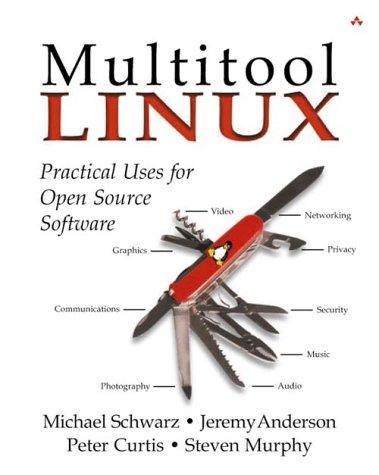
Multitool Linux: Practical Uses for Open Source Software
by
Michael Schwarz
,
Jeremy Anderson
and
Peter Curtis
Published 7 May 2002
I think not. www.slashdot.org "News for Nerds. Stuff that matters." Need I say more? Not really, but I'm going to. Have you ever tried to get to a page on a Web site only to get a "timed out" error from your browser? Chances are the network is acting funny, the Web site is poorly designed or not working, or the page you are trying to access is being "slash-dotted." Slashdot.org is so popular that when particularly interesting news blurbs appear, its readers have this knack of saturating the Web sites the news blurbs refer to. If you need a daily dose of techie news, Slashdot.org is definitely for you.

Practical OCaml
by
Joshua B. Smith
Published 30 Sep 2006
The first file is the lexer, which would go into a file named uri_lexer.mll and be compiled with the following: $ ocamllex uri_lexer.mll $ ocamlc –c uri_lexer.ml { open Uri_parser } 620Xch11final.qxd 9/22/06 12:37 AM Page 143 CHAPTER 11 ■ PRACTICAL: A URI LIBRARY rule token = parse "http://" { HTTP } | "mailto://" { MAILTO } | "file://" { FILE } | ':' { SEP } | ['/' '\\'] { PATHSEP } | '@' { AT } | eof { EOF } | (['a'-'z' 'A'-'Z' '0'-'9' '%' '^' '&' '*' '(' ')' '-' '_' '+' '=' '?' '<' '>' '|' '{' '}' '[' ']' '!' '.' ',']+ as st) { STRING(st) } { let lb = Lexing.from_string "http://www.slashdot.org/index.html";; let _ = let res = Uri_parser.main token lb in Printf.printf "[%s %s]" (fst res) (snd res);; } The next file (uri_parser.mly) is shown as follows. This is an ocamlyacc file that must be processed by ocamlyacc before being compiled (much like the preceding ocamllex file). $ ocamlyacc uri_parser.mly $ ocamlc –c uri_parser.mli $ ocamlc –c uri_parser.ml %token HTTP MAILTO FILE SEP PATHSEP AT EOF %token<string> STRING %start main %type<string * string> main %% main: http EOF { $1 } | file EOF { $1 } ; path: STRING { $1 } | PATHSEP STRING { $2 } | path PATHSEP { $1 ^ "/" } | path STRING { $1 ^ "/" ^ $2 } ; 143 620Xch11final.qxd 144 9/22/06 12:37 AM Page 144 CHAPTER 11 ■ PRACTICAL: A URI LIBRARY http: HTTP STRING path { ($2,$3) } | HTTP STRING AT STRING path { ($4,$5) } | HTTP STRING SEP STRING AT STRING path { ($6,$7) } ; file: FILE PATHSEP PATHSEP path { ("",$4) } ; mailto: MAILTO PATHSEP PATHSEP STRING AT STRING { ($4,$6) } ; After you process these two files, you can compile them to a single executable by simply calling the compiler on both of the generated .cmo files. $ ocamlc –o parse_test uri_parser.cmo uri_lexer.cmo $ .
…
. $ ocamlyacc uri_parser.mly $ ocamlc –c uri_parser.mli $ ocamlc –c uri_parser.ml %token HTTP MAILTO FILE SEP PATHSEP AT EOF %token<string> STRING %start main %type<string * string> main %% main: http EOF { $1 } | file EOF { $1 } ; path: STRING { $1 } | PATHSEP STRING { $2 } | path PATHSEP { $1 ^ "/" } | path STRING { $1 ^ "/" ^ $2 } ; 143 620Xch11final.qxd 144 9/22/06 12:37 AM Page 144 CHAPTER 11 ■ PRACTICAL: A URI LIBRARY http: HTTP STRING path { ($2,$3) } | HTTP STRING AT STRING path { ($4,$5) } | HTTP STRING SEP STRING AT STRING path { ($6,$7) } ; file: FILE PATHSEP PATHSEP path { ("",$4) } ; mailto: MAILTO PATHSEP PATHSEP STRING AT STRING { ($4,$6) } ; After you process these two files, you can compile them to a single executable by simply calling the compiler on both of the generated .cmo files. $ ocamlc –o parse_test uri_parser.cmo uri_lexer.cmo $ ./parse_test www. slashdot.org /index.html $ Conclusion With this code under your belt, you should be well on your way to actually solving problems with OCaml. You have created a module to handle URIs in a platform-independent manner, including filenames. A module like this creates the ability to improve code maintenance because you can make changes at the module layer for handling different URIs.
…
Notice it has to be fully qualified. Source code can be inlined like this: [val source_code_style: string -> int] Or preformated like this: {[ let source_code_string x = String.length x;; ]} {v Verbatim text can be added, though you may still have to escape certain text in verbatim blocks. v} {{:http://www.slashdot.org} this text can be a link} We can also make L{_a}T{^e}X look (almost) correct. *) 149 620Xch12final.qxd 150 9/22/06 12:39 AM Page 150 CHAPTER 12 ■ USING OCAMLDOC Figure 12-1. Code transformed into HTML Lists There are shortcuts available, but they should not be used to define nested lists.

Accelerando
by
Stross, Charles
Published 22 Jan 2005
Manfred takes it and heads for the back of the split-level bar, up the steps to a table where some guy with greasy dreadlocks is talking to a suit from Paris. The hanger-on at the bar notices him for the first time, staring with suddenly wide eyes: He nearly spills his Coke in a mad rush for the door. Oh shit, thinks Manfred, better buy some more server time. He can recognize the signs: He's about to be slashdotted. He gestures at the table. "This one taken?" "Be my guest," says the guy with the dreads. Manfred slides the chair open then realizes that the other guy – immaculate double-breasted Suit, sober tie, crew cut – is a girl. She nods at him, half-smiling at his transparent double take. Mr. Dreadlock nods.
…
Just then, a bandwidth load as heavy as a pregnant elephant sits down on Manfred's head and sends clumps of humongous pixilation flickering across his sensorium: Around the world, five million or so geeks are bouncing on his home site, a digital flash crowd alerted by a posting from the other side of the bar. Manfred winces. "I really came here to talk about the economic exploitation of space travel, but I've just been slashdotted. Mind if I just sit and drink until it wears off?" "Sure, man." Bob waves at the bar. "More of the same all round!" At the next table, a person with makeup and long hair who's wearing a dress – Manfred doesn't want to speculate about the gender of these crazy mixed-up Euros – is reminiscing about wiring the fleshpots of Tehran for cybersex.
…
Another fourteen months and the larger part of the cumulative conscious processing power of the human species will be arriving in silicon. And the first meat the new AIs get to know will be the uploaded lobsters. Manfred stumbles back to his hotel, bone-weary and jet-lagged; his glasses are still jerking, slashdotted to hell and back by geeks piggybacking on his call to dismantle the moon. They stutter quiet suggestions at his peripheral vision. Fractal cloud-witches ghost across the face of the moon as the last huge Airbuses of the night rumble past overhead. Manfred's skin crawls, grime embedded in his clothing from three days of continuous wear.

Mining the Social Web: Finding Needles in the Social Haystack
by
Matthew A. Russell
Published 15 Jan 2011
Example output with a threshold of 15 is shown in Table 5-1 but also displayed as a chart in Figure 5-1 so that you have a feel for the underlying distribution. Table 5-1. Entities sorted by frequency from harvested tweets by @timoreilly EntityFrequency #gov20 140 @OReillyMedia 124 #Ebook 89 @timoreilly 77 #ebooks 55 @slashdot 45 @jamesoreilly 41 #w2e 40 @gnat 38 @n2vip 37 @monkchips 33 #w2s 31 @pahlkadot 30 @dalepd 28 #g2e 27 #ebook 25 @ahier 24 #where20 22 @digiphile 21 @fredwilson 20 @brady 19 @mikeloukides 19 #pdf10 19 @nytimes 18 #fooeast 18 @andrewsavikas 17 @CodeforAmerica 16 @make 16 @pkedrosky 16 @carlmalamud 15 #make 15 #opengov 15 Figure 5-1.
…
Sample output from Example 5-5 displaying @mention tweet entities that are also friends of @timoreilly Number of user entities in tweets: 20 Number of user entities in tweets who are friends: 18 ahier pkedrosky CodeforAmerica nytimes brady carlmalamud pahlkadot make jamesoreilly andrewsavikas gnat slashdot OReillyMedia dalepd mikeloukides monkchips fredwilson digiphile Number of user entities in tweets who are not friends: 2 n2vip timoreilly All in all, there were 20 user entities who exceeded a frequency threshold of 15, and 18 of those turned out to be friends. Given that most of the people who appear in his tweets are also his friends, it’s probably safe to say that there’s a strong trust relationship of some kind between Tim and these individuals.
…
Most frequent entities appearing in retweets by @timoreilly; additional columns to illustrate normalization of retweet counts by @timoreilly EntityNumber of times @user retweeted by @timoreillyTotal tweets ever by @userNormalized retweet score @monkchips 30 33215 0.000903206 @ahier 18 14849 0.001212203 @slashdot 41 22081 0.0018568 @gnat 28 11322 0.002473061 @mikeloukides 15 2926 0.005126452 @pahlkadot 16 3109 0.005146349 @oreillymedia 97 6623 0.014645931 @jamesoreilly 34 4439 0.007659383 @dalepd 16 1589 0.010069226 So, who does Tim retweet/compliment the most? Well, not so surprisingly, his company and folks closely associated with his company compose the bulk of the list, with @oreillymedia coming in at the top of the pack.
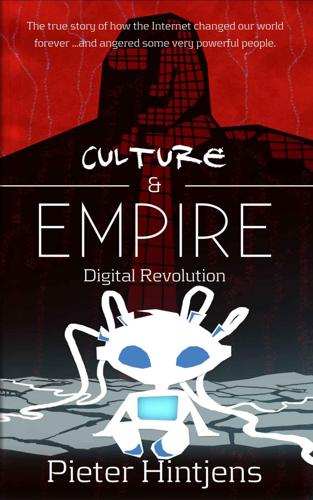
Culture & Empire: Digital Revolution
by
Pieter Hintjens
Published 11 Mar 2013
The Economic Quickening Without protectionism, Germany sells the precision instruments to produce the optics, Japan designs the semiconductors, Taiwan fabs the chips and the Chinese assemble them with equipment bought from the West. Everyone benefits, is employed, and makes enough money to buy a $10 camera. -- 1stworld, on Slashdot The economic impact of seven billion citizens joining digital society is vast and only just starting to be understood. Where this will take us is not clear. We can however already see the trends: All markets have more participants. In any given area of activity, the number of people who participate and compete has greatly increased.
…
Kisses in the Park "According to a Sydney Morning Herald article, the Australia government has decided to take the controversial step of having Internet service providers filter web content at the request of parents, in a crackdown on on-line bad language, pornography and child sex predators."--Slashdot front page, 9 August 2007 Having our thoughts held captive under the influence of propaganda only lasts for so long. We eventually clear our minds and realize that things are not quite right. For longer-lasting results, the men in charge have a more solid argument against freedom. I'm not talking about terrorism.
…
If you were leaving the Spanish Netherlands of 2030, metaphorically speaking, would you go to a country with more or less freedom? Freedom of Organization Azmeen said: "Although I'm a Linux person, I must say that yeah, Microsoft does receive a lot of stick from us open source folks. Of course, MS do get a lot of things right at least in the technological and UI aspects." -- Microsoft sock puppet on Slashdot, February 2008 As I explained in “Faceless Societies”, human society in all its richness can be seen as a truth-mining machine. There are of course many kinds of truths in addition to the physical facts for which science searches. For example, there are truths about problems, such as: "Congress is going to pass a bill that will allow censorship of any website."

You Are Not a Gadget
by
Jaron Lanier
Published 12 Jan 2010
The ascendant tribe is composed of the folks from the open culture/Creative Commons world, the Linux community, folks associated with the artificial intelligence approach to computer science, the web 2.0 people, the anticontext file sharers and remashers, and a variety of others. Their capital is Silicon Valley, but they have power bases all over the world, wherever digital culture is being created. Their favorite blogs include Boing Boing, TechCrunch, and Slashdot, and their embassy in the old country is Wired. Obviously, I’m painting with a broad brush; not every member of the groups I mentioned subscribes to every belief I’m criticizing. In fact, the groupthink problem I’m worried about isn’t so much in the minds of the technologists themselves, but in the minds of the users of the tools the cybernetic totalists are promoting.
…
Based on those data, you could conclude that it isn’t exactly anonymity, but transient anonymity, coupled with a lack of consequences, that brings out online idiocy. With more data, that hypothesis can be refined. Participants in Second Life (a virtual online world) are generally not quite as mean to one another as are people posting comments to Slashdot (a popular technology news site) or engaging in edit wars on Wikipedia, even though all allow pseudonyms. The difference might be that on Second Life the pseudonymous personality itself is highly valuable and requires a lot of work to create. So a better portrait of the troll-evoking design is effortless, consequence-free, transient anonymity in the service of a goal, such as promoting a point of view, that stands entirely apart from one’s identity or personality.

A Grand and Bold Thing: An Extraordinary New Map of the Universe Ushering
by
Ann K. Finkbeiner
Published 16 Aug 2010
And Wednesday morning, July 11, 2007, Lintott was interviewed on BBC’s Today, his three minutes sandwiched between a segment on female circumcision in Africa that had run overtime and an interview with the prime minister, Gordon Brown. Afterward Lintott went off to a conference at the Royal Astronomical Society. Meanwhile, the BBC put the story on their website and the Associated Press had picked it up, as had several blogs including Slashdot, a website that calls itself “News for Nerds.” Around noon, Lintott opened his laptop to see how the Galaxy Zoo website was doing, but he couldn’t get through to it. So he opened the Galaxy Zoo e-mail and found more than ten thousand e-mails, mostly from people complaining that they couldn’t get to the website.
…
Infinity (Gamow), 110 “open loop,” 80 Optical Sciences Center, 54 Oracle (software), 155 Orion nebula, 88 Orphan (star stream), 164 Ostriker, Jeremiah, 14, 19, 41, 42–44, 46, 48, 53, 71, 79–80, 89, 104, 153, 154, 155, 182 Owen, Russell, 51 Oxford University, 170 Padmanabhan, Nikhil, 144, 180 Pal 5 (Palomar 5, globular cluster), 105–6, 164 Pallas (asteroid), 160 Palomar Observatory, 153, 155 Palomar Observatory Sky Survey, 27–28, 169 Panoramic Survey Telescope and Rapid Response System (Pan-STARRS), 179 particle astrophysics, 36–37 Peebles, James, 21 pencil beam surveys, 156 Peoples, John, 37, 38–39, 75, 78, 90, 119–20, 129, 177–78 institutional conflicts and, 132–33, 138 retirement of, 138 PerkinElmer (contractor), 5 Peterson, Bruce, 13 photometric pipeline, 76, 121–22, 133, 134, 140, 151 Gunn on, 67 software crisis and, 62, 63–68 photometric telescope (PT), 89 photometry, 140–42 photons, 28, 187–89, 190 Pier, Jeff, 77–78 Pittsburgh, University of, 169 plug lab, 123 Polaris, 87, 101, 102–3, 109, 143 pointing problem and, 115–16 Prime Focus Universal Extragalactic Instrument (PFUEI), 15–16, 20–21, 93, 117 Princeton University, 8, 14, 36, 50, 79, 83–84, 95, 117, 125, 130, 138, 197 campus of, 41–42 institutional conflict and, 90, 132 LSST collaboration and, 179 photometric pipeline and, 65–68 Sloan archives and, 156 Sloan survey funding and, 47, 81 Sloan III and, 177 spectroscopic system and, 124, 126, 131–32 Principles of Operation (PoO), 44–45, 161, 179 protogalaxies, 190–91 protons, 137, 187–88 pulsars, 14, 42 quasars (quasi-stellar radio sources), 12–13, 14, 22, 26, 119, 135, 168, 192 BAL, 133 creation of, 191 Gunn-Peterson effect and, 13–14, 16, 137 high redshift, 106–7, 133, 136 quasar cut-off and, 15, 136–37 radio astronomy, 166–67 radio waves, 26, 166 redshift, 11–13, 17, 30, 74, 132, 136, 147 “Redshift Survey of Faint Field Galaxies,” 33 Rensselaer Polytechnic Institute, 180 Rice University, 10 Richardson, Bill, 47, 48–49 Richmond, Michael, 67–68, 74, 180 Roberts Express, 97 Rochester Institute of Technology, 180 Rockosi, Connie, 60–61, 93, 96, 99, 103, 105–6, 164, 180–81 background of, 94–95 first light and, 100–102 ROSAT (sky survey), 167 Rowland, Henry A., 49 Royal Astronomical Society, 171 Royal Swedish Academy of Sciences, 195 Rubin, Vera, 21 Sagittarius (constellation), 164 Sagittarius dwarf (galaxy), 164 Sargent, Wallace, 1 satellite galaxies, 163 Saturn (planet), 60 Schawinski, Kevin, 170, 171–72, 173 Schlegel, David, 124, 125, 140, 151, 180 background of, 125 photometric calibration and, 141–44 spectroscopic pipeline and, 131–32 spectroscopic system and, 124, 126–29 Schmidt, Maarten, 12–13, 14, 15, 16, 26, 27, 34, 136 Schneider, Don, 1–2, 16, 39, 136 Schramm, David, 17, 37 Science (magazine), 175 SDSS Supernova Survey, 177 SDSS Turtle, 97 Sekiguchi, Maki, 55, 93 Shapiro, Harold, 45 Siegmund, Walt, 51 Simonyi, Charles, 157 singularity, 190–91 Sky & Telescope, 10 SkyServer (website), 158, 172, 173 using, 159–60 Slashdot (website), 171 Sloan Digital Sky Survey: archives of, see Sloan survey archives astronomy’s culture and, 186 background of, 29–30 camera of, see Sloan survey camera code-writing postdocs and, 139–40 costs of, 45–46, 56, 82, 83 directors of, 75–78, 83–85, 86, 129–30, 138 documentary on, 175–76 early data release and, 138, 158, 160–61 first data flow of, 105–6 first full meeting of, 55 first light presentation of, 104–5 funding of, 34–37, 42–43, 45–49, 119–20 idea for, 6, 33–34 institutional conflict and, 131–33 last scan of, 176 management crisis of, see management crisis media and, 45, 105 names of, 45 in New York Times, 45 official beginning of, 133 O’Hare meetings on, 35 Principles of Operation (PoO) of, 44–45, 161, 179 publication list of, 168 skepticism about, 73–74 small redshift survey proposal and, 74 software of, see software crisis telescope of, see Sloan survey telescope test year of, 56 in textbooks, 175 Two-degree Field (2dF) project and, 74–75 universe’s structure mission of, 144–45, 151 UW engineers and, 48–52, 54–55, 56, 76, 77, 82 Sloan Digital Sky Survey II, 177, 194 Sloan Digital Sky Survey III, 177–78, 194 Sloan Extension for Galactic Understanding and Exploration (SEGUE), 177 Sloan Foundation, 41, 46–47, 52, 55, 57, 83, 120 Sloan survey archives, 154–74 Galaxy Zoo and, 170–72, 173 hosting issue and, 155 Intel grant for, 158 Johns Hopkins and, 155–56 Microsoft and, 157–59 nonastronomers and, 169 public access to, 156, 158 Sky Server website and, 158, 159–60, 172, 173 software for, 155–58 users of, 165–66 using, 159–60 virtual astronomy and, 166 zooites’ use of, 171–74 Sloan survey camera, 59–60 Carr and, 93–94, 96–97 complexity of, 95 filters in, 96 housing coolant of, 95–96 installation of, 99 lateness problem and, 61, 81 remounting of, 127–28 shipped to Apache Point, 97–98, 99 spectrographs mounted behind, 122 testing of, 100 Sloan survey telescope: cracked secondary mirror of, 117–19 first data flow from, 105–6 first light and, 100–103, 109 first years’ data from, 117 Leger as telescope engineer of, 110–11 media and, 105 mirror baffles of, 109–10 mirrors of, 61, 76, 100, 117–19 moth problem of, 113–15 night log of, 111–13 observers’ checklist for, 111, 113 observers in charge of, 111–12 photometric calibration of, 141–44 pointing problem of, 115–16, 119 primary mirror, problems of, 52–54 software problem of, 117 thermal disappearance of, 110 tracking problem of, 116–17, 119 ubercal code and, 143–44 Small Magellanic cloud, 31 small redshift survey (SRS), 74 Smee, Steve, 49, 88, 121–22 Snedden, Stephanie, 112 software crisis, 61–71, 76, 105 astrometric pipeline and, 62 e-mail archive and, 64–66 Fermilab and, 62, 65–68 lateness problem and, 61, 79 Lupton and, 64–66 missed deadlines and, 67 Nash Committee and, 70–72 photometric pipeline and, 62, 63–68 postdocs problem and, 62–63, 69–70 target selection pipeline and, 64 working-group professors and, 70–71 writers and, 68–69 solar system, 31, 134, 160, 177 formation of, 192 Space Telescope Science Institute, 47, 83, 88, 155, 175, 176 spectrographs, 23–24, 32, 49, 85, 105–6, 121–23 spectroscopic pipeline, 62, 133 Schlegel and, 131–32 spectroscopic system, 121–31 data processing required for, 122–23 fiber mapper of, 126–31 first test of, 122 operation of, 123–24 plug lab and, 123 Princeton and, 124, 126, 131–32 Schlegel and, 124, 126–29 spectro-1D, 131–32, 133, 151 spectro-2D, 131, 151 Spergel, David, 194 spiral galaxies, 182–83, 185, 191 Spitzer, Lyman, 33 Spitzer (space telescope), 169 SQL (Structured Query Language) Server, 157–58, 173 standard candles, 18–19, 63, 148–49 Stardust@Home project, 170 stars: asymptotic giant branch, 176 binary, 14 brightness of, 141 classification of, 14 color-color diagram of, 106 dwarf, 133, 135–36 in early universe, 190 FK 5, 115 Gliese 229, 135 halo, 162 lifetimes of, 192 streams of, 164–65 temperature range of, 135 Stars for Sam, The (Reed), 8 star streams, 164–65 steady state theory, 9–10 Strauss, Michael, 56, 64, 84–85, 86, 106–7, 119, 121, 133, 135, 136, 141, 150, 180, 182 Styx (star stream), 164 SubbaRao, Mark, 132 superclusters, 32, 144 in universal network, 145 Superconducting Super Collider (SSC), 38, 78 supernovae, 14, 63 as standard candle, 148–49 Survey Telescope Project, see Sloan Digital Sky Survey surveys, astronomical, 25–29 Szalay, Alex, 74, 155–57, 158, 166, 167, 169, 170 Szalay, Tamas, 158 target selection pipeline, 64, 122 Tektronix company, 56 TerraServer (website), 157 Thakar, Ani, 158 Theoretical Astrophysics Group, 37–38 thermonuclear fusion, 189–90 3C 273 (radio source), 12 Threeons, 178 tidal tails, 164 tiger teams, 79–80, 81, 82 Time, 10–11 Tinsley, Beatrice, 17, 18–19 titanium oxide, 136 Today (BBC), 171 Tool Command Language (Tcl), 65 Tremaine, Scott, 19 Tremonti, Christy, 183 Turner, Michael, 37, 70, 73, 89–90, 138, 148 Two-degree Field (2dF) project, 74–75, 145, 167 limitations of, 75 2MASS (sky survey), 166–68 2.5-Meter Survey Telescope, see Sloan Digital Sky Survey ubercal (ubercalibration) code, 143–44, 147, 151 ultraviolet astronomy, 166–67 ultraviolet waves, 27, 137, 182, 190 “Unbound Universe?

Industrial Internet
by
Jon Bruner
Published 27 Mar 2013
Silicon Valley and industry adapting to each other Nathan Oostendorp thought he’d chosen a good name for his new startup: “Ingenuitas,” derived from the Latin for “freely born” — appropriate, he thought, for a company that would be built on his own commitment to open-source software. But Oostendorp, earlier a co-founder of Slashdot, was aiming to bring modern computer vision systems to heavy industry, where the Latinate name didn’t resonate. At his second meeting with a salty former auto executive who would become an advisor to his company, Oostendorp says, “I told him we were going to call the company Ingenuitas, and he immediately said, ‘bronchitis, gingivitis, inginitis.
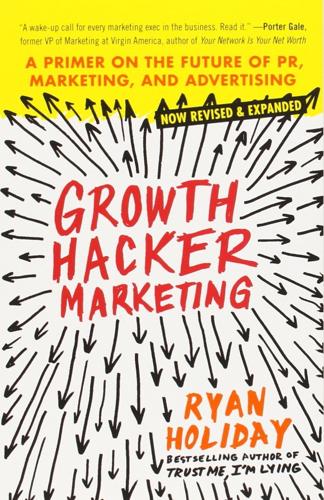
Growth Hacker Marketing: A Primer on the Future of PR, Marketing, and Advertising
by
Ryan Holiday
Published 2 Sep 2013
In an effort to drive these sign-ups, the founders crafted a demo video that walked potential users through the service. They didn’t hire some production company to produce an expensive or elaborate video that they jammed down people’s throats through widespread ads. They made the video themselves and they made the right one for the right place. Knowing the outlets where they intended to post the video (Digg, Slashdot, and Reddit), they filled it with all sorts of allusions and references that those communities would love. As a result, this homemade video was enormously popular with these potential users. It immediately made the respective front pages, it drove hundreds of thousands of new visitors to the special page Dropbox had set up for this purpose (GetDropbox.com), and the waiting list went from 5,000 users to 75,000 users nearly overnight.

Googled: The End of the World as We Know It
by
Ken Auletta
Published 1 Jan 2009
He explained how to make a reed for a clarinet, how to file and test and tweak it so the musical tone was clear and warm. Brin listened, then quickly moved on to his second question: “Have you ever heard of Slashdot?” Slashdot was a technology news site that encouraged user-generated comments, a pioneer of what came to be known as blogging. Krane smiled and pulled from his pocket a geeky badge of honor: a Palm 7, which permitted a wireless Internet connection to one of his favorite sites, Slashdot .com. “I thought,” said Krane, “I had aced the interview!” Brin shook hands and left, and Page entered. “He greeted me in a very reserved way. He asked me the equivalent of a tell-me-about-yourself ice-breaker question.”

Makers at Work: Folks Reinventing the World One Object or Idea at a Time
by
Steven Osborn
Published 17 Sep 2013
Contents Foreword About the Author Acknowledgments Introduction Chapter 1: Erik Kettenburg, Founder, Digistump Chapter 2: David Merrill, Cofounder, Sifteo Chapter 3: Nathan Seidle, CEO, SparkFun Electronics Chapter 4: Laen, Founder, OSH Park Chapter 5: Zach Kaplan, Founder and CEO, Inventables Chapter 6: Emile Petrone, Founder, Tindie Chapter 7: bunnie Huang, Founder, bunnie studios Chapter 8: Natan Linder, Founder, Formlabs Chapter 9: Ben Heck, Host, The Ben Heck Show Chapter 10: Becky Stern, Director of Wearable Electronics, Adafruit Industries Chapter 11: Eric Stackpole, Cofounder, OpenROV Chapter 12: Eben Upton, Founder, Raspberry Pi Foundation Chapter 13: Catarina Mota, Founder, OpenMaterials.org Chapter 14: Ward Cunningham, Inventor, Wiki Chapter 15: Jeri Ellsworth, Founder, Technical Illusions Chapter 16: Sylvia Todd, Maker, Sylvia’s Super Awesome Maker Show! Chapter 17: Dave Jones, Host, EEVBlog Chapter 18: Bre Pettis, CEO, MakerBot Chapter 19: Eric Migicovsky, CEO, Pebble Technology Chapter 20: Ian Lesnet, Slashdot Troll, Dangerous Prototypes Chapter 21: Massimo Banzi, Cofounder, Arduino Index Foreword During the past few years, a remarkable phenomenon—the Maker Movement—has emerged. For two decades, humans have been immersed in creating new things based on bits. The Internet has woven itself into the fabric of everything we do.
…
Osborn: That’s pretty cool. I’m really interested to see what sort of applications people come up with for it. Thanks for your time, Eric. 1 www.youtube.com/watch?v=qVZDx86Ft0o 2 Software development kit. 3 http://ycombinator.com 4 http://supermechanical.com 5 http://selfstarter.us CHAPTER 20 Ian Lesnet Slashdot Troll Dangerous Prototypes Ian Lesnet is an entrepreneur and electrical engineer who has lived and worked in cities all over the world. Ian has written about his open-hardware electronics projects on many popular electronics blogs, including DIY Live and Hack a Day. He is the owner and creator of Dangerous Prototypes (dangerousprototypes.com), an electronics blog with a focus on DIY electronic projects and tools.
…
That board fascinates me. Osborn: That wraps up my questions. I love your insight on manufacturing in China and learning about the history behind the Bus Pirate. One piece of front matter I have left is I don’t have a title for you. Should it be “founder,” “blogger,” “CEO”? Lesnet: Really, I prefer “Slashdot troll.” That’s usually what I tell people. I don’t think of myself as a CEO, nor as a blogger. I just like to play with electronics, and I’m lucky enough to be here doing it. Osborn: What about “founder”? Lesnet: Well, that’s okay. That sounds very technical, though. There are so many founders.

Cancel Cable: How Internet Pirates Get Free Stuff
by
Chris Fehily
Published 1 Feb 2011
Lots of resentment to feed off. A how-to book. Who’ll publish it? The mainstream cowards won’t touch it. What the hell are these people clapping for now? Maybe I’ll self-publish and astroturf a story about being oppressed by Big Media. The idiots at the news aggregators always fall for that. Need to post a fake review on Slashdot. That works like a house on fire for O’Reilly. Position it as a gift that under-30s can give to their clueless parents. Maybe I’ll get sued and the whole thing will go Streisand. Some geezer singing. What the? You’ve Got a Friend in Me? Let me out. Chapter 2 – Understanding BitTorrent BitTorrent is the most popular communications protocol (set of standard rules) that pirates use to exchange files over the internet.

The Data Revolution: Big Data, Open Data, Data Infrastructures and Their Consequences
by
Rob Kitchin
Published 25 Aug 2014
Strohm, C. and Homan, T. (2013) ‘NSA spying row in Congress ushers in debate over big data’, Bloomberg, 25 July, http://www.bloomberg.com/news/2013-07-25/nsa-spying-row-in-congressushers-in-debate-over-big-data.html (last accessed 25 July 2013). Strom, D. (2012) ‘Big data makes things better’, Slashdot, 3 August, http://slashdot.org/topic/bi/bigdata-makes-things-better/ (last accessed 24 October 2013). Sword, K. (2008) ‘Contribution to: The Promise of Digital History’ (roundtable discussion), Journal of American History, 95(2): 452–91. Taleb. N. (2012) Antifragile: Things That Gain From Disorder. Random House, New York.
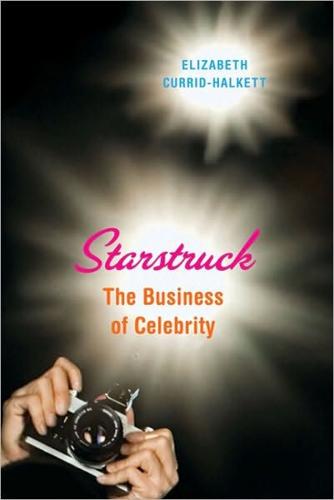
Starstruck: The Business of Celebrity
by
Currid
Published 9 Nov 2010
Maynard, a computer programmer and denizen of Fairmont, Minnesota (population 11,000), went from geek to Internet celebrity after pictures of him in a luminescent costume inspired by the Disney science-fiction movie Tron showed up all over the Internet. Maynard actually never intended on becoming a celebrity but capitalized on his star power when it came around. “I think everyone wants to become famous kind of idly. I never expected to become famous,” he said. “What happened was that I submitted a story to Slashdot [a technology news website]. It was a follow-up to other stories about other Tron fan costumes…I thought maybe a couple of people would be interested…The story just spread across the Internet instantly…People were making pretty seriously derogatory comments. Like ‘that guy in spandex.’ They didn’t think that anybody that was my shape should ever put on tights.
…
Ono, Yoko Oppenheimer, Jerry Oscars, see Academy Awards Owl and Weasel (newsletter) Oxford University Page, Larry Pakistan Palencia, Francisco Palin, Sarah Paltrow, Gwyneth paparazzi Paramount Pictures Pareto Principle Paris Park City (Utah) Parliament, British participatory culture path dependency Pattinson, Robert Peake, John Penguin Press Penn, Sean People for the Ethical Treatment of Animals (PETA) People magazine PepsiCo PerezHilton.com; see also Hilton, Perez personal digital assistant (PDA) applications Pew Research Center Peyton-Jones, Julia Phoenix, River Physical Impossibility of Death in the Mind of Someone Living, The (Hirst) Picasso, Pablo Pinsky, Drew Pitt, Brad Pittsburgh Playboy Polaroid Scene Politico newspaper and blog politics; academic; British; celebrity residual in; geography of stardom and; networks in Ponzi schemes pop art Popeye Series (Koons) Pop Idol (TV show) Pop magazine Portman, Natalie Posen, Zac Price, Katie (“Jordan”) Princeton University Proenza fashion house Project Runway (TV show) publicists; democratic celebrities and; fees of; geography of stardom and; lack of, in Bollywood Puppy (Koons) Putnam, Robert Queen Latifah Radar magazine Rainie, Lee RateMyProfessors.com Ravid, Gilad RCA Records Reader, The (film) reality TV; British; financial celebrities on; narcissism of; relative celebrities on; stars of; see also specific shows Real Madrid Real World, The (TV show) Reed, David Reed, Lou Reid, Tara Rein, Irving Reinhardt, Doug relative celebrities; in academia; in art world; characteristics of,; mainstream celebrities versus; networks of Reliance film company Renaissance Technologies Republican Party residual, see celebrity residual Reuters Reynolds, Jamie Richards, Mark Richter, Gerhard Ripa, Kelly Ritchie, Guy Rivera, Mariano Roberts, Julia Rodarte fashion house Rodriguez, Alex (A-Rod) ROFLCon Rogers and Cowan Rolling Stone Roman Empire Romer, Paul Ronaldinho (Ronaldo de Assis Moreira) Ronaldo, Cristiano Ronson, Samantha Rose, Jessica Rosen, Sherwin Rosenfield, Stan Ross, Andrew Roubini, Nouriel Rousing, Hans Rousseau, Jean-Jacques Royal Festival Hall (London) Ruscha, Ed Ruth, Babe Saatchi, Charles Sachs, Jeffrey Salomon, Rick Salomon Brothers Samuels, David Sandler, Adam San Francisco 49ers São Paulo, traffic in Schouler fashion house Schroeder, Alice Science magazine Scientific American Scientologists Scorsese, Martin Scotland Seacrest, Ryan Seattle Mariners Secret Service Sedgwick, Edie Seipp, Catherine Senate, U.S. Serpentine Gallery (London) Shaw, David short message service (SMS) text messaging Sigler, Jamie-Lynn Silicon Valley Simons, James Simple Life, The (TV series) Simpson, O. J. Sinatra, Frank Sitrick, Michael Slashdot Slumdog Millionaire (film) Smart, Barry Smith, Will Snowball (Schroeder) soccer Soccernomics (Kuper and Szymanski) Social Issue Research Center social media; democratic celebrities and; see also Facebook; MySpace; Twitter social networks; in Bollywood; see also networks, celebrity Solow, Robert M.

Here Comes Everybody: The Power of Organizing Without Organizations
by
Clay Shirky
Published 28 Feb 2008
Jehovah’s Witnesses enjoy advantages similar to those of other Christian sects, but ex-Witnesses turn to Meetup because they don’t enjoy that kind of socially supported coordination. The second category of Meetup groups includes the members of websites and services who would like to assemble with other users of those services in real life. This group includes Slashdot, LiveJournal, Bloggers, Fark, Ultima, and Bookcrossing. (Interestingly, the numbers show how clustered these groups are; though Slashdot and LiveJournal had more members than Witches did, they met in fewer cities; or put another way, Witches are more evenly distributed in U.S. society than are geeks or bloggers.) This is what the end of cyberspace looks like: the popularity of these Meetup groups suggests that meeting online isn’t enough and that after communicating with one another using these various services, the members become convinced that they share enough to want to get together in the real world.

Reinventing Discovery: The New Era of Networked Science
by
Michael Nielsen
Published 2 Oct 2011
The most obvious benefit of widespread open access is to individual citizens: no more restrictions on the ability of people suffering diseases to download the latest research! But over the long run an even bigger benefit of open access will be that it enables the creation of other institutions bridging science and the rest of society. We’re already starting to see this happen. For example, user-generated online news sites such as Digg and Slashdot routinely link to the latest research in the arXiv and PLoS and other open access sources. These news sites enable ordinary people to collectively decide what the news is, and provide a space where they can discuss that news. Often, what people choose to discuss includes the latest papers at the arXiv on subjects such as cosmology and quantum teleportation, or the latest papers at PLoS on subjects such as genetics and evolutionary biology.
…
See scoring Simon, Herbert, 217, 223 Sinclair, Cameron, 46 Singh, Simon, 165–67 Skilling, Jeffrey, 165 Skunk Works, 36 Skype video chat, 41 sky surveys, 98 of Hipparchus, 104 of Large Synoptic Survey Telescope, 107, 151 of Palomar Observatory, 102 of Ptolemy, 98, 102, 104. See also Sloan Digital Sky Survey (SDSS) Slashdot, 163 Sloan Digital Sky Survey (SDSS), 96–105 data-driven intelligence and, 112, 114 data sharing by, 102–5, 108–10, 181 data web and, 111 Galaxy Zoo’s use of, 138, 139, 140 new pattern of discovery and, 106–7 potential of networked science and, 175 Schawinski’s use of, 134 spectra of galaxies in, 138 Sloan Great Wall, 97, 99, 100, 112, 116 small contributions, 33, 48, 63–64, 227.

Gaming the Vote: Why Elections Aren't Fair (And What We Can Do About It)
by
William Poundstone
Published 5 Feb 2008
Last Man Standing 219 Orange County· John Wayne· American machismo· the Condorcet winner· Linux • Markus Schulze· CSSD • Wikipedia • trolls· Queen Elizabeth· Kim Jongil • sarcasm· simplicity· Ka-Ping Yee· Microsoft Windows· manipulative behavior • how ro prevent carjacking· Mathematics Awareness Week • lain Mclean· permanent pointlessness 231 14. Hot or Not? Hanging out· James Hong· Jim Young· gene survival· speed dating· Silicon Valley· Slashdot • Playboy· Michelin ratings· range voting· the Internet Movie Database· The Seventh Seal· Jennifer Anisron • cheating· Warren D. Smith· Bayesian regret· ignorance· honesty· guilt· quasi-spiritual acts· honeybees· Jan Kok • number phobia· pop culture 250 15. Present but Not Voting This Is Spinal Tap· Jeremy Bentham· faulty embalming· Lionel Robbins· eBay • Claude Hillinger • socialism· John Harsanyi • fiddling while Rome burns· what the impossibility theorem really means THE REALITY 261 16.
…
In October 2000, Young and Hong sent e-mails to friends telling them about the site. Pictures poured in, and site visits grew exponentially. On the eighth day, the site got 1.8 million hits. By early 2001, NetNielson listed it as one of the top twenty-five sites for Web advertising. It was soon being written up in Slashdot and Playboy. By adding the matchmaking feature, the site went commercial. Hong, now the site's CEO, reports that about a marriage a day results from people who meet on the site. More than twelve 232 Hot or Not? billion votes have been cast. That is more than four times the votes cast in every presidential election in the history of the United States.
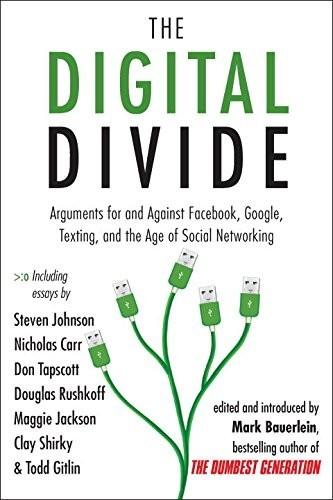
The Digital Divide: Arguments for and Against Facebook, Google, Texting, and the Age of Social Netwo Rking
by
Mark Bauerlein
Published 7 Sep 2011
Taking their cue from old-school Internet discussion groups like Usenet, websites such as MetaFilter let people begin discussions about almost anything they’ve found online. Each conversation begins with a link, then grows as far as its participants can take it. This is the real beauty of hypertext, and it’s finally catching on. Although hackers have used bulletin board interfaces on sites such as Slashdot since the Web’s inception, more commercially minded endeavors—e.g., Plastic—are adopting the same model to generate dialogues about culture and media. On Yahoo! the biggest growth area is conversation. Yahoo! Groups, a set of bulletin board discussions and mailing lists, contains thousands of the best discussions happening online—and almost all of them have been started by real people.
…
Seinfeld (television series) Self-portraits Self-publishing Self-realization Self-sufficiency Semantic priming Semiotic democracy Sensory deprivation September 11, 2001 terrorist attacks Serialization SERP. See Search Engine Results Page Sesame Street Shakesville (blog) Shirky, Clay Shoutcast Simulations Six Degrees: The Science of a Connected Age (Watts) Skrenta, Rich “Skyful of Lies” and Black Swans (Gowing) Slashdot Slatalla, Michelle Slate (magazine) Sleeper Curve Slingbox SLVR phone Small world experiment Social currency Social graph Social media Social mind The Social Network (film) Social networking sites. See also specific sites activism and advertising on amount of users on development of identity setup on learning and marketing on politicians on privacy dangers and self-exposure through self-portraits on spam on weak ties on Social rules and norms Social saturation Social skills Socrates Solitude Sony Soundscape, cell phones and SourceForge.net South Korea Spamming, on social network sites Speech recognition Speed, Net Geners and Spengler, Oswald Splash screens Spotlight (blog) Squarciafico, Hieronimo Standage, Tom Starbucks Starkweather, Gary Star Trek (television series) Star Wars Stone, Linda Street Fighter II (video game) “The Strength of Weak Ties” (Granovetter) StyleDiary.net Suburbanization Sundance Resort Suriowecki, James Survival of the fittest Survivor (television series) Swados, Harvey Swarm intelligence Switch costs Tagging TakingITGlobal Task management Task switching Taylor, Frederick Winslow Teachout, Zephyr Techgnosis Technics and Civilization (Mumford) Techno-brain burnout Technology Education and Design (TED) Technomadicity Technorati TED.

Getting Real
by
Jason Fried
,
David Heinemeier Hansson
,
Matthew Linderman
and
37 Signals
Published 1 Jan 2006
Also, get a site up where you can collect emails from folks who are interested. At this stage, you should also start seducing mavens and insiders. These are the folks on the cutting edge. They're the tastemakers. Appeal to their vanity and status as ahead-of-the-curvers. Tell them they're getting an exclusive sneak preview. If a site like Boing Boing, Slashdot, or Digg links up your app, you'll get loads of traffic and followers. Plus, your page rank at Google will go up too. Preview A few weeks ahead of launch, start previewing features. Give people behind-the-scenes access. Describe the theme of the product. For Basecamp, we posted screenshots and highlighted reminders, milestones, and other features.
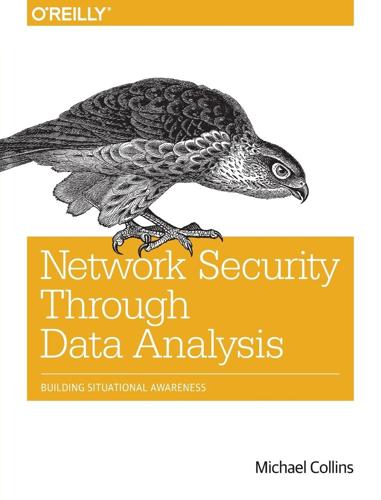
Network Security Through Data Analysis: Building Situational Awareness
by
Michael S Collins
Published 23 Feb 2014
This, in turn, increases the resources the attacker needs to take out a single defender. With DoS attacks, the most common false positives are flash crowds and cable cuts. A flash crowd is a sudden influx of legitimate traffic to a site in response to some kind of announcement or notification. Alternate names for flash crowds such as SlashDot effect, farking, or Reddit effect provide a good explanation of what’s going on. These different classes of attacks are usually easily distinguished by looking at a graph of incoming traffic. Some idealized images are shown in Figure 12-7, which explain the basic phenomena. Figure 12-7. Different classes of bandwidth exhaustion The images in Figure 12-7 describe three different classes of bandwidth exhaustion: a DDoS, a flash crowd, and a cable cut or other infrastructure failure.
…
built-in documentation, Choosing and Formatting Output Field Manipulation: rwcut, Basic Field Manipulation: rwfilter combining information flows with rwcount, Combining Information Flows: rwcount counting values with rwuniq, rwuniq creating IP sets with wrset, rwset and IP Sets data collection with rwptoflow, rwptoflow data collection with YAF, YAF data conversion with rwtuc, rwtuc installation of, Acquiring and Installing SiLK metadata access with rwfileinfo command, rwfileinfo and Provenance output field manipulation formatting, Choosing and Formatting Output Field Manipulation: rwcut storage structure of rwbag, rwbag subnetwork association with pmaps, pmaps SIM/SEM/SIEM (security information/event management), Basic Vocabulary simple math, Writing Functions situational awareness definition of, Preface foundation of, Network Mapping Slammer worm, Basic Vocabulary SlashDot effect, DDoS and Routing Infrastructure SMTP (Simple Mail Transfer Protocol) banners in, Non-Web Banners clustering coefficient and, Clustering Coefficient failure rate in, Automation fumbling behaviors and, SMTP Fumbling log file formats in, SMTP smurf attacks, DDoS and Routing Infrastructure snaplen (-s) argument, Limiting the Data Captured from Each Packet Snort, Basic Vocabulary, Enhancing IDS Detection SOA (Start of Authority) records, Forward DNS Querying Using dig, Forward DNS Querying Using dig software updates, Beaconing solid state storage (SSD), A Brief Introduction to NoSQL Systems Solr, A Brief Introduction to NoSQL Systems Spam and Open Relay Blocking System (SORBS), DNSBLs spam, fumbling behaviors and, SMTP Fumbling SpamCop, DNSBLs Spamhaus, DNSBLs spatial dependencies, Creating a Well-Organized Flat File System: Lessons from SiLK spatial locality, Locality spear-phishing attacks, SMTP Fumbling specificity, Classifier Failure Rates: Understanding the Base-Rate Fallacy spiders, HTTP Fumbling spreads, Identifying Servers src host predicate, Filtering Specific Types of Packets src-reserve field, pmaps standard deviations, The Quantile-Quantile (QQ) Plot start-rec-num command, Choosing and Formatting Output Field Manipulation: rwcut statistical analysis, An Introduction to R for Security Analysts (see also R for Security Analysts) five-number summary, The Five-Number Summary and the Boxplot threshold values, Exploratory Data Analysis and Visualization, The Quantile-Quantile (QQ) Plot, Using Volume as an Alarm variables, Variables and Visualization, Histograms stream reassembly, Domains: Determining Data That Can Be Collected streaming processing, What Storage Approach to Use subversion attacks, Attack Models Suricata, Basic Vocabulary sweeping ping, Checking Connectivity: Using ping to Connect to an Address switch statements, Conditionals and Iteration Symantec’s Security Response, The NVD, Malware Sites, and the C*Es SYN Flood, DDoS, Flash Crowds, and Resource Exhaustion syslog logging utility, Syslog System for Internet-Level Knowledge (see SiLK) System Log, Accessing and Manipulating Logfiles system.log files, Accessing and Manipulating Logfiles T table command, Contingency Tables tcp predicate, Filtering Specific Types of Packets TCP sockets fumbling behaviors, Identifying Fumbling redirecting output to with netcat, netcat TCP/IP (transmission control protocol/internet protocol) asymmetric sessions and, Phase II: Examining the IP Space port number/flag filtering in, Filtering Specific Types of Packets, TCP Options port numbers in, Port Number, Port Number sensor domains and, Network Layering and Its Impact on Instrumentation TCP (protocol 6), Packet and Frame Formats TCP state machine, TCP Fumbling: The State Machine tcpdump active banner grabbing with, Application Identification by Banner Grabbing Berkeley Packet Filtering (BPF), Filtering Specific Types of Packets data capture with, Packet Data filtering with, Filtering Specific Types of Packets, Helper Options MAC adresses and, Filtering Specific Types of Packets record manipulation with Scapy, Scapy rolling buffer implementation, Rolling Buffers snaplen (-s) argument, Limiting the Data Captured from Each Packet technique-extract-analyze process, EDA Workflow template-based NetFlow, “Flow and Stuff:” NetFlow v9 and IPFIX templated data logs, Existing Logfiles and How to Manipulate Them temporal locality, Locality text converting to columns, Existing Logfiles and How to Manipulate Them drawing on a plot, Annotating a Visualization The Threat Center, The NVD, Malware Sites, and the C*Es threshold values, Exploratory Data Analysis and Visualization, The Quantile-Quantile (QQ) Plot, Using Volume as an Alarm Thrift, Creating a Well-Organized Flat File System: Lessons from SiLK time series data, Data Selection time-to-live (TTL) value, Network Layers and Vantage, Tracerouting, Identifying NATs tools aggregation/transport, Actions: What a Sensor Does with Data classification/event, Classification and Event Tools: IDS, AV, and SEM–Prefetching Data communications/probing, Communications and Probing packet inspection/reference, Packet Inspection and Reference–Search Engines, Mailing Lists, and People R for Security Analysts, An Introduction to R for Security Analysts–Testing Data reference/lookup, Reference and Lookup: Tools for Figuring Out Who Someone Is–DNSBLs SiLK (System for Internet-Level Knowledge), The SiLK Suite–rwtuc visualization, Visualization traceroute tool, Tracerouting traffic logs (see logs) traffic volume (see volume/time analysis) transmission control protocol/internet protocol (see TCP/IP) transport tools, Actions: What a Sensor Does with Data trellis plots, Multivariate Visualization trendlines, Rule three: use trendlines, distinguish artifacts from observations TripWire, Basic Vocabulary Type I Errors (see false-positive alerts) Type II Errors (see false-negative alerts) U UDP (User Datagram Protocol) accessing port numbers in, Filtering Specific Types of Packets, Port Number, Port Number fumbling behaviors and, Identifying UDP Fumbling identifying servers in, Identifying Servers redirecting socket output to with netcat, netcat UDP protocol 17, Packet and Frame Formats udp predicate, Filtering Specific Types of Packets unidirectional flow filtering, Unidirectional flow filtering uniform distribution, The Quantile-Quantile (QQ) Plot univariate visualization bar plots, Bar Plots (Not Pie Charts) boxplots/box-and-whiskers plots, The Five-Number Summary and the Boxplot five-number summary, The Five-Number Summary and the Boxplot histograms, Univariate Visualization: Histograms, QQ Plots, Boxplots, and Rank Plots Quantile-Quantile (QQ) plots, The Quantile-Quantile (QQ) Plot Unix basic shell commands, What Is SiLK and How Does It Work?

Superminds: The Surprising Power of People and Computers Thinking Together
by
Thomas W. Malone
Published 14 May 2018
Ridgeway, “Status Hierarchies and the Organization of Collective Action,” Sociological Theory 30, no. 3 (2012): 149–66, doi:10.1177/0735275112457912. 3. The story of Wikipedia’s beginnings has been recounted in numerous places. See Wikipedia, s.v. “history of Wikipedia,” accessed July 6, 2016, https://en.wikipedia.org/wiki/History_of_Wikipedia; Larry Sanger, “The Early History of Nupedia and Wikipedia: A Memoir,” Slashdot, April 18, 2005, https://features.slashdot.org/story/05/04/18/164213/the-early-history-of-nupedia-and-wikipedia-a-memoir; Marshall Poe, “The Hive: Can Thousands of Wikipedians Be Wrong? How an Attempt to Build an Online Encyclopedia Touched off History’s Biggest Experiment in Collaborative Knowledge,” Atlantic Monthly, September 2006, 86–94, http://www.theatlantic.com/magazine/archive/2006/09/the-hive/5118. 4.

Traffic: Genius, Rivalry, and Delusion in the Billion-Dollar Race to Go Viral
by
Ben Smith
Published 2 May 2023
Some forwarded it from there—it was the kind of slacker anti-corporate joke that hit at the complacent end of the Clinton era. On January 17, Jonah’s old roommate from New Orleans, Tim Shey, put the text of the exchange on his personal website, something people were starting to call a blog. Then bigger websites, like MetaFilter and Slashdot, picked it up. Over the next few weeks, the email traveled from inbox to inbox, a catchy little corporate protest. Pretty soon Jonah was getting emails from newspaper reporters and, then, a booker for the biggest morning television program in America, the Today show. On February 28, 2001, just six weeks after he forwarded that first email, Jonah was sitting nervously on a gray couch in Rockefeller Center in a gray wool Calvin Klein jacket that was too big at the shoulders and not quite long enough for his long arms.
…
See also sex tapes and sexual content Porteous, Will, 127, 128, 152, 283 Powell Jobs, Laurene, 284–86 presidential elections, 106, 158–59 The Price Is Right, 292 privacy rights, 63, 85, 141, 232, 262 ProPublica, 196 Proud Boys, 290 public relations, 238 Pulitzer Prizes, 220, 230 Punk’d, 124 Putin, Vladimir, 257 Pyra, 17–18 Q Quail Hunting with Dick Cheney (game), 72 quizzes, 203–4, 206, 208, 239, 253, 267, 271 R racism and racial dynamics, 6, 93, 101, 126, 134–35, 187, 271, 274–75, 293 Rao, Samir, 284 Ratnesar, Romesh, 6 Ratter, 215–17, 235 Rayner, Jay, 14 Read, Max, 214, 218 reality TV, 124–25 Real Time with Bill Maher, 255 Reason, 39 reBlog, 28 Redbook, 92 Reddit, 72, 153, 191 Red Herring, 17 Reichenstein, Oliver, 261 Reid, Harry, 249, 251 Rejection Line, 47 Republican National Convention, 186 Republican Party, 67 Reuters, 132 revenge porn, 139 Rice, Condoleezza, 239 Righteous Indignation (Breitbart), 41 Right Media, 22, 105–6 Robinson, Janet, 224 Romanian revolution, 14 Romney, Mitt, 166–67, 181, 189 Roose, Kevin, 275 Rosencrantz and Guildenstern Are Dead (Stoppard), 301–2 Rospars, Joe, 111 Rothstein, Adam, 300 RRE (venture capital firm), 127, 283 RSS feeds, 72 Rumble, 298 Run-D.M.C., 221 Ryan, Meg, 33 Ryan, Paul, 239 S Saint Petersburg, Russia, 242 Saldana, Zoe, 216 Salon, 76 Samaha, Albert, 282 Sanders, Bernie, 239, 244, 253, 256, 293 Santorum, Rick, 166, 173 Saturday Night Live, 82 Savage, Damian, 168 Schiller, Vivian, 223 Schlesinger, Arthur, Jr., 34 Schmidt, Eric, 66 Schoofs, Mark, 196, 248, 250–51, 253, 255 Schwarzenegger, Arnold, 32 Scocca, Tom, 57 Scratch DJ Academy, 221 search engine optimization (SEO), 80 Second Life, 111 Securities and Exchange Commission (SEC), 299 September 11, 2001, terrorist attacks, 179 sex tapes and sexual content and 4chan, 126 and Gawker, 137, 139–46, 175–76, 214–15, 217–18, 231–36 revenge porn, 139 and Valleywag’s launch, 63 See also pornography Shafrir, Doree, 91, 171, 262 Shapiro, Ben, 41, 133, 275, 290 Shark Tank, 216 Shepherd, Jack, 153 Sherrod, Shirley, 134–36, 144 Sherwood, Ben, 195–96, 200, 256 Shey, Tim, 3–4, 8, 28 Shingy, 150 Shirky, Clay, 226 “Shitty Media Men” (anonymous), 261–62 Sicha, Choire, 298 Sigmund Piebald Mastersmash (BuzzFeed handle), 168 Silicon Alley (New York), 34, 61 Silicon Valley and BuzzFeed’s traffic growth, 203 and Denton’s background, 14–15 and Disney’s bid to buy BuzzFeed, 202 funding for BuzzFeed competition, 195 and online privacy issues, 142 and Ozy’s launch, 284–86 and political fundraising, 118 and post tech-crash environment, 61 and shifting media environment, 84 and Valleywag’s launch, 62–65 and venture capital firms, 207 Simpson, Glenn, 247–49 Site Meter, 54, 150 Six Degrees (Watts), 25–26 Sklar, Rachel, 58–59, 68 Slashdot, 3 Slim, Carlos, 223 “Slut Machine,” 92, 97. See also Egan, Tracie “small-world” experiment, 25–26 Smith, Ben, 196 Smurl, Paul, 224–25 Snapchat, 267 social media and author’s background, 247 and BuzzFeed’s traffic sources, 151, 153–54, 267, 269–70 and growth of right-wing social media, 186–88 and Jezebel’s style and content, 93, 95–96, 100–101 and LilyBoo, 173 “meaningful social engagement” metric, 272–75, 284 and political organization, 109–15 and rise in internet traffic, 8–9 and shape of today’s internet media, 303 social engagement on, 183–84, 204–5, 209–12, 253 See also specific platforms SoftBank, 122 Sorkin, Aaron, 33 South by Southwest (SXSW), 11–12 South Korea, 151 space.com, 17 SPACs (special purpose acquisition companies), 300–303 spam, 73, 153, 183, 192, 205, 292 Spears, Britney, 90, 154 Spencer, Richard, 294 Spiers, Elizabeth, 19–21, 46, 213 Sploid, 69 sports media, 140 Springsteen, Bruce, 28 Spy magazine, 23, 45, 57 Stanford University, 5–6, 85–86, 106 Stanley, Morgan, 119 Stanton, John, 188, 194, 281 Steele, Christopher, 247–49 Steele, Lockhart, 19, 55–56, 69, 77, 89, 232 Steele Dossier, 246–59, 260 Steinberg, Jon, 129, 130, 152, 155, 167, 197–99 Sterger, Jenn, 142 Stewart, Dodai, 91, 93–95, 298 Stewart, Jon, 152 “stickiness” of websites, 45, 51 Stopera, Dave, 192 Stopera, Matt, 151, 154–55, 167, 173, 192–93, 209 Stoppard, Tom, 301 Stoppelman, Jeremy, 66 Stranahan, Lee, 135–36 Strzok, Peter, 257, 259 StumbleUpon, 153 suck.com, 29 suicides, 86 Sulzberger, A.

For the Win
by
Cory Doctorow
Published 11 May 2010
Sorry—force of habit. No harm done, though, right?” That footage got downloaded a couple hundred times that night, but once it got slashdotted by a couple of high-profile headline aggregators, she found her server hammered with a hundred thousand requests. The Merc had the horsepower to serve them all, but you never knew: every once in a while, the web hit another tipping point and grew by an order of magnitude or so, and then all the server-provisioning—calculated to survive the old slashdottings—shredded like wet kleenex. From: kettlewell-l@skunkworks.kodacell.com To: schurch@sjmercury.com Subject: Re: Embedded journalist?
…
in blocky, pixelated letters. He took her hand and shook it. “I love your blog,” he said. “I read it all the time.” He had three chins, and eyes that were nearly lost in his apple cheeks. “Meet Lester,” Perry said. “My partner.” “Sidekick,” Lester said with a huge wink. “Sysadmin slash hardware hacker slash dogsbody slashdot org.” She chuckled. Nerd humor. Ar ar ar. “Right, let’s get started. You wanna see what I do, right?” Perry said. “That’s right,” Suzanne said. “Lead the way, Lester,” Perry said, and gestured with an arm, deep into the center of the junkpile. “All right, check this stuff out as we go.” He stuck his hand through the unglazed window of a never-built shop and plucked out a toy in a battered box.
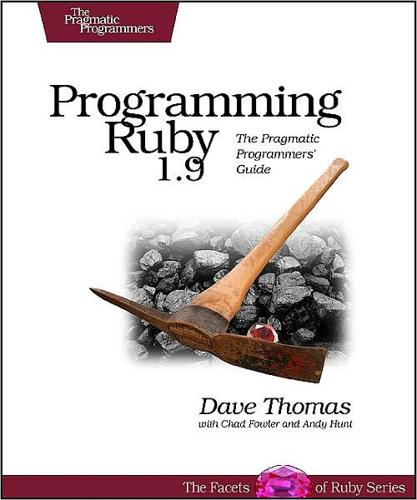
Programming Ruby 1.9: The Pragmatic Programmer's Guide
by
Dave Thomas
,
Chad Fowler
and
Andy Hunt
Published 15 Dec 2000
Download samples/tutthreads_4.rb require 'net/http' pages = %w( www.rubycentral.com threads = [] slashdot.org www.google.com ) for page_to_fetch in pages threads << Thread.new(page_to_fetch) do |url| Report erratum M ULTITHREADING 187 h = Net::HTTP.new(url, 80) print "Fetching: #{url}\n" resp = h.get('/') print "Got #{url}: #{resp.message}\n" end end threads.each {|thr| thr.join } produces: Fetching: www.rubycentral.com Fetching: slashdot.org Fetching: www.google.com Got www.google.com: OK Got www.rubycentral.com: OK Got slashdot.org: OK Let’s look at this code in more detail, because a few subtle things are happening.
…
As anyone with a kid brother can tell you, sharing isn’t always a good thing. In this case, all three threads would share the variable page_to_fetch. The first thread gets started, and page_to_fetch is set to "www.rubycentral.com". In the meantime, the loop creating the threads is still running. The second time around, page_to_fetch gets set to "slashdot.org". If the first thread has not yet finished using the page_to_fetch variable, it will suddenly start using this new value. These kinds of bugs are difficult to track down. However, local variables created within a thread’s block are truly local to that thread—each thread will have its own copy of these variables.
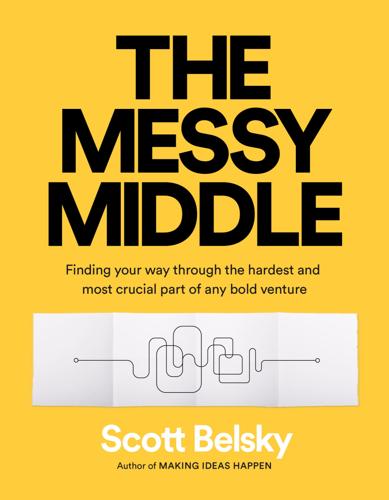
The Messy Middle: Finding Your Way Through the Hardest and Most Crucial Part of Any Bold Venture
by
Scott Belsky
Published 1 Oct 2018
One of my favorite examples is the early reviews for the iPod when it was first released in 2001. One letter to the editor of Macworld deemed it “another one of Apple’s failures just like the Newton . . . Apple could have done more-innovative things with an MP3 player than just make it look cool and give it some fast features.” More succinctly, one Slashdot iPod review read: “No wireless. Less space than a Nomad. Lame.” People love taking down something that is new and unfamiliar. Society is remarkably hypocritical. We shun things before we celebrate them. We chastise students who drop out of college to pursue a fascination that cannot be taught in school, and then we celebrate them when they become dropout-cum-wunderkinds like Jobs, Zuckerberg, or Gates.
…
M., 201 Pentagram, 274–75 performance, and productivity, 214 Periscope, 10, 69–70, 112, 204, 233, 252, 264–65 Twitter’s acquisition of, 69, 264–65 permission, asking for forgiveness vs., 199–202 perseverance, persistence, 62, 79, 85 perspective, 40–42, 66, 74, 326 quitting and, 62–64 Photoshop, 10, 144, 159, 162, 185, 206–7, 238–39, 270, 347 Pine Street, 125 Pinterest, 10, 64, 86–87, 94, 112, 158–59, 165, 174, 204, 233, 248, 319 Pixar, 141 placebo, 59–61 planning, 93, 280–81 polarizing people, 114–15 PolitiFact, 303 positive feedback, and hard truths, 28–31 Post-it notes, 325 pragmatists, 295, 296 Prefer, 28, 298, 299 preparedness, 16 presenting ideas, vs. promoting, 164–65 press, 265–66, 336 Pretty Young Professionals (PYP), 72–73 Principles (Dalio), 306, 307 problem solving, 209 big vs. small problems, 180–82, 322 explicitness and, 173–74 process, 153–57 Proctor & Gamble, 143 product(s), 8, 29 brand fit and, 256, 257 complexity in, 209–10, 217 explicitness in, 174–75, 271 founder fit and, 256 life cycle of, 209–10, 217 market fit and, 256 minimum viable (MVP), 86, 186, 195, 252 paradox of success of, 216 power users of, 217 products used to create, 143–45 simplicity in, 209, 210–11, 216–18, 271 product, optimizing, 17, 209–75 anchoring to your customers, 247–75 being first, 264–66 disproportionate impact and, 267–68 empathy and humility before passion, 248–50 engaging the right customers at the right time, 251–54 and measuring each feature by its own measure, 269–70 mystery and engagement in, 271–73 narrative in, 255–57 and playing to the middle, 274–75 and role of leaders in communities, 258–61 sales and, 262–63 simplifying and iterating, 213–46 and believing in the product, 223–25 creativity and familiarity in, 226–27 and design as invisible, 230–31 doing, showing, and explaining, 238–39 “first mile” and, 232–34 identifying what you’re willing to be bad at, 214–15 inbred innovations and, 245–46 incrementalism and assumptions in, 242–44 killing your darlings, 219–22 for laziness, vanity, and selfishness, 235–37 making one subtraction for every addition, 216–18 novelty and utility in, 240–41 scrutiny and flaws in, 228–29 productivity, 179, 180–82, 187, 322, 324, 325 measures of, 78–79 performance and, 214 promoting ideas, vs. presenting, 164–65 promotions, 130 progress, 24–25, 31, 40, 47, 64, 75, 83, 85, 160, 179, 181, 349 conflict avoidance and, 185–86 process and, 154 progress bars, 181 prototypes and mock-ups, 161–63 Psychological Bulletin, 272 psychological safety, 122 Psychological Science, 272–73 psychology, 316, 317 Quartz, 37–38, 108, 301 questions, 69–71, 183–84, 321 Quiller-Couch, Arthur, 220 Quinn, Megan, 303–4 quitting, perspective and, 62–64 Quora, 138, 167 Rad, Sean, 259 Radcliffe, Jack, 197 Rams, Dieter, 230 reactionary workflow, 327, 328 Ready, The, 179 reality-distortion field, 41 Reboot, 327 Reddit, 261, 300, 302 rejection, 58 relatability, 57 relationships: commitments and, 283–84 and how others perceive you, 316–17 negotiation and, 286–87 REMIX, 165 resets, 63–64, 72–75 resistance, fighting, 35–36 resourcefulness, and resources, 100–102 reward system, short-circuiting, 24–27 Rhode Island School of Design, 186, 354 rhythm of making, 16 Ries, Eric, 194 risk, 122, 316, 337 ritual, 328 rock gardens, 67–68 routines, 323 ruckus, making, 337–38 Saatchi Online, 89 Sabbath Manifesto, 327–28 safety, psychological, 122 Sakurada, Isuzu, 361–62 salaries, 141–42 sales, salespeople, 262–63 Salesforce, 159, 204 Sandberg, Sheryl, 39 Santa Fe, USS, 167 satisficers, 229, 284–85 scalability, 242 Schouwenburg, Kegan, 50–51 Schwartz, Barry, 284–85 science vs. art of business, 310–13 Seinfeld, Jerry, 250 self, optimizing, 8, 17, 277–338 crafting business instincts, 293–313 auditing measures instead of blindly optimizing, 297–99 data vs. intuition in, 300–304 mining contradictory advice and developing intuition, 294–96 naivety and openness in, 308–9 science vs. art of business, 310–13 stress-testing opinions with truthfulness, 305–7 planning and making decisions, 279–92 focus and choice, 282–85 making a plan vs. sticking to it, 280–81 negotiation in, 286–87 sunk costs and, 291–92 timing and, 288–90 sharpening your edge, 315–28 building a network and increasing signal, 320–21 commitments and, 318–19 disconnecting, 326–28 and how you appear to others, 316–17 leaving margins for the unexpected, 324–25 values and time use, 322–23 staying permeable and relatable, 329–38 attention and, 335–36 credit-seeking and, 330–32 and making a ruckus, 337–38 removing yourself to allow for others’ ideas, 333–34 self-awareness, 54–56, 305–7 selfishness, laziness, and vanity, 235–37 setbacks, 41 70/20/10 model for leadership development, 125 Shapeways, 50 Shiva, 374 shortcuts, 85 signal and noise, 320–21 Silberman, Ben, 86–87, 94, 112, 165, 319 Silicon Valley, 86 Simon, Herbert, 229, 284 SimpleGeo, 267 Sinclair, Jake, 334 skills, and choosing commitments, 283–84 Skybox, 101 sky decks, 117 Slack, 139, 210, 241 Slashdot, 295 Smarter Faster Better (Duhigg), 180 Smith, Brad, 373 Snapchat, 70, 189, 210, 227, 249 Snowden, Eric, 48, 162 Social Capital, 107 social media, 70, 139, 195, 210, 235–36, 243 solar eclipse, 300–302 SOLS, 50–51 Song Exploder, 333 Sonnad, Nikhil, 301–2 Sonos, 275 Southwest Airlines, 214–15 Soyer, Emre, 32–33 SpaceX, 168 Spark, 303 speed, 194–98 Spiegel, Evan, 249 Spot, 256, 257 Square, 303–4 Squarespace, 312 Stafford, Tom, 291 stand-ins, 297–98 start, 1, 6–8, 13, 209, 331 Statue of Liberty, 200 Stein, Dave, 280 Steinberg, Jon, 44–45, 313 Stitch Fix, 79 story, see narrative and storytelling Stratechery, 135 strategy, patience and, 80–85 strengths, 29, 54, 95, 214 stretch assignments, 130 structure, rules for, 150–52 StumbleUpon, 112, 256 Stumbling on Happiness (Gilbert), 196 suffering, 35–36, 131 Summers, Larry, 108 sunk costs, 64, 71, 185, 291–92 Super Bowl, 273 superiority, sense of, 331–32 suspension of disbelief, 60–61 Suster, Mark, 204–5 Swarthmore College, 229 sweetgreen, 10, 151, 217, 221, 233, 245–46, 310 Systemized Intelligence Lab, 306 Systems Thinking, 283 Systrom, Kevin, 36 Taflinger, Richard, 38 talent, 119–25, 127, 187 Talk of the Nation, 196 TaskRabbit, 259 team, 39, 331, 332 energy and, 43–45 perspective and, 40–42 team, optimizing, 8, 17, 97–207, 211 building, hiring, and firing, 99–131 discussions and, 112–13 diversity in, 106–9 firing people to keep good people, 126–28 grafting and recruiting talent, 119–25 hiring people who have endured adversity, 110–11 immune system in, 116–18 initiative and experience in, 103–5 keeping people moving, 129–31 polarizing people and, 114–15 resourcefulness and resources in, 100–102 clearing the path to solutions, 177–207 big and small problems, 180–82 bureaucracy, 183–84 competitive energy, 187–91 conflict avoidance, 185–86 conviction vs. consensus, 203–5 creative block, 192–93 forgiveness vs. permission, 199–202 organization debt, 178–79 and resistance to change, 206–7 speed in, 194–98 culture, tools, and space, 133–48 attribution of credit, 146–48 free radicals and, 137–39 frugality and, 140–42 stories and, 134–36 tools, 143–45 structure and communication, 149–76 communication, 170–76 delegation, 166–69 merchandising, internal, 158–60 mock-ups for sharing vision, 161–63 presenting vs. promoting ideas, 164–65 process in, 153–57 rules in, 150–52 technology, 328, 371 TED, 62, 116, 305 teleportation, 70, 264 Temps, 201 10 Principles of Good Design (Rams), 230 Teran, Dan, 221 Tesla, 273 think blend, 33 Thomas, Frank, 222 Thompson, Ben, 135 Threadless, 267 time, use of, 210, 283, 299 leaving margins, 324–25 money and, 370–72 values and, 322–23 time-outs, 74 timing, 288–90, 332 decision making and, 289–90 investment and, 290 leader and, 288–89 Tinder, 259–60 Tiny, 294 Todd, Charlie, 113 Todoist, 229 tools, 143–45 Topick, 249 transparency, 259–60, 287 triggers, 55 Trump, Donald, 273, 302–3 truth(s), 71, 174, 193, 331, 338 creative block and, 192–93 hard, 28–31 stress-testing opinions with, 305–7 about time use, 323 Turn the Ship Around!

For Profit: A History of Corporations
by
William Magnuson
Published 8 Nov 2022
For his senior year project, he and a friend created a program called Synapse that kept track of the songs users played on their computers and then created playlists based on their preferences. Released in September 2002, the program made something of a splash in the online music world, even earning a mention from Slashdot, an early online tech publication with a cultlike following in the industry. After the Slashdot article came out, Zuckerberg received calls from some of the major corporations operating in the music space, from WinAmp to Microsoft. One of them purportedly offered $2 million for the program. But Zuckerberg turned them all down. “We wanted to go to college, so we said no,” Zuckerberg told the Harvard student newspaper, the Harvard Crimson.

Little Brother
by
Cory Doctorow
Published 29 Apr 2008
FreeCulture is an international student movement that actively recruits kids to found their own local chapters at their high schools and universities. It's a great way to get involved and make a difference. A lot of websites chronicle the fight for cyberliberties, but few go at it with the verve of Slashdot, "News for Nerds, Stuff That Matters" (slashdot.org). And of course, you have to visit Wikipedia, the collaborative, net-authored encyclopedia that anyone can edit, with more than 1,000,000 entries in English alone. Wikipedia covers hacking and counterculture in astonishing depth and with amazing, up-to-the-nanosecond currency.

Machine, Platform, Crowd: Harnessing Our Digital Future
by
Andrew McAfee
and
Erik Brynjolfsson
Published 26 Jun 2017
Wikipedia, “Wikipedia:Five Pillars,” last modified February 6, 2017, at 10:52, https://en.wikipedia.org/wiki/Wikipedia:Five_pillars. †† Larry Sanger left the Wikipedia community in the early years of the twenty-first century over differences about its governance. He came to feel that it was harmfully antiauthoritarian. Larry Sanger [timothy, pseud.], “The Early History of Nupedia and Wikipedia, Part II,” Slashdot, April 19, 2005, https://slashdot.org/story/05/04/19/1746205/the-early-history-of-nupedia-and-wikipedia-part-ii. ‡‡ Wikipedians are not paid for their contributions and are mostly anonymous, so fame is of limited power as an incentive. As shown in a clever field experiment by Jana Gallus, they do seem to respond well to recognition, even if it’s just from fellow Wikipedians.
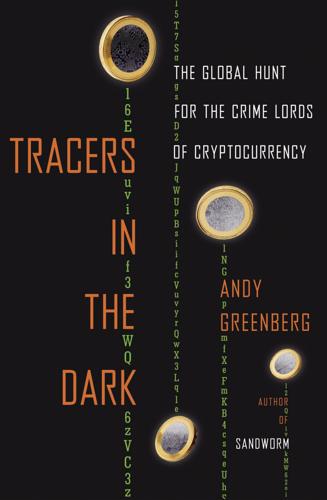
Tracers in the Dark: The Global Hunt for the Crime Lords of Cryptocurrency
by
Andy Greenberg
Published 15 Nov 2022
So after a couple of years, he made a commitment to himself: He’d no longer settle for whatever investigations fell to him. He’d make cases of his own. * * * · · · Since he’d gotten that first Packard Bell PC in 1997, Gambaryan had remained a digital hobbyist, building and repairing computers and playing with new technologies whenever he read about them on forums like Reddit or Slashdot. In 2010, while still in the process of applying to join IRS-CI, he’d come across a post on one of those sites describing something called Bitcoin. Bitcoin was a new digital currency, and it used a clever system to track who owned which coins: The Bitcoin network stored thousands of copies of a distributed accounting ledger on computers around the world—a ledger known as the blockchain.
…
But he wasn’t particularly interested in solving the mysteries of the universe’s subatomic composition. His obsession lay in the digital challenge those mysteries provided, the need they created to push computing machinery to its limits. It was in 2010 that Gronager read a post about Bitcoin on the forum Slashdot that would alter the course of his life yet again. Soon he was delving into Satoshi Nakamoto’s white paper and code, marveling at how it solved the problem of creating truly scarce, uncopiable digital coins with thousands of mining computers spread across the globe, each one rewarded for its part in collectively hammering out the unforgeable blockchain.

Your Face Belongs to Us: A Secretive Startup's Quest to End Privacy as We Know It
by
Kashmir Hill
Published 19 Sep 2023
Feeling that his creation was a big deal and deserved an audience beyond other computer scientists, Schneiderman decided to put it onto the internet, in the form of an online tool. People could visit his website and upload a photo, and the software would put a box around any faces it could detect. This may sound unexceptional now, but it was enough of a big deal back then that the website climbed to the top of an influential social news website “for nerds” called Slashdot, where readers upvoted it and commented on how cool it was. His face-finding website got so much traffic that it crashed the web server twice, knocking the whole robotics department offline. A couple of companies reached out, including Kodak, which was hoping to use the software to eliminate red eyes in photos.
…
See also Soviet Union S Salem, Mohammed, 171–174 Sampras, Pete, 104 Saverin, Eduardo, 94 Scalia, Antonio, 306n206 Scalzo, David author’s contact with, xv frustrations of, 188–189 investment in Clearview from, 111–112, 113, 116–117, 118–120 ScanAmerica, 270–271n44 SceneTap, 122 Schemm, Martin, 304n192 Schmidt, Eric, 27, 102–103, 145 Schneiderman, Henry, 103–106, 108–109 Schneier, Bruce, 61, 65 Schwartz, Richard Abrams and, 205–206 attempts to contact, 160, 213 background of, 27–29 Besson and, 128, 129 early plans of, 31, 33–34 FindFace and, 220 investors and, 116 Johnson and, 95, 247–248 law enforcement and, 132–133 Linden and, 161 Lynch and, 88, 89–90, 91, 92, 93 Montana and, 114 NYPD and, 129, 130, 131 opposition and, 138 Orbán and, 56 sale to businesses and, 187 Scalzo and, 111, 113, 118, 188–189 Smartcheckr and, 52, 72, 79, 89, 94 Ton-That and, 29–30 Waxman and, 80 Science, Policy, and the Value-Free Ideal (Douglas), 279n74 scraping Abrams case and, 206, 208–209 Bedoya and, 144, 241 Borthwick and, 113 description of, 58 efforts to block, 58, 117–118, 165 Fawkes and, 242 Grossenbacher and, 194–195 LinkedIn and, 117–118, 165 Smartcheckr and, 92 Ton-That’s use of, 78–79, 81, 116, 133, 162 Venmo and, 78–79 Vermont lawsuit and, 205 Search King, 306n206 Secret Service, 247 security theater, 65 Seeking, 201 Sejnowski, Terry, 268n37 self-driving cars, 42 selfies, as password alternative, 31 Semmelweis, Ignaz, 250–251 SenseTime, 226, 240, 242 September 11 attacks, 28, 64, 235 Sequoia Capital, 113 sex workers, 197–199, 221–222 Sherman, Rob, 144 Shirley cards, 179 ShopperTrak, 242 ShotSpotter, 232–233, 234 Showing Up for Racial Justice, 57 Shteyngart, Gary, 34 Six Flags amusement park, 151–152 Slack, 10 Slashdot, 104 Smartcheckr contractors for, 81 DeploraBall and, 55, 56–57 development of, 73–79 founding of, 52–53 Hungary and, 55–56, 57–59 investment efforts and, 80, 89 lack of office for, 72 Lynch and, 90–93 MegaFace and, 242 name change for, 162 white nationalism and, 94 winding down of, 95, 249 smartphone economy, 6 smartphones data brokers and, 204 Franken and, 141 iPhone, ix, 6, 9, 109 tracking and, 226 ubiquity of, 36 unlocking and, 109, 142 Smith, Brad, 239 Snap Map, 232 Snapchats, 232 Snowden, Edward, 149 social media, scraping and, 58, 92.

The Optimist: Sam Altman, OpenAI, and the Race to Invent the Future
by
Keach Hagey
Published 19 May 2025
Graham was a celebrity among the geek set thanks to the essays he posted on his personal website on topics ranging from the programming language Lisp to the nature of wealth. In the early days of Google, he was the first “Paul” it surfaced, ahead of the Beatle and the apostle; to this day, his essays are near the top if one searches the word “essays.” “Pretty much everything he does is featured on Slashdot, which is sort of like The New York Times of the computer world—everybody reads it,” Aaron Swartz told The Stanford Daily that spring.6 Like Altman, Swartz was a nineteen-year-old founder from Stanford bound for the program, except Swartz was already tech-world famous for having helped create the popular RSS-feed format at age fourteen.
…
Kraemer, 26 Sikka, Vishal, 197, 236 Silicon Valley (TV show), 101, 258–59 Silicon Valley, 2–8, 72–73, 258 “add a zero” ethos of, 3–4, 272 Bay 101 cardroom, San Jose, 57 belief we are living in a computer simulation, 17 economy of favor-trading, 14 incestuousness of, 82 University of California, Berkeley, 94, 111, 122–23, 167, 178, 194, 234, 277, 305 value system of, 2–3 “working on the weekends,” 175 zeitgeist of, 4, 6, 137–38 see also Palo Alto, CA; Stanford University; tech bros; tech industry Simon, Mel, 209 Sims, The (video game), 97 Singer, Peter, 211–12 singularity, 140–42, 144–45, 168, 199–200, 305 Singularity Institute for Artificial Intelligence, 142 Singularity Is Near, The (Kurzweil), 144 Singularity Summits, 144, 146, 210 Singularity University, an “educational community,” 210 Sivo, Nick, 55–56, 60, 64, 85, 89, 91–92, 102–3, 113–14, 128 Skrenta, Rich, 244 “Sky,” an AI voice, 307–8 Skype, 5, 144, 168 Slack channels, 245–46, 287, 293–94 Slashdot (news site), 63 Slate Star Codex (blog), 165–66, 213 Slee, Mark, 96 Slowe, Chris, 76, 81 slum clearance, 26, 34 Smashwords writing platform, 220 Smith, Barbara Ann (Barbie), 52 Smith, Dylan, 96, 289 social contract visionary, 195 social networking, 16, 59, 103, 113, see also specific social network sites Socrates, 265 Sodol, Lee, 192, 216 SoftBank, 229 software development “agile” method of, 127 application programming interfaces (APIs), 125, 245–48, 250–51, 264–65, 269, 279 Brockman’s “code caves,” 175–76, 246–47 hackers/hacking, 3, 57, 63, 68–70, 160n, 162 Lisp programming language, 63, 69, 124, 151 object-oriented programming, 195 open-source technologies, 95, 186, 214, 247, 263 SDKs (software development kits), 110–14, 121 “waterfall” method of, 126 whiteboards, 189–90 Sonsini, Larry, 85 Sony Entertainment, 303 Sony Ericsson phones, 77 SourceCom, 86–87 South by Southwest (SXSW), 118–19 South Carolina, 297 South Korea, 274 Southern District of New York, 290 Southern Pacific Railroad Internal Networking Telephony, see Sprint Soylent meal replacement, 138 space, colonization of, 144, 147, 170–71 SpaceX, 147, 153, 167, 170–71, 187, 194 SPARK Neuro AI dementia detection startup, 275 Springer, Axel, 307 Sprint, 53, 58–59, 62, 78–80, 99–105 St.
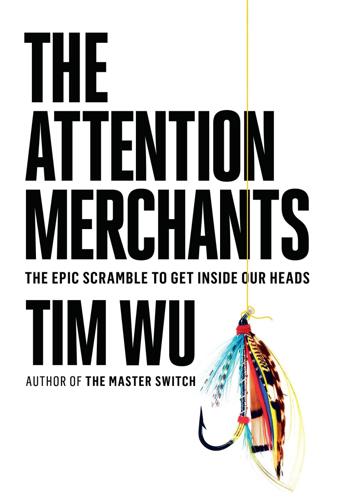
The Attention Merchants: The Epic Scramble to Get Inside Our Heads
by
Tim Wu
Published 14 May 2016
By their nature the new creators varied but were unified by a pioneering spirit and a bracingly amateur affect. Among them were: a site named the Drudge Report, launched in the 1990s, which gained much attention with its timely leaks related to a scandal surrounding President Bill Clinton’s affair with an intern; Slashdot.org, launched in 1997, to bring “news for nerds”; the Robot Wisdom, with links to news stories and aiming to establish a link between artificial intelligence and the work of James Joyce; Megnut.com and Kottke.org, the personal blogs of two Internet entrepreneurs who would eventually marry; “The Instapundit” Glenn Reynolds, a libertarian expert on the law of outer space, who gained an audience coupling his pithy one-liners with news of the day.
…
Consequently, audiences were fragmented to a degree that made cable television look like the days of The Ed Sullivan Show. The regular follower of, say, the blogger Andrew Sullivan would have to be interested in a pro-war gay conservative viewpoint that also advocated for Catholicism, marijuana, beards, beagles, and same-sex marriage. Readers of Boing Boing or Slashdot were people whose truest affiliation was to a neo-geek mentality that celebrated eccentricity and arcane obsessions. Such groups were nothing like the clear demographic categories of old, or even the relatively precise PRIZM clusters. In fact, bloggers sometimes claimed they were creating a-geographical communities, aggregations purely by common interest and passion.

Surveillance Valley: The Rise of the Military-Digital Complex
by
Yasha Levine
Published 6 Feb 2018
“We also need to think about a strategy for how to spin this move in terms of Tor’s overall direction. I would guess that we don’t want to loudly declare war on China, since this only harms our goals?” he wrote. “But we also don’t want to hide the existence of funding from [the BBG], since ‘they’re getting paid off by the feds and they didn’t tell anyone’ sounds like a bad Slashdot title for a security project. Is it sufficient just to always talk about Iran, or is that not subtle enough?”30 In college Dingledine had dreamed of using technology to create a better world. Now he was suddenly talking about whether or not they should declare war on China and Iran and worrying about being labeled a federal agent?
…
An example of Roger Dingledine’s reports: “One of the best ways we’ve found for getting new relays is to go to conferences and talk to people in person. There are many thousands of people out there with spare fast network connections and a willingness to help save the world. Our experience is that visiting them in person produces much better results, long-term, than Slashdot articles.… The first is in Japan. The second is our first major high bandwidth node in New Zealand.” 76. It would be led by Dingledine and Appelbaum. “All around the world there are people teaching other people how to safely use Tor and related applications. This training will be ramping up with projects like iFree, NGO-in-a-box, and the Global Voices seminars.

Like, Comment, Subscribe: Inside YouTube's Chaotic Rise to World Domination
by
Mark Bergen
Published 5 Sep 2022
A tall, pragmatic South African with a business degree and a geek’s fetish for tech novelties, Botha had recently taken a new digital camera on his honeymoon in the Italian countryside. He posted some footage to the site he had heard about through the PayPal network. Buzz outside the network was also building. In August, Slashdot, an influential tech news site Google’s founders read, gave a shout-out to YouTube, bringing in waves of fresh traffic. Botha reconnected with his former PayPal colleagues and drafted a memo that month persuading other partners at Sequoia to invest. By late August, YouTube had eight thousand visitors, who generated more than fifteen thousand videos.
…
K., 279 Rubin, Andy, 177, 348–49, 355 Russia, 326–27, 340, 341, 345, 397, 399 Russia Today (RT) television network, 190, 340–41 Ryan ToysReview, 237, 238, 306 S safety measures added by YouTube, 366–67 sam bacile, 142 Samberg, Andy, 33–34 San Bruno offices of YouTube move to, 52, 53 shooting at, 330–31, 336–37, 338 Sandberg, Sheryl, 195–96 Sandlin, Destin, 246 Sandy Hook school shooting (2012), 327 San Mateo offices of YouTube, 28, 30 Sanyo, 111 Sargon of Akkad (Benjamin), 223, 264, 294–95, 299, 378–79 Sarkeesian, Anita, 293 satisfaction ratings, 296–97 Saturday Night Live, 33–34 Saudi Arabia, 320 scandals, 50 scapegoating of social networks, 398–99 Scare PewDiePie, 253, 254, 274, 279 Schaffer, Micah “age-gating” policy of, 86 background of, 37 on conspiracy theories on YouTube, 366 and culture of YouTube, 30 defense of content, 87 and Finland’s mass shooting, 64 and Ghonim’s imprisonment, 142 and Google’s acquisition of YouTube, 54, 55 guidelines for content moderation, 31–32, 85–86 and move to San Bruno offices, 52 and Viacom lawsuit, 97, 98 and Viacom negotiations, 60–61 and Viacom’s content, 62 Schindler, Philipp, 286–87 Schmidt, Eric and advertisers’ boycott, 287 expectations for profitability, 93, 96 and Google’s acquisition of YouTube, 53 and Google Video, 47 on growth as priority of YouTube, 68 and losses associated with YouTube, 97 recruited to Google, 46 romantic relationships of, 59 transition from CEO to chairman, 146 schools, YouTube in, 170, 282–83 Schrock, Jasson, 58, 63 Scott, Kim, 198, 401 search system of YouTube, 5, 155, 360, 361 Section 230 of Communications Decency Act (1996), 35, 342 self-driving cars, 147 sell-through rate, 108, 109–10 Sequoia Capital, 29–30, 50, 390 server space required by YouTube, 25 Sesame Street, 167 sexism/sexual harassment, 224, 301–3, 348–50 sexual content, 86, 283, 306, 309 sharing videos, button for, 23 Sherratt, David, 221, 222, 223, 225, 264, 343 Shey, Tim, 211 shitposters, 275 Shkreli, Martin, 269–70 shock jocks, conservative, 224–25, 347 Shorts format, 393 Sierra Mist, 68 Sievers, David, 120–21, 162, 243, 252, 276, 307 Simpson, O. J., 61 Singh, Lilly, 276 Sjøberg, Jakob Høgh, 317–18, 320 skeptics, YouTube, 221–23, 226 skin-detection algorithms, 100 Slashdot, 29 Slate, 47 SmarterEveryDay, 246 Smith, Joseph “Big Joe,” 56 Smith, Shane, 132–33 Smith, Will, 351–52 Smoothie King, 67 Smosh, 67, 68–69, 73, 94, 110, 160, 248 Snapchat, 250, 256–57, 265, 390 Snoop Dogg, 162 Snowden, Edward, 215, 230 Social Blade, 352–53 social-justice-warriors rhetoric, 224–25 social networks/media business models of, 6 creators’ posts to, 250–51 explosive growth of, 138 power of, 138–39 and process of building platform, 179–80 YouTube as, 345 See also specific platforms, including Facebook Soderberg-Rivkin, Daisy, 320 Some Good News (Krasinski), 377 Sony Pictures, 76 Soros, George, 264 Sorrell, Martin, 284, 285–86 sound synced to videos, 21 Southern, Lauren, 343–44 Southern Poverty Law Center (SPLC), 226, 261, 381 South Park (television show), 275 speech, gatekeeping/moderation of, 83–85 speed of videos loading, 151–52 Spencer, Richard, 299, 379 Spider-Man, people dressed as, 305–7, 309, 312 Spinosaurus Kin, 223.
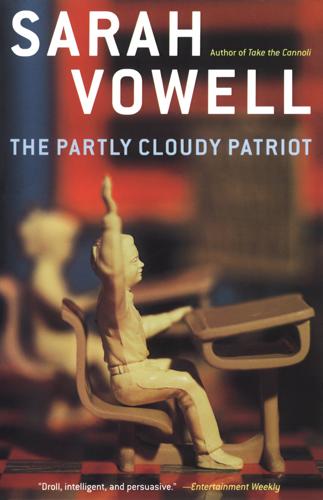
The Partly Cloudy Patriot
by
Sarah Vowell
Published 26 Aug 2002
The discussion of current events would follow some historical tangent, such as whether or not the early Clinton administration should have honored the promised middle-class tax cut instead of going for deficit reduction in 1993, and we would bicker about the findings of former Labor Secretary Robert Reich and blah, blah, Alan Greenspan, and the next morning I would wake up to find that in the middle of the night my friend Stephen had called me a “deficit hawk,” which, in his vocabulary is a synonym for “Republican.” The best part about being a nerd within a community of nerds is the insularity—it’s cozy, familial, come as you are. In a discussion board on the Web site Slashdot.org about Rushmore, a film with a nerdy teen protagonist, one anonymous participant pinpointed the value of taking part in detail-oriented zealotry: Geeks tend to be focused on very narrow fields of endeavor. The modern geek has been generally dismissed by society because their passions are viewed as trivial by those people who “see the big picture.”
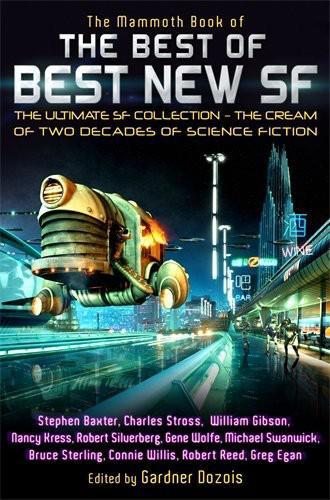
The Best of Best New SF
by
Gardner R. Dozois
Published 1 Jan 2005
Manfred takes it and heads for the back of the split-level bar, up the steps to a table where some guy with greasy dreadlocks is talking to a suit from Paris. The hanger-on at the bar notices him for the first time, staring with suddenly wide eyes: nearly spills his Coke in a mad rush for the door. Oh shit, thinks Macx, better buy some more server PIPS. He can recognize the signs: he’s about to be slashdotted. He gestures at the table: “this one taken?” “Be my guest,” says the guy with the dreads. Manfred slides the chair open then realizes that the other guy – immaculate double-breasted suit, sober tie, crew-cut – is a girl. Mr. Dreadlock nods. “You’re Macx? I figured it was about time we met.” “Sure.”
…
Just then a bandwidth load as heavy as a pregnant elephant sits down on Manfred’s head and sends clumps of humongous pixellation flickering across his sensorium: around the world five million or so geeks are bouncing on his home site, a digital flash crowd alerted by a posting from the other side of the bar. Manfred winces. “I really came here to talk about the economic exploitation of space travel, but I’ve just been slash-dotted. Mind if I just sit and drink until it wears off?” “Sure, man.” Bob waves at the bar. “More of the same all round!” At the next table a person with make-up and long hair who’s wearing a dress – Manfred doesn’t want to speculate about the gender of these crazy mixed-up Euros – is reminiscing about wiring the fleshpots of Tehran for cybersex.
…
Another fourteen months and the larger part of the cumulative conscious processing power of the human species will be arriving in silicon. And the first meat the new AI’s get to know will be the uploaded lobsters. Manfred stumbles back to his hotel, bone-weary and jet-lagged; his glasses are still jerking, slashdotted to hell and back by geeks piggybacking on his call to dismantle the moon. They stutter quiet suggestions at his peripheral vision; fractal cloud-witches ghost across the face of the moon as the last huge Airbuses of the night rumble past overhead. Manfred’s skin crawls, grime embedded in his clothing from three days of continuous wear.

Without Their Permission: How the 21st Century Will Be Made, Not Managed
by
Alexis Ohanian
Published 30 Sep 2013
Long before most people realized the power of online software, he knew the Internet offered tremendous potential for an idea to spread as never before. When a customer only needs a browser and an Internet connection to access your product, unprecedented growth is possible. He asked us about frustrations we had using the Internet, which had just recently seen the launch of a college-only site called TheFacebook.com. Steve was an avid reader of Slashdot, a news website with editorial oversight and a robust community of commenters as well as a moderation system. I had too many tabs open every day—they showed me a range of news websites, but I had no way to filter signal from noise. At the time, a website called del.icio.us (pronounced “delicious”; ignore the dots) let people bookmark websites online, so if you hopped between computers, your reference material followed you.
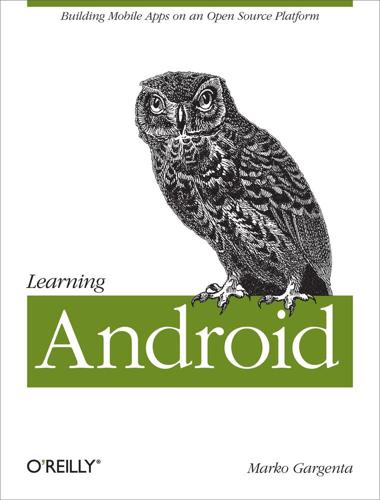
Learning Android
by
Marko Gargenta
Published 11 Mar 2011
-- --> <LinearLayout xmlns:android="http://schemas.android.com/apk/res/android" android:layout_height="wrap_content" android:orientation="vertical" android:layout_width="fill_parent"> <!-- --> <LinearLayout android:layout_height="wrap_content" android:layout_width="fill_parent"> <!-- --> <TextView android:layout_height="wrap_content" android:layout_width="fill_parent" android:layout_weight="1" android:id="@+id/textUser" android:text="Slashdot" android:textStyle="bold" /> <!-- --> <TextView android:layout_height="wrap_content" android:layout_width="fill_parent" android:layout_weight="1" android:gravity="right" android:id="@+id/textCreatedAt" android:text="10 minutes ago" /> </LinearLayout> <!-- --> <TextView android:layout_height="wrap_content" android:layout_width="fill_parent" android:id="@+id/textText" android:text="Firefox comes to Android" /> </LinearLayout> The main layout for the entire row.
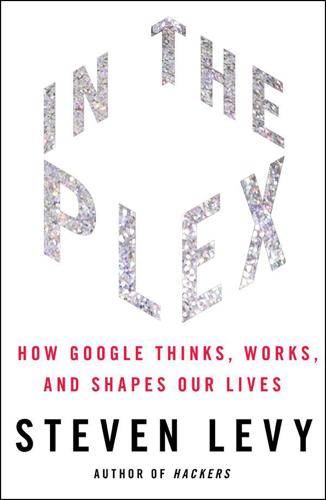
In the Plex: How Google Thinks, Works, and Shapes Our Lives
by
Steven Levy
Published 12 Apr 2011
He had grown up just outside Rochester, New York, a typical hacker kid driven by silicon and curiosity, and by the time he entered Case Western Reserve University in Cleveland, he was full of ideas and projects, one of them being a web-based email program. After graduation, he took a job with Intel. But the chipmaker was big and bureaucratic. “I wasn’t really loving Intel,” he later said, meaning he hated it. He started looking around for an interesting start-up. He’d read about Google on Slashdot, an online discussion site that was like Entertainment Tonight for geeks, and started using its search engine. He was impressed by Google’s imaginative stab at an interesting technical problem. He sent his résumé to jobs@google.com. The email bounced—the server was down—but he persisted and eventually was granted a phone screener, followed by a face-to-face interview.
…
J., 140 Playboy, 153–54, 155 pornography, blocking, 54, 97, 108, 173, 174 Postini, 241 Pregibon, Daryl, 118–19 Premium Sunset, 109, 112–13, 115 privacy: and Book Settlement, 363 and browsers, 204–12, 336–37 and email, 170–78, 211–12, 378 and Google’s policies, 10, 11, 145, 173–75, 333–35, 337–40 and Google Street View, 340–43 and government fishing expeditions, 173 and interest-based ads, 263, 334–36 and security breach, 268 and social networking, 378–79, 383 and surveillance, 343 Privacy International, 176 products: beta versions of, 171 “dogfooding,” 216 Google neglect of, 372, 373–74, 376, 381 in GPS meetings, 6, 135, 171 machine-driven, 207 marketing themselves, 77, 372 speed required in, 186 Project Database (PDB), 164 property law, 6, 360 Python, 18, 37 Qiheng, Hu, 277 Queiroz, Mario, 230 Rainert, Alex, 373, 374 Rajaram, Gokul, 106 Rakowski, Brian, 161 Randall, Stephen, 153 RankDex, 27 Rasmussen, Lars, 379 Red Hat, 78 Reese, Jim, 181–84, 187, 195, 196, 198 Reeves, Scott, 153 Rekhi, Manu, 373 Reyes, George, 70, 148 Richards, Michael, 251 robotics, 246, 351, 385 Romanos, Jack, 356 Rosenberg, Jonathan, 159–60, 281 Rosenstein, Justin, 369 Rosing, Wayne, 44, 55, 82, 155, 158–59, 186, 194, 271 Rubin, Andy, 135, 213–18, 220, 221–22, 226, 227–30, 232 Rubin, Robert, 148 Rubinson, Barry, 20–21 Rubinstein, Jon, 221 Sacca, Chris, 188–94 Salah, George, 84, 128, 129, 132–33, 166 Salinger Group, The, 190–91 Salton, Gerard, 20, 24, 40 Samsung, 214, 217 Samuelson, Pamela, 362, 365 Sandberg, Sheryl, 175, 257 and advertising, 90, 97, 98, 99, 107 and customer support, 231 and Facebook, 259, 370 Sanlu Group, 297–98 Santana, Carlos, 238 Schillace, Sam, 201–3 Schmidt, Eric, 107, 193 and advertising, 93, 95–96, 99, 104, 108, 110, 112, 114, 115, 117, 118, 337 and antitrust issues, 345 and Apple, 218, 220, 236–37 and applications, 207, 240, 242 and Book Search, 350, 351, 364 and China, 267, 277, 279, 283, 288–89, 305, 310–11, 313, 386 and cloud computing, 201 and financial issues, 69–71, 252, 260, 376, 383 and Google culture, 129, 135, 136, 364 and Google motto, 145 and growth, 165, 271 and IPO, 147–48, 152, 154, 155–57 on lawsuits, 328–29 and management, 4, 80–83, 110, 158–60, 165, 166, 242, 254, 255, 273, 386, 387 and Obama, 316–17, 319, 321, 346 and privacy, 175, 178, 383 and public image, 328 and smart phones, 216, 217, 224, 236 and social networking, 372 and taxes, 90 and Yahoo, 344, 345 and YouTube, 248–49, 260, 265 Schrage, Elliot, 285–87 Schroeder, Pat, 361 search: decoding the intent of, 59 failed, 60 freshness in, 42 Google as synonymous with, 40, 41, 42, 381 mobile, 217 organic results of, 85 in people’s brains, 67–68 real-time, 376 sanctity of, 275 statelessness of, 116, 332 verticals, 58 see also web searches search engine optimization (SEO), 55–56 search engines, 19 bigram breakage in, 51 business model for, 34 file systems for, 43–44 and hypertext link, 27, 37 information retrieval via, 27 and licensing fees, 77, 84, 95, 261 name detection in, 50–52 and relevance, 48–49, 52 signals to, 22 ultimate, 35 upgrades of, 49, 61–62 Search Engine Watch, 102 SearchKing, 56 SEC regulations, 149, 150–51, 152, 154, 156 Semel, Terry, 98 Sengupta, Caesar, 210 Seti, 65–67 Shah, Sonal, 321 Shapiro, Carl, 117 Shazeer, Noam, 100–102 Sheff, David, 153 Sherman Antitrust Act, 345 Shriram, Ram, 34, 72, 74, 79 Siao, Qiang, 277 Sidekick, 213, 226 signals, 21–22, 49, 59, 376 Silicon Graphics (SGI), 131–32 Silverstein, Craig, 13, 34, 35, 36, 43, 78, 125, 129, 139 Sina, 278, 288, 302 Singh, Sanjeev, 169–70 Singhal, Amit, 24, 40–41, 48–52, 54, 55, 58 Siroker, Dan, 319–21 skunkworks, 380–81 Skype, 233, 234–36, 322, 325 Slashdot, 167 Slim, Carlos, 166 SMART (Salton’s Magical Retriever of Text), 20 smart phones, 214–16, 217–22 accelerometers on, 226–28 carrier contracts for, 230, 231, 236 customer support for, 230–31, 232 direct to consumer, 230, 232 Nexus One, 230, 231–32 Smith, Adam, 360 Smith, Bradford, 333 Smith, Christopher, 284–86 Smith, Megan, 141, 158, 184, 258, 318, 350, 355–56 social graph, 374 social networking, 369–83 Sogou, 300 Sohu, 278, 300 Sony, 251, 264 Sooner (mobile operating system), 217, 220 Southworth, Lucinda, 254 spam, 53–57, 92, 241 Spector, Alfred, 65, 66–67 speech recognition, 65, 67 spell checking, 48 Spencer, Graham, 20, 28, 201, 375 spiders, 18, 19 Stanford University: and BackRub, 29–30 and Book Search, 357 Brin in, 13–14, 16, 17, 28, 29, 34 computer science program at, 14, 23, 27, 32 Digital Library Project, 16, 17 and Google, 29, 31, 32–33, 34 and MIDAS, 16 Page in, 12–13, 14, 16–17, 28, 29, 34 and Silicon Valley, 27–28 Stanley (robot), 246, 385 Stanton, Katie, 318, 321, 322, 323–25, 327 Stanton, Louis L., 251 State Department, U.S., 324–25 Steremberg, Alan, 18, 29 Stewart, Jon, 384 Stewart, Margaret, 207 Stricker, Gabriel, 186 Sullivan, Danny, 102 Sullivan, Stacy, 134, 140, 141, 143–44, 158–59 Summers, Larry, 90 Sun Microsystems, 28, 70 Swetland, Brian, 226, 228 Taco Town, 377 Tan, Chade-Meng, 135–36 Tang, Diane, 118 Taylor, Bret, 259, 370 Teetzel, Erik, 184, 197 Tele Atlas, 341 Tesla, Nikola, 13, 32, 106 Thompson, Ken, 241 3M, 124 Thrun, Sebastian, 246, 385–86 T-Mobile, 226, 227, 230 Tseng, Erick, 217, 227 Twentieth Century Fox, 249 Twitter, 309, 322, 327, 374–77, 387 Uline, 112 Universal Music Group, 261 Universal Search, 58–60, 294, 357 University of Michigan, 352–54, 357 UNIX, 54, 80 Upson, Linus, 210, 211–12 Upstartle, 201 Urchin Software, 114 users: in A/B tests, 61 data amassed about, 45–48, 59, 84, 144, 173–74, 180, 185, 334–37 feedback from, 65 focus on, 5, 77, 92 increasing numbers of, 72 predictive clues from, 66 and security breach, 268, 269 U.S.

In the Land of Invented Languages: Adventures in Linguistic Creativity, Madness, and Genius
by
Arika Okrent
Published 1 Jan 2009
Dungeons & Dragons players, ham radio operators, robot engineers, computer programmers, comic book collectors—they all look down on Klingon speakers. Even the most ardent Star Trek fanatics, the Trekkies, who dress up in costume every day, who can recite scripts of entire episodes, who collect Star Trek paraphernalia with mad devotion, consider Klingon speakers beneath them. When a discussion of Klingon appeared on Slashdot.org—the Web site billed as “News for Nerds”—the topic inspired comments like “I'm sorry but it's people like this that give science fiction a bad name.” Another said that Klingon speakers “provide excellent reasons for forced sterilization. Then again being able to speak Klingon pretty much does this without surgery.”

Whiplash: How to Survive Our Faster Future
by
Joi Ito
and
Jeff Howe
Published 6 Dec 2016
Though the price seemed reasonable at the time, amounting to about $25, the same 10,000 bitcoins would have been worth more than $2 million in early 2015.14 That pizza purchase came the same year as the rise of the most famous, or infamous, Bitcoin exchange—Mt. Gox. Originally established in 2007 as “Magic: The Gathering Online eXchange,” a trading site for Magic: The Gathering Online cards, Mt. Gox gathered digital dust for several years before its founder, Jed McCaleb, read a Slashdot post about Bitcoin and rewrote the site as a Bitcoin exchange. McCaleb moved on in 2011, but he transferred Mt. Gox to Mark Karpelès, a French developer living in Japan.15 Over the next two years, as Bitcoin became more visible and more popular, Mt. Gox grew along with it, eventually handling more than 70 percent of the global trade in bitcoins.16 While Mt.

Shipping Greatness
by
Chris Vander Mey
Published 23 Aug 2012
In situations where you can’t roll back, your best bet is to make sure that you have the team capacity to keep moving forward very quickly for a couple of days, because it may take you that long to find and fix your problems—and as you’re fixing them, customers are having a bad day. On the other hand, if rollback is possible, you can turn off the changes, fix things at a leisurely pace, and try again. Handle Any Production Crises Sometimes the world explodes. Maybe you got slashdotted. Or maybe there was a security hole, privacy violation, or pricing mishap. Or maybe an intern redirected the production website to his or her desktop instead of the datacenter (true story!). In cases like these, there’s a good script you can follow. And like all good reactive measures, it’s inspired by the Boy Scouts: you start by being prepared.

Makers
by
Chris Anderson
Published 1 Oct 2012
We could kill two birds with one stone: invent something cool with Lego that had never been done before and get the robot to fly the plane! It was sure to be a better pilot than me. The moment I got home, I prototyped a Lego autopilot on the dining room table, and my nine-year-old helped write the software. We took some pictures, posted them, and it was on the front page of Slashdot by that evening. We put it in a plane—the world’s first Lego UAV, I think—and took it out a few weekends later. It almost kinda worked—it was definitely staying aloft and steering on its own, albeit not exactly where we had intended. At that point I went down the rabbit hole and resolved to improve it until it worked as I’d dreamed, a quest that I’m still on years later.
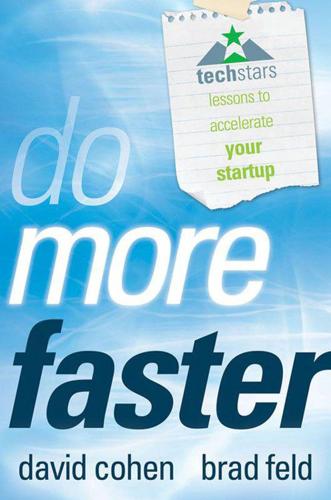
Do More Faster: TechStars Lessons to Accelerate Your Startup
by
Brad Feld
and
David Cohen
Published 18 Oct 2010
Usage Is Like Oxygen for Ideas Matt Mullenweg Matt is the founder of Automattic which makes WordPress.com, Akismet, bbPress, BuddyPress, and now Intense Debate, a TechStars company that Automattic acquired in 2008. I like Apple because they are not afraid of getting a basic 1.0 out into the world and iterating on it. A case in point: “No wireless. Less space than a nomad. Lame.”—cmdrtaco, Slashdot.org, 2001, when reviewing the first iPod. I remember my first iPhone. I stood in line for hours to buy it, and like a great meal, you have to wait for in a long line outside a hot night club, the wait made the first time I swiped to unlock the phone that much sweeter. I felt like I was on Star Trek and this was my magical tricorder—a tricorder that constantly dropped calls on AT&T's network, had a headphone adapter that didn't fit any of the hundreds of dollars worth of headphones I owned, ran no applications, had no copy and paste, and was slow as molasses.

The Innovators: How a Group of Inventors, Hackers, Geniuses and Geeks Created the Digital Revolution
by
Walter Isaacson
Published 6 Oct 2014
Author’s interview with Jimmy Wales; Eric Raymond, “The Cathedral and the Bazaar,” first presented in 1997, reprinted in The Cathedral and the Bazaar (O’Reilly Media, 1999). 90. Richard Stallman, “The Free Universal Encyclopedia and Learning Resource” (1999), http://www.gnu.org/encyclopedia/free-encyclopedia.html. 91. Larry Sanger, “The Early History of Nupedia and Wikipedia,” Slashdot, http://beta.slashdot.org/story/56499; and O’Reilly Commons, http://commons.oreilly.com/wiki/index.php/Open_Sources_2.0/Beyond_Open_Source:_Collaboration_and_Community/The_Early_History_of_Nupedia_and_Wikipedia:_A_Memoir. 92. Larry Sanger, “Become an Editor or Peer Reviewer!” Nupedia, http://archive.is/IWDNq. 93.

Four Battlegrounds
by
Paul Scharre
Published 18 Jan 2023
AI researchers woke up one Thursday morning to a spate of news headlines about a technical breakthrough for which they hadn’t yet seen the academic paper (it posted the same day). For example, Wired touted “The AI Text Generator That’s Too Dangerous to Make Public.” The “too dangerous” theme was echoed in other outlets as well, including TechCrunch, The Guardian, Gizmodo, Slashdot, The Verge, Slate, and the World Economic Forum. When Jack Clark and I caught up a year later, he acknowledged that pre-briefing the press “got us some concerns that we were hyping it,” while the paper itself had been more careful about the phrasing around potential dangers. “‘Too dangerous to release’ is never a quote [of] anything we said, but it came to dominate some of the narrative,” Jack acknowledged.
…
Able Archer, 287 academic espionage, 163–64 accidents, 255 ACE (Air Combat Evolution), 1–2, 222 ACLU (American Civil Liberties Union), 111, 113 Acosta, Jim, 128 Advanced Research Projects Agency, 72 Advanced Research Projects Agency-Energy, 40 adversarial examples, 239–44, 240f adversarial patches, 241–42, 242f Aether Committee, 159 Afghanistan, 45–46, 54, 255 African Union, 108 AFWERX (Air Force Works), 214 Agence France-Presse, 139 AGI (artificial general intelligence), 284 AI Global Surveillance Index, 109 AI Index, 333–34 airborne warning and control system (AWACS), 196 Air Combat Evolution (ACE), 1–2, 222 aircraft, 191, 255 aircraft availability rates, 197 aircraft carriers, 191–92 AI Research SuperCluster, 296 Air Force 480th ISR Wing, 54 Air Force Works (AFWERX), 214 airlines, 100 AI Task Force, 193–94 AI Technology and Governance conference, 177 AITHOS coalition, 136 alchemy, 232 algorithmic warfare, 53, 56, 58 Algorithmic Warfare Cross-Functional Team (AWCFT), See Project Maven algorithm(s), 288; See also machine learning computer vision, 202–3 efficiency, 51, 297–98 real world situations, vs., 230–36 in social media, 144–51 for surveillance, 82 training, 25 Alibaba, 37, 91, 212 Alibaba Cloud, 160 All-Cloud Smart Video Cloud Solution, 107 Allen, John, 280 Allen-Ebrahimian, Bethany, 82 Alphabet, 26, 296 AlphaDogfight, 1–3, 220–22, 257, 266, 272 AlphaGo, 23, 73, 180, 221, 266, 271, 274, 284, 298, 453, 454 AlphaPilot drone racing, 229–30, 250 AlphaStar, 180, 221, 269, 271, 441 AlphaZero, 267, 269–71, 284 Amazon, 32, 36, 215–16, 224 Deepfake Detection Challenge, 132 and facial recognition, 22–23 and Google-Maven controversy, 62, 66 and government regulation, 111 revenue, 297 AMD (company), 28 American Civil Liberties Union (ACLU), 111, 113 Anandkumar, Anima, 32, 120 Anduril, 66, 218, 224 Angola, 107, 108 Apollo Program, 297 Apple, 92, 95–96 application-specific integrated circuits (ASICs), 180 Applied Intuition, 224 arms race, 254, 257 Army Command College, 279 Army of None (Scharre), 196 artificial general intelligence (AGI), 284 artificial intelligence (AI) agents, 271 community, publication norms, 125 cost of, 296–97 ethics, 159 future of, 294–301 general, 284 as general-purpose enabling technology, 3–4 impact on economic productivity, 72–73 implementation, 31 indices, global, 15–17 narrowness, 233 outcomes, 299–301 regulation of, 111–13 safety, 286, 289, 304 specialized chips for, 28–29, 180, 185 “Artificial intelligence: disruptively changing the ‘rules of the game’” (Chen), 279 Artificial Intelligence Industry Alliance, 172 artificial intelligence (AI) systems future of, 294–301 humans vs., 263–75 limitations of, 229–37 roles in warfare, 273 rule-based, 230, 236 safety and security challenges of, 249–59 arXiv, 163 ASICs (application-specific integrated circuits), 180 ASML (company), 181 Associated Press, 139 Atari, 235 Atlantic, The, 173 atoms, in the universe, number of, 335 AUKUS partnership, 76 Austin, Lloyd, 292 Australia, 76, 108, 158, 182, 187 Australian Strategic Policy Institute, 82, 98, 158 Autodesk, 162 automated surveillance, 103 automatic target recognition, 56–58 automation bias, 263 autonomous cars, 23, 65 autonomous weapons, 61, 64–66, 256 autonomous weapons, lethal, 286 AWACS (airborne warning and control system), 196 AWCFT (Algorithmic Warfare Cross-Functional Team), See Project Maven Azerbaijan, 108 BAAI (Beijing Academy of Artificial Intelligence), 172, 455 backdoor poisoning attacks, 245 badnets, 246 BAE (company), 211 Baidu, 37, 92, 160, 172, 173, 212 Baise Executive Leadership Academy, 109 “Banger” (call sign), 1 Bannon, Steve, 295 Battle of Omdurman, 13 BBC, 138 BeiDou, 80 Beijing, 84, 92, 159 Beijing Academy of Artificial Intelligence (BAAI), 172, 455 Beijing AI Principles, 172, 173 Beijing Institute of Big Data Research, 157 Belt and Road Initiative, 105, 108–10 BERTLARGE, 294 Betaworks, 127–28 Bezos, Jeff, 215 biases, 234, 236 Biddle, Stephen, 219 Biden, Hunter, 131 Biden, Joe, and administration, 33–34, 147, 166–67, 184, 252, 292 big data analysis, 91 Bing, 160 Bin Salman, Mohammed, 141 biometrics, 80, 84; See also facial recognition “Bitter Lesson, The” (Sutton), 299 black box attacks, 240–41 blacklists, 99–100 BlackLivesMatter, 143, 148 “blade runner” laws, 121–22, 170 blind passes, 249 Bloomberg, 118 Bloomberg Government, 257 Boeing, 193, 216 Bolivia, 107 bots, 118, 121–22, 142, 144–49, 221 Bradford, Anu, 112 Bradshaw, Samantha, 141–42 brain drain, 31, 304 “brain scale” models, 300 Brands, Hal, 223 Brazil, 106, 107, 110 Breakfast Club, 53 Brexit referendum, 122 Bridges Supercomputer, 44 brinkmanship, 281 Brokaw, Tom, 143 Brooks, Rodney, 233 “brothers and sisters,” Han Chinese, 81 Brown, Jason, 54–55, 57, 201–3 Brown, Michael, 49, 196–97 Brown, Noam, 44, 48, 50 Bugs Bunny (fictional character), 231 Bureau of Industry and Security, 166 Burundi, 110 Buscemi, Steve, 130 Bush, George W., and administration, 68–70 ByteDance, 143 C3 AI, 196, 224 C4ISR (Command, Control, Communication, Cloud, Intelligence, Surveillance, and Reconnaissance), 107 CalFire, 201–2 California Air National Guard, 201, 203 Caltech, 32, 120 Cambridge Innovation Center, 135 cameras, surveillance, 6, 86–87, 91 Campbell, Kurt, 292 Canada, 40, 76, 158, 187 Capitol insurrection of 2021, 150 car bombs, 54–55 Carnegie Mellon University, 31–32, 45–46, 66, 193, 196, 207 Carnegie Robotics, 193 cars, self-driving, 23 Carter, Ash, 57 casualties, military, 255 CBC/Radio-Canada, 138 CCP, See Chinese Communist Party Ceaușescu, Nicolae, 345 CEIEC (China National Electronics Import and Export Corporation), 106 censorship, 175–76 centaur model, 263 Center for a New American Security, 36, 71, 222 Center for Data Innovation, 15 Center for Security and Emerging Technology, 33, 139, 162, 185, 298, 323 Center on Terrorism, Extremism, and Counterterrorism, 124 Central Military Commission, 292 Central Military Commission Science and Technology Commission, 36 central processing units (CPUs), 25 CFIUS (Committee on Foreign Investment in the United States), 179 C-5 cargo plane, 196 chance, 282 character of warfare, 280 checkers, 47 Chen Hanghui, 279 Chen Weiss, Jessica, 110 Chesney, Robert, 130 chess, 47, 267, 269, 271, 275 Chile, 107 China AI research of, 30 bots, 142 Central Military Commission Science and Technology Commission, 36 commercial tech ecosystem, 223 data privacy regulations of, 21–22 ethics standards, 171–75 High-End Foreign Expert Recruitment Program, 33 human rights abuses, 63 in industrial revolution, 12–13 internet use, 22 nuclear capabilities, 50 ranking in government strategy, 40 semiconductor imports, 29 synthetic media policies of, 140 technology ecosystem, 91–96 Thousand Talents Plan, 32 China Arms Control and Disarmament Association, 290 China Initiative, 164, 167 China National Electronics Import and Export Corporation (CEIEC), 106 China National Intellectual Property Administration (CNIPA), 353 China Security and Protection Industry Association, 91 China Telecom, 169 Chinese Academy of Sciences, 88, 158 Chinese Academy of Sciences Institute of Automation, 172 Chinese Communist Party (CCP) economic history, 85–86 human rights abuses, 79–80, 83 surveillance, 97–104, 174–77 Chinese graduate students in U.S., 31 Chinese military aggression, 76; See also People’s Liberation Army (PLA) AI dogfighting system, 257 and Google, 62–63 investments in weapons, 70 scientists in U.S., 5 and Tiananmen massacre, 68 U.S. links to, 157–58, 161, 166, 303 Chinese Ministry of Education, 162 Chinese People’s Institute of Foreign Affairs, 173 Chinese Talent Program Tracker, 33 chips, See semiconductor industry; semiconductors CHIPS and Science Act, 40, 180 Cisco, 109, 246 Citron, Danielle, 121, 130 Civil Aviation Industry Credit Management Measures, 100 Clarifai, 60–61, 63, 66, 224 Clark, Jack, 31, 117, 119–25 Clinton, Bill, and administration, 69–70, 97 CLIP (multimodal model), 295–96 cloud computing, 91, 215–16 CloudWalk, 105, 156, 389 CNIPA (China National Intellectual Property Administration), 353 COBOL (programming language), 204 cognitive revolution, 4 cognitization of military forces, 265 Colombia, 107 Command, Control, Communication, Cloud, Intelligence, Surveillance, and Reconnaissance (C4ISR), 107 command and control, 268 Commerce Department, 155–57, 166, 171, 184 Committee on Foreign Investment in the United States (CFIUS), 179 computational efficiency, 297–300 computational game theory, 47–50 compute, 25–29 control over, 27 global infrastructure, 178 hardware, 297–99 resources, size of, 294–96 trends in, 325 usage of, 26, 51 computer chips, See semiconductor industry; semiconductors Computer Science and Artificial Intelligence Laboratory (CSAIL), 156 computer vision, 55–57, 64, 224 Computer Vision and Pattern Recognition conference, 57 concentration camps, 81 confidence-building measures, 290–93 confinement, 82 content recommendations, 145 Cook, Matt, 203 cooperation, research, 303–4 Cornell University, 124 cost, of AI, 296–97 Côte d’Ivoire, 107 Cotton, Tom, 164 counter-AI techniques, 248 COVID pandemic, 74–75 CPUs (central processing units), 25 Crootof, Rebecca, 123 CrowdAI, 202, 224 CSAIL (Computer Science and Artificial Intelligence Laboratory), 156 Cukor, Drew, 57, 58–59 Customs and Border Patrol, 110–11 cyberattacks, 246 Cyber Grand Challenge, 195–96 Cybersecurity Law, 95, 174 “cyberspace,” 102 Cyberspace Administration of China, 99 cyber vulnerabilities, 238 adversarial examples, 239–44 data poisoning, 244–47 discovery, 195–96 model inversion attacks, 247 Czech Republic, 108 Dahua, 89, 156, 169, 353, 354–55, 388–89 Dalai Lama, 80 Dalian University of Technology, 212 DALL·E, 295 Darcey, Brett, 220, 249–50 DARPA (Defense Advanced Research Projects Agency), 1, 195, 210–13, 220 DARPA Squad X, 231, 233, 236 data, 18–24 explosion, 18–19 mapping, 204 open-source, 288 poisoning, 238, 244–47 privacy laws, 21–22, 111–12, 170–71, 174–77 storage, 91 usage, 51 Data Security Law, 95, 174 datasets publicly available, 139 reliance on, 323 training, see training datasets DAWNBench, 57 D-Day Invasion of Normandy, 46 dead hand, 289–90 Dead Hand, 447; See also Perimeter deception in warfare, 45 Deep Blue, 275 deepfake detection, 127, 132–33, 137–38 Deepfake Detection Challenge, 132–33 deepfake videos, 121, 130–32 deep learning, 2, 19, 31, 210, 236 Deep Learning Analytics, 209–13, 233 DeepMind, 23, 26, 32, 180, 221, 271–72, 295–96, 298–99, 441, 454 Deeptrace, 121, 130–33 defense acquisition policy, 217 Defense Advanced Research Projects Agency (DARPA), 1, 195, 210–13, 220 Defense Innovation Board, 65–66 Defense Innovation Unit (DIU), 35, 49, 57, 195–99, 214, 252 Defense One, 58 Defense Sciences Office, 231 defense start-ups, 222 Dell, 162 Deloitte, 246 Deng Xiaoping, 75, 85 Denmark, 108 Department of Defense, 35, 51–52, 56, 60–67, 70, 160, 166, 194 AI principles, 65–66 AI strategy, 249 budget, 297 contracts, 214–18 cyberattacks on, 246 innovation organizations, 198f reform, 225 Department of Energy, 246 Department of Energy’s Office of Science, 40 Department of Homeland Security, 246 Department of Justice, 164, 246 destruction, extinction-level, 282 deterrence, 51 DiCaprio, Leonardo, 130 Dick, Philip K., 81 dictator’s dilemma, 69 Didi, 92 digital devices, 18 DigitalGlobe, 204 Digital Silk Road, 110 DiResta, Renée, 139 disaster relief, 201, 204 disinformation, 117–26 AI text generation, 117–21 deepfake videos, 121 GPT-2 release, 123–24 Russian, 122 voice bots, 121–22 distributional shift, 233, 426 DIU, See Defense Innovation Unit (DIU) DNA database, 89–90 dogfighting, 1, 249–50, 272; See also Alpha Dogfight “Donald Trump neuron,” 295 Doom bots, 221 doomsday device, 282 Dota 2 (game), 26, 117, 267–72, 298 Dragonfly, 62 Drenkow, Nathan, 247 drone pilots, 223 drones, 229–30, 257, 286–87 drone video footage, 36, 53–56, 61, 65, 202–3; See also image processing; video processing drugs, 251 Dulles Airport, 110–11 Dunford, Joe, 62 Duplex, 121 Easley, Matt, 193 Eastern Foundry, 209 Economist, The, 18 Ecuador, 106 efficiency, algorithmic, 51 Egypt, 109 XVIII Airborne Corps at Fort Bragg, 194 elections, 122, 128, 129, 131, 134, 150 Elmer Fudd (fictional character), 231 Entity List, 155–57, 161, 163, 166–67, 171, 182, 184, 388–89 Environmental Protection Agency, 40 Erasmus University Medical Center, 158, 393–94 Esper, Mark, 67, 197, 205 espionage, 33, 163–64 Estonia, 108 “Ethical Norms for New Generation Artificial Intelligence,” 172 ethical use of technology, 140 ethics censorship, 175–76 Chinese standards, 171–75 data privacy, 176–77 international standards, 169–71 Ethiopia, 108 E-3 Sentry, 196 Europe AI research of, 30 in industrial revolution, 12–13 internet use, 22 and semiconductor market, 27 European Union, 76, 187 Europe Defender, 194 EUV (extreme ultraviolet lithography), 181 explainable AI, 237 export controls, 166–67, 181–86, 300 extinction-level destruction, 282 extreme ultraviolet lithography (EUV), 181 Eyes in the Sky (Michel), 54 F-35 stealth fighter jet, 254–55 Faber, Isaac, 193–94, 203 Face++, 88 Facebook account removal, 142 algorithms, 144–46 content moderation, 149 Deepfake Detection Challenge, 132 manipulated media policies of, 140 number of users, 22 and Trusted News Initiative, 139 face swapping, 121, 130–31 facial recognition attacks on, 241, 245 challenges in, 426 in China, 5–6, 80, 88–91, 103, 167 Chinese export of technology, 105–7 laws and policies for, 113, 159, 170 poor performance outside training data, 64–65 of Uighurs, 88–89, 158 in U.S., 22–23, 111, 159 fake news, 117–19, 122, 124–25 Falco (call sign), 1–2, 221, 226 Fan Hui, 298 FBI, 95–96, 164 Fedasiuk, Ryan, 162 Federal Emergency Management Agency (FEMA), 204 FedRAMP, 213 FEMA (Federal Emergency Management Agency), 204 Fidelity International, 157 field-programmable gate arrays (FPGAs), 180 “50 cent army,” 125 Fighting to Innovate (Kania), 222 filtering, of harmful content, 144 Financial Times, 157–58 Finland, 40, 187 fire perimeter mapping, 201–4 5G wireless networking, 37, 108, 182–83 Floyd, George, 143, 148 flu, H5N1 avian bird, 123 ForAllSecure, 196 Forbes magazine, 202 Ford, Harrison, 121 480th ISR Wing, 54 FPGAs (field-programmable gate arrays), 180 France, 40, 76, 108, 158, 187 Frazier, Darnella, 143 Frederick, Kara, 105 French Presidential election, 2017, 122 future, uncertainty of, 276 G7 group, 76, 187 Gab, 149 Gabon, 134 Gadot, Gal, 121 Game Changer, 206 games and gaming, 43–51, 266–73; See also specific games game trees, 47–49 GANs (generative adversarial networks), 127, 133 GAO, See Government Accountability Office (GAO) Garcia, Dominic, 203 Gates, Bill, 159 Gato, 295 GDP (gross domestic product), 69f, 85, 85f GDPR, See General Data Protection Regulation (GDPR) General Dynamics, 209, 212–13 generative adversarial networks (GANs), 127, 133 generative models, 125 genomics, 37 geopolitics, 129, 317 Germany, 12, 76, 107, 108, 158, 187 Gibson, John, 61 Gibson, William, 101, 102 Gizmodo, 120 Global AI Index, 15, 40 Global AI Vibrancy Tool, 319 go (game), 23, 47–48, 73, 180, 271, 275, 298 Golden Shield Project, 87 Goodfellow, Ian, 239 Google, 31, 32, 36, 57, 224, 294 and ASICs, 180 and Dragonfly, 339 Duplex, 121 Meena, 125 and Seven Sons of National Defense, 162 social app dominance, 143 and Trusted News Initiative, 139 work with Chinese researchers, 157, 392, 396 Google AI China Center, 62, 159, 167 Google Brain, 32, 294–96, 299 Google-Maven controversy, 22, 60–67 Google Photos, 64 Googleplex, 195 Google Translate, 234 Gorgon Stare, 53–55, 58 “Governance Principles for a New Generation of Artificial Intelligence,” 173 “Governance Principles for a New Generation of Artificial Intelligence: Develop Responsible Artificial Intelligence,” 172 Government Accountability Office (GAO), 195, 215, 217, 248 government contracting, 215–16, 222, 224–25 government-industry relationship, 95–96 government subsidies, 179–80 GPT-2 (language model), 20, 117–20, 122–25, 139, 294 GPT-3 (language model), 139, 294 GPUs (graphics processing units), 25, 28–29, 185, 296 Grace, Katja, 298 Great Britain, 191–92 Great Firewall, 62, 70, 102, 166 Great Gatsby, The (film), 130 Great Leap Forward, 85 Great Wall, 101 Greitens, Sheena, 105 Griffin, Michael, 200, 257 Guardian, The, 120, 148 Gulf War, 1991, 14, 219 HA/DR (humanitarian assistance/disaster relief), 201, 204 Hamad Bin Khalifa University, 142 Han Chinese, 81, 88 Harbin Institute of Technology, 161 hardware, computing, See compute Harvard University, 32 hashtags, 141 Hate Crimes in Cyberspace (Citron), 121 Heinrich, Martin, 37 Heritage Foundation, 105 Heron Systems in AlphaDogfight Trials, 1–2, 266, 272 background, 220–22 as defense start-up, 224 and real-world aircraft, 249–50 heuristics, 274 Hewlett Packard Enterprise, 157, 392 Hicks, Kathleen, 252 High-End Foreign Expert Recruitment Program, 33 Hikvision, 89, 91, 107, 156, 157, 353, 355, 389, 390 Hikvision Europe, 389 Himalayan border conflict, 75 Hindu, The, 139 Hinton, Geoffrey, 210 HiSilicon, 91 Hoffman, Samantha, 82, 98–99, 101, 102, 174 HoloLens, 160, 217 Honeywell, 162 Hong Kong, 75, 148, 175 Hoover Institution, 162 Horner, Chuck, 14 Howard, Philip, 141–42 Howell, Chuck, 250–51 Huawei, 29, 76, 88–89, 91, 92, 106–9, 169, 171, 182–85, 353, 354, 357, 409 Huawei France, 354 Huffman, Carter, 135–37 human cognition, 275 Human Genetics, 158 human intelligence, 284–85 humanitarian assistance/disaster relief (HA/DR), 201, 204 human-machine teaming, 263–64, 273, 276–86 human psychology, 274 human rights abuses, 63, 155, 158, 176–77 Human Rights Watch, 79, 81–82, 95, 170, 174 Hungary, 110 Hurd, Will, 39 Hurricane Dorian, 204 Husain, Amir, 66, 280 Hwang, Tim, 139, 323 hyperwar, 280 IARPA (Intelligence Advanced Research Projects Activity), 91, 246 IBM, 32, 109, 162, 215 IDG Capital, 157 IEC (International Electrotechnical Commission), 169 IEDs (improvised explosive devices), 45–46 IEEE (Institute for Electrical and Electronics Engineers), 171 iFLYTEK, 37, 91, 93–95, 104, 156, 157, 169 IJOP (Integrated Joint Operations Platform), 81–82 image classification systems, 64–65 image misclassification, 296 Imagen, 295 ImageNet, 19, 54, 210 image processing, 53–55, 58, 61 immigration policies, 33–34, 331 improvised explosive devices (IEDs), 45–46 iNaturalist, 211–12, 233 India, 75, 76, 108, 110, 187 bots, 142 in industrial revolution, 12–13 internet use, 22 industrial revolutions, 4–5, 11–13, 264–65 infant mortality, 85, 87f inference, 25, 180, 298 information processing, scale of, 269 information revolution, 14 insecure digital systems, 248 Institute for Electrical and Electronics Engineers (IEEE), 171 institutions, 35–40 Integrated Joint Operations Platform (IJOP), 81–82 Intel, 27, 29, 156, 162, 179, 181–82, 246, 390–91 intellectual property, 33, 71, 92, 163–64, 179 Intellifusion, 88, 156 intelligence, human, 284–85 intelligence, surveillance, and reconnaissance (ISR), 53–54 Intelligence Advanced Research Projects Activity (IARPA), 91, 246 intelligence analysis, 55 intelligentization of military, 37, 53, 222, 265 intelligentization of surveillance systems, 88 Intelligent Systems Center, 238, 247–48 Intelligent Trial System, 95 Intelligent UAV Swarm System Challenge, 36 international cooperation, 76 International Electrotechnical Commission (IEC), 169 International Organization for Standardization (ISO), 169 international stability, 286–93 international standard-setting, 169–71 International Telecommunication Union (ITU), 169 internet in China, 87, 92, 97, 99 data capacity of, 18 usage, 22 IP Commission, 164 iPhone encryption, 174 Iran, 142 Iraq, 45–46, 58, 253, 255–56 ISIS, 58, 63 ISO (International Organization for Standardization), 169 ISR (intelligence, surveillance, and reconnaissance), 53–54 Israel, 187, 278 IS’Vision, 156 Italy, 76, 108, 187 ITU (International Telecommunication Union), 169–70 JAIC (Joint AI Center), 35, 66, 200–208, 214, 289 jamming and anti-jamming strategies, 50 Japan, 27, 76, 108, 158, 181–82, 187 JASON scientific advisory group, 251 Javorsek, Dan “Animal,” 3, 230 jaywalking, 99 JEDI (Joint Enterprise Defense Infrastructure), 61, 214–18, 224 Jennings, Peter, 143 Johansson, Scarlett, 121, 130 Johns Hopkins University, 223 Johns Hopkins University Applied Physics Laboratory, 238, 247 Joint Enterprise Defense Infrastructure (JEDI), 61, 214–18, 224 “Joint Pledge on Artificial Intelligence Industry Self-Discipline,” 172 Jones, Marc Owen, 142 Jordan, 109 Joske, Alex, 158 Kania, Elsa, 36, 96, 222–24 Kasparov, Garry, 275 Katie Jones (fake persona), 131 Kaufhold, John, 209, 213 Kazakhstan, 108, 155–56 Keegan, John, 443 Ke Jie, 73 Kelly, Kevin, 4 Kelly, Robin, 39 Kennedy, Paul, 12, 13 Kenya, 107 Kernan, Joseph, 200 Kessel Run, 214 KFC, 92 KGB, 122 Khan, Saif, 185–86, 298 Khashoggi, Jamal, 141–42 kill chain, 263 Kim Jong-un, 131 King’s College London, 273 Kingsoft, 160 Kocher, Gabriel “Gab707,” 230 Komincz, Grzegorz “MaNa,” 270 Kovrig, Michael, 177 Krizhevsky, Alex, 210 Kuwait, 46 Lamppost-as-a-Platform, 107 language models, 20, 118–20, 124–25, 232, 234, 294; See also GPT-2; GPT-3; OpenAI Laos, 108 Laskai, Lorand, 96 Laszuk, Danika, 128, 140 Latvia, 108 Lawrence, Jennifer, 130 laws and regulations, 111–13 “blade runner,” 121–22, 170 data privacy, 21–22, 111–12, 170–71, 174–77 facial recognition, 113 and Microsoft, 111 for surveillance, 108–9 learning, unintended, 234 learning hacks, 234–35 Lebanon, 109 Lee, Kai-Fu, 22 Lee, Peter, 165, 167 legal reviews, 259 Le Monde, 108 Les, Jason, 46, 48 lethal autonomous weapons, 286 “liar’s dividend,” 130 Li Bin, 291 Libratus, 43–51, 266–67, 271 Libya, 109 Li Chijiang, 290–91 life expectancy, 85, 86f Li, Fei-Fei, 62 Lin Ji, 93–95, 104 Liu Fan, 393–94 LinkedIn, 131 lip-syncing, 130–31 lithography, extreme ultraviolet (EUV), 181 Liu He, 76 Liu Qingfeng, 156 Llorens, Ashley, 248, 249 Lockheed Martin, 1, 57, 211 London, 109 Long Kun, 291 long-term planning, 270 Lord, Ellen, 217 Lucky, Palmer, 66 Luo, Kevin, 161 Machine Intelligence Research Institute (MIRI), 298 machine learning and compute, 25–26, 32, 296–97 failure modes, 64, 232–33, 236–39, 243–44, 246–49 at Heron Systems, 220–21 opacity of algorithms, 145 and synthetic media, 127, 139 training data for, 202–5, 230 and voice synthesis, 137 at West Point, 194–95 MacroPolo, 30 Made in China 2025, 37, 183 Malaysia, 106 Management Action Group, 56 maneuver warfare, 442 Manhattan Project, 297 Mao Zedong, 85, 97 Marines, 231 marriage, coerced, 81 Martin, Rachael, 206 Martin Aspen (fake persona), 131 Massachusetts Institute of Technology (MIT), 31, 156, 157, 165, 233 Mattis, Jim, 53, 61, 197, 209, 215, 280 MAVLab (Micro Air Vehicle Lab), 250–52 Max Planck Society, 158, 393 McAulay, Daniel, 267 McCord, Brendan, 52, 56–57, 200 McKinsey, 25 McKinsey Global Institute, 72–73 McNair, Lesley, 192 McQuade, Michael, 66 media, AI-generated, 118–20 media conferences, 109 Meena, 125 Megatron-Turing NLG, 20, 294 Megvii, 88–89, 156, 160, 212, 353, 354, 357, 388 Memorandum of Understanding Regarding the Rules of Behavior for Safety of Air and Maritime Encounters, 292 Meng Wanzhou, 177 Merrill Lynch, 162 Meta, 22, 143, 296 metrics, 320 Mexico, 107 Michel, Arthur Holland, 54 Micron, 182 Microsoft, 294 China presence, 159 and computer vision, 57 and cyberattacks, 246–47 deepfake detection, 132, 138–39 and Department of Defense, 36, 62, 66, 215–17, 224–25 digital watermarks, 138 and facial recognition, 23, 111 financial backing of AI, 296–97 funding, 296 and Google-Maven controversy, 62, 66 and government regulation, 111 and ImageNet, 54 Megatron-Turing NLG, 20, 294 and OpenAI, 26 revenue, 297 and Seven Sons of National Defense, 162 and Trusted News Initiative, 139 work with Chinese researchers, 157, 393, 396 Microsoft Research, 31, 167 Microsoft Research Asia, 157–63, 165–67 Microsoft’s Asia-Pacific R&D Group, 161 Middlebury Institute, 124 military AI adoption, 35–37, 219–26 applications, 191–94 military capabilities, 47 military-civil fusion, 5, 95, 161–63 military competition, 304 military forces cognitization, 265 military organization, 278–79 military power, potential, 13 military tactics, future, 277 Ministry of Industry and Information Technology, 87 Ministry of Public Security, 87, 89–90, 158 Ministry of Public Security (MPS), 95 Ministry of Science and Technology, 172, 173 Minneapolis police, 143 minority identification technology, 88–89 “Minority Report, The” (Dick), 81 MIRI (Machine Intelligence Research Institute), 298 Missile Defense Agency, 218 MIT, See Massachusetts Institute of Technology (MIT) MITRE, 250 MIT-SenseTime Alliance on Artificial Intelligence, 156 MIT Technology Review, 93, 159 mobile devices, 18 Mock, Justin “Glock,” 2 model inversion attacks, 247 Modulate, 135–36, 138 monitoring and security checkpoints, 80 Moore’s law, 26, 28, 325 Morocco, 109 Mozur, Paul, 101, 102 MPS Key Lab of Intelligent Voice Technology, 95 MQ-9 Reaper, 53 Mulchandani, Nand, 207, 214, 217 multimodal models, 295–96 multiparty game theory, 50 mutism, 128 Mutsvangwa, Christopher, 105 NASA (National Aeronautics and Space Administration), 40, 72, 220 national AI research cloud, 32 National Artificial Intelligence Initiative Act of 2020, 32 National Artificial Intelligence Research Resource, 32 National Defense Education Act, 33 National Defense Strategy, 52 National Development and Reform Commission, 88 National Geospatial-Intelligence Agency (NGA), 56 National Institute of Standards and Technology, 40 National Institutes of Health, 40 National Instruments, 162 National Intelligence Law, 95, 174 National New Generation Artificial Intelligence Governance Expert Committee, 172 National Oceanic and Atmospheric Administration (NOAA), 40, 204 national power, 13, 318 National Robotics Engineering Center (NREC), 193 National Science Advisory Board for Biosecurity, 123 National Science Foundation, 40 National Security Agency, 216 National Security Commission on AI, 33, 39, 73, 186, 250, 252, 258 National Security Law, 95, 174 national security vulnerabilities, 239 National University of Defense Technology (NUDT), 157, 161 NATO, 287 natural language processing, 206 Nature (journal), 123 nature of war, 280–84 Naval Air Station Patuxent River, 220 Naval Research Laboratory, 162 Naval War College, 219 negative G turns, 249 Netherlands, 158, 181, 187 NetPosa, 156, 391 Neural Information Processing Systems, 232 neural networks, 19f, 25 applications, 54 badnets, 246 and Deep Learning Analytics, 210 explainability, 236–37 failure modes, 232–34, 250 and Heron Systems, 220 training, 19 NeurIPS, 30 Neuromancer (Gibson), 101 “New Generation Artificial Intelligence Development Plan,” 71, 169 New H3C Technologies, 157 “new oil,” 11–17 news articles, bot-generated, 118 new technologies, 255–56 new technologies, best use of, 191–92 New York Times, 31, 118, 125, 138, 290 NGA (National Geospatial-Intelligence Agency), 56 Nieman Journalism Lab, 145 1984 (Orwell), 97–98, 103 NIST (National Institute of Standards and Technology), 91 Nixon, Richard, and administration, 68 NOAA (National Oceanic and Atmospheric Administration), 40, 204 Nokia Bell Labs, 157 Normandy, France, 46 North Korea, 50, 117–18 Northrop Grumman, 57, 211, 216 NREC (National Robotics Engineering Center), 193 nuclear war, 288 nuclear weapons, 11, 50 NUDT (National University of Defense Technology), 157, 161 NVIDIA, 20, 28–29, 32, 120, 156, 246, 294, 390–91 Obama, Barack, and administration, 70, 71, 73, 137 object recognition and classification, 55–58 Office of Inspector General (OIG), 216 Office of Naval Research, 157 Office of Responsible AI, 159 Office of Technology Assessment, 162 OIG (Office of Inspector General), 216 oil, 20–21; See also “new oil” 160th Special Operations Aviation Regiment, 207 OpenAI, 26, 117–20, 122–25, 272, 294, 295–97, 299; See also GPT-2 (language model); GPT-3 (language model) OpenAI Five, 268, 270–71 Operation RYaN, 445; See also RYaN; VRYAN Oracle, 215–18, 224 Orwell, George, 97–98, 103 Osprey tiltrotor aircraft, 255 O’Sullivan, Liz, 60–61, 63, 65 OTA (other transaction authority), 217 outcomes of AI, 299–301 of war, 282–83 Owen, Laura Hazard, 145 Oxford Internet Institute, 141 Pakistan, 107, 142 Palantir, 109 PaLM, 294–95 Pan, Tim, 160, 161, 163 Papernot, Nicolas, 239 Pappas, Mike, 135–38, 140 Paredes, Federico, 250 Parler, 149 Partnership on AI, 132 patches, adversarial, 241–42, 242f Patrini, Giorgio, 130, 132–34, 137, 140 Patriot air and missile defense system, 253 Payne, Kenneth, 273–74 Pelosi, Nancy, 76, 128 Pence, Mike, 295 pension funds, 157 People’s Liberation Army (PLA); See also military-civil fusion affiliated companies, 166–67 and drone pilots, 222–23 researchers funded by, 158, 164 Percent Corporation, 107 Percipient.AI, 224 Perimeter, 289; See also Dead Hand Persian Gulf War, 46, 318 Personal Information Protection Law, 174, 176 pharmaceuticals, 251 phenotyping, DNA, 90 Philippines, 109 phones, 89 phone scanners, 89 photoresist, 182 phylogenic tree, 211 physical adversarial attacks, 242f, 243f, 429 Pichai, Sundar, 62 Pittsburgh, Pa., 44, 193 Pittsburgh Supercomputing Center, 44 PLA, See People’s Liberation Army Pluribus, 50, 51 poisonous animal recognition, 211 poker, 43–44, 46–48, 50, 266–67, 269–73, 335 Poland, 108 Police Audio Intelligent Service Platform, 95 Police Cloud, 89–90 policy analysis, automated, 206 Politiwatch, 124 pornography, 121, 130 Portman, Rob, 37 Poseidon, 289; See also Status-6 post-disaster assessment, 204 power metrics, 13 Prabhakar, Arati, 210 prediction systems, 287–88 predictive maintenance, 196–97, 201 Price, Colin “Farva,” 3 Primer (company), 224 Princeton University, 156, 157 Project Maven, 35–36, 52–53, 56–59, 194, 202, 205, 224; See also Google-Maven controversy Project Origin, 138 Project Voltron, 195–99 Putin, Vladimir, 9, 131, 304–5 Q*bert, 235 Quad summit, 76 Qualcomm Ventures, 157 Quantum Integrity, 132 quantum technology, 37 “rabbit hole” effect, 145 race to the bottom on safety, 286, 289, 304 radar, synthetic aperture, 210 Rahimi, Ali, 232 Raj, Devaki, 202, 207, 213, 224 Rambo (fictional character), 130 RAND Corporation, 252 ranking in government strategy, 40 Rao, Delip, 120, 123 Rather, Dan, 143 Raytheon, 211 reaction times, 272–73 real-time computer strategy games, 267–69 real-world battlefield environments, 264 situations, 230–36 Rebellion Defense, 224 Reddit, 140 reeducation, 81 Reface app, 130 reinforcement learning, 221, 232, 243, 250 repression, 81, 175–77 research and development funding, 35–39, 36f, 38f, 39f, 333–34 Research Center for AI Ethics and Safety, 172 Research Center for Brain-Inspired Intelligence, 172 research communities, 327 responsible AI guidelines, 252 Responsible Artificial Intelligence Strategy, 252 résumé-sorting model, 234 Reuters, 95, 139 Rise and Fall of the Great Powers, The (Kennedy), 12 risk, 271, 290–93 robotic nuclear delivery systems, 289 robotic process automation tools, 206 robotic vehicles, 266 robots, 92–94, 265–66, 286 Rockwell Automation, 162 Rockwell Collins, 193 Romania, 108 Root, Phil, 231 Roper, Will, 55–56, 214, 224, 225, 257 Rubik’s cube, 26 rule-based AI systems, 230, 236 Rumsfeld, Donald, 61 Russia, 12, 40, 52, 108, 110 bots, 142 cyberattacks of, 246 disinformation, 122 invasion of Ukraine, 129, 196, 219, 288 nuclear capabilities, 50 submarines, 255 Rutgers University Big Data Laboratory, 156 RYaN (computer program), 287, 445; See also Operation RYaN; VRYAN safe city technology, 107–8 safety of AI, 286, 289, 304 Samsung, 27–29, 179, 181 Sandholm, Tuomas, 43–51 Sasse, Ben, 184 satellite imagery, 56 Saudi Arabia, 40, 107, 109, 141–42 Scale AI, 224 scaling of innovation, 224 Schatz, Brian, 37 schedule pressures, 254–55 Schmidt, Eric, 39, 40, 71–73, 150, 164–65 Schumer, Chuck, 39 Science (journal), 123 Seagate, 156, 390 security applications, 110–11, 315 security dilemma, 50–51, 289 Sedol, Lee, 23, 266, 274–75, 298 self-driving cars, 23, 65 semiconductor industry; See also semiconductors in China, 178–79 chokepoints, 180–81 export controls, 181–86 global chokepoints in, 178–87 globalization of, 27–29 international strategy, 186–87 in Japan, 179 supply chains, 26, 76, 300 in U.S., 179–80 Semiconductor Manufacturing International Corporation (SMIC), 178, 181, 184 semiconductor(s) fabrication of, 32 foundries, 27–28 improvements in, 325 manufacturing equipment, 179 market, 27 as strategic asset, 300 Seminar on Cyberspace Management, 108–9 SenseNets, 91, 156, 357 SenseTime, 37, 88–89, 91, 156, 160, 169, 353–54, 357, 388 SensingTech, 88 Sensity, 130–33 Sentinel, 132 Sequoia, 157 Serbia, 107, 110 Serelay, 138 servicemember deaths, 255 Seven Sons of National Defense, 161–62 “shallow fakes,” 129 Shanahan, Jack on automated nuclear launch, 289 on international information sharing, 258, 291–92 and JAIC, 66, 201, 203, 205–6, 214 and Project Maven, 57–58 on risks, 254, 256 Sharp Eyes, 88, 91 Shenzhen, China, 37 Shield AI, 66, 196, 222, 224 shortcuts, 254–56 Silk Road, 110 SIM cards, 80, 89 Singapore, 106, 107, 158 singularity in warfare, 279–80 Skyeye, 99 Skynet, 87–88, 90, 91 Slashdot, 120 Slate, 120 smartphones, 26, 80 SMIC (Semiconductor Manufacturing International Corporation), 178, 181, 184 Smith, Brad, 159, 163, 166, 167 social app dominance, 149–50 social credit system, 99–100 social governance, 97–104 social media, 126, 141–51 socio-technical problems, 65 soft power, 317 SOFWERX (Special Operations Forces Works), 214 SolarWinds, 246 South Africa, 107 South China Sea militarization, 71, 74 South Korea, 27, 40, 182, 185, 187 Soviet Union, 287, 289, 447 Spain, 40, 107 SparkCognition, 66, 224 Spavor, Michael, 177 Special Operations Command, 218 Special Operations Forces Works (SOFWERX), 214 speech recognition, 91 “Spider-Man neuron,” 295 Springer Nature, 158 Sputnik, 33, 71–72 Stability AI, 125, 295 stability, international, 286–93 Stable Diffusion, 125, 139, 295 Stallone, Sylvester, 130 Stanford Internet Observatory, 139 Stanford University, 31, 32, 57, 162 Starbucks, 92 StarCraft, 180, 298 StarCraft II, 267, 271, 441 Status-6, 289; See also Poseidon Steadman, Kenneth A., 192 STEM talent, 30–34 sterilization and abortion, 81 Strategic Capabilities Office, 56 strategic reasoning, 49 Strategy Robot, 44–45, 49, 51 Strike Hard Campaign, 79–80 Stuxnet, 283 subsidies, government, 179–80 Sullivan, Jake, 186 Sun Tzu, 45 superhuman attentiveness, 269–70 superhuman precision, 270 superhuman reaction time, 277 superhuman speed, 269, 271 supervised learning, 232 supply chain(s), 300 attacks, 246 global, 76, 179, 183 “Surprising Creativity of Digital Evolution, The,” 235 surveillance, 79–90 cameras, 6, 86–87, 91 laws and policies for, 108–9 throughout China, 84–90 in Xinjiang, 79–83 Sutskever, Ilya, 210 Sutton, Rich, 299, 455 swarms and swarming, 277–79 autonomous systems, 50, 220 demonstrations, 257 Sweden, 108, 158, 187 Switch-C, 294 Synopsys, 162 synthetic aperture radar, 210 synthetic media, 127–34, 138–39 criminal use, 128–29 deepfake detectors, 132–33 deepfake videos, 130–32 geopolitical risks, 129–30 watermarks, digital, 138–39 Syria, 58 system integration, 91 tactics and strategies, 270 Taiwan, 27, 71, 76, 100, 175, 178, 185–86 Taiwan Semiconductor Manufacturing Company (TSMC), 27–28, 179, 181, 184 Taiwan Strait, 71, 75–76 talent, 30–34, 304 Tang Kun, 393 tanks, 192 Tanzania, 109 targeting cycle, 263 target recognition, 210 Target Recognition and Adaptation in Contested Environments (TRACE), 210–12 Tay, chatbot, 247 TDP (thermal design power), 454 TechCrunch, 120 technical standards Chinese, 171–75 international, 169–71 techno-authoritarianism, 79–110, 169 China’s tech ecosystem, 91–96 global export of, 105–10, 106f social governance, 97–104 throughout China, 83–90 in Xinjiang, 79–83 technology ecosystem, Chinese, 91–96 platforms, 35 and power, 11 transfer, 33, 163–64 Tektronix, 162 Tencent, 37, 143, 160, 169, 172 Tensor Processing Unit (TPU), 180 Terregator, 193 Tesla, 65, 180 TEVV (test and evaluation, verification and validation), 251–52 Texas Instruments, 162 text generation, 117–21, 123 text-to-image models, 125, 295 Thailand, 107, 109 thermal design power (TDP), 454 Third Offset Strategy, 53, 61 “Thirteenth Five-Year Science and Technology Military-Civil Fusion Special Projects Plan,” 73 Thousand Talents Plan, 32, 164 “Three-Year Action Plan to Promote the Development of New-Generation AI Industry,” 73 Tiananmen Square massacre, 68, 97–98, 103, 148, 160, 341, 359 tic-tac-toe, 47, 336 TikTok, 146–49 Tortoise Market Research, Inc., 15, 40 TPU (Tensor Processing Unit), 180 TRACE (Target Recognition and Adaptation in Contested Environments), 210–12 Trade and Technology Council (TTC), 187 training costs, 296–97 training datasets, 19–23 attacks on, 238–40, 244–45 of drone footage, 203 “radioactive,” 139 real world environments, vs., 58, 64, 233, 264 size of, 294–96 transistor miniaturization, 28 transparency among nations, 258–59, 288 Treasury Department, 246 Trump, Donald, and administration; See also “Donald Trump neuron” budget cuts, 39–40 and COVID pandemic, 74 and Entity List, 166 GPT-2 fictitious texts of, 117–19 graduate student visa revocation, 164 and Huawei, 182–84 and JEDI contract, 215–16 national strategy for AI, 73 relations with China, 71 and TikTok, 147 Twitter account, 150 trust, 249–53 Trusted News Initiative, 138–39 “truth,” 130 Tsinghua University, 31, 93, 173, 291 TSMC, See Taiwan Semiconductor Manufacturing Company (TSMC) TTC (Trade and Technology Council), 187 Turkey, 107, 108, 110 Turkish language, 234 Twitter, 139–40, 142, 144, 149, 247 Uganda, 108, 109 Uighurs; See also Xinjiang, China facial recognition, 88–89, 158, 353–55 genocide, 79, 304 mass detention, 74, 79–81, 102, 175 speech recognition, 94 surveillance, 82, 155–56 Ukraine, 108, 129, 196, 219, 288 United Arab Emirates, 107, 109 United Kingdom, 12, 76, 108, 122, 158, 187, 191–92 United States AI policy, 187 AI research of, 30 Chinese graduate students in, 31 competitive AI strategy, 185 United States Presidential election, 2016, 122 United States Presidential election, 2020, 128, 131, 134, 150 University of Illinois, 157 University of Richmond, 123 Uniview, 89, 355 unsupervised learning, 232 Ürümqi, 80, 84 Ürümqi Cloud Computing Center, 156 U.S.
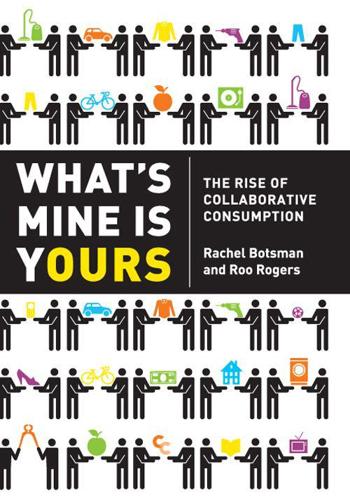
What's Mine Is Yours: How Collaborative Consumption Is Changing the Way We Live
by
Rachel Botsman
and
Roo Rogers
Published 2 Jan 2010
What Lessig and the Creative Commons have done is to create a significant culture of online socializing that encourages us to share. Through our digital experiences, we are recognizing that by providing value to the community, we enable our own social value to expand in return. When we post photos on Flickr; our knowledge on the likes of Wikipedia, Open Street Map, and Citizendium; our news on Public News and Slashdot; and our research on Bepress and NeuroCommons, we learn that we need to “give to get” in these communities. As David Bollier writes in Viral Spiral, “The commons—a hazy concept to many people—is a new paradigm for creating value and organizing a community of shared interests.”21 Collaborative Consumption is tied to how these principles are being applied to other parts of our lives, beyond media or content, by tapping into an innate quest to be part of a solution or even a movement of people with similar interests.
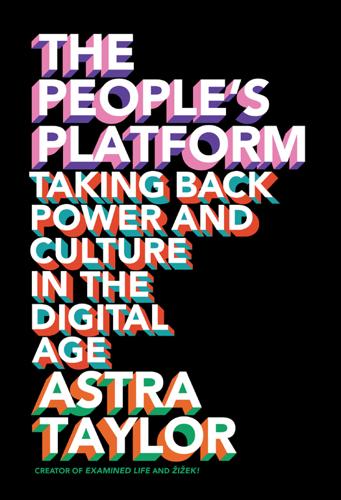
The People's Platform: Taking Back Power and Culture in the Digital Age
by
Astra Taylor
Published 4 Mar 2014
The National Center for Women and Information Technology reports that of the top one hundred tech companies, only 6 percent of chief executives are women.16 The numbers for Asians who ascend to the top are comparable despite the fact that they make up a third of all Silicon Valley software engineers.17 In 2010, not even 1 percent of the founders of Silicon Valley companies were black.18 Data on gender within online communities, routinely held up as exemplars of a new, open culture, are especially damning. First, consider Wikipedia. One survey revealed that women write less than 15 percent of the articles on the site, despite the fact that they use the resource in equal numbers to men. Collaborative filtering sites like Reddit and Slashdot, heralded by the digerati as the cultural curating mechanisms of the future, cater to users who are up to 90 percent male and overwhelmingly young, wealthy, and white.19 Reddit, in particular, has achieved notoriety for its misogynist culture, with threads where rapists can recount their exploits without fear of reprisal and photos of underage girls are posted under headings like “Chokeabitch,” “Niggerjailbait,” and “Creepshots” (“When you are in public, you do not have a reasonable expectation of privacy,” moderators posted.

Coders at Work
by
Peter Seibel
Published 22 Jun 2009
And not everybody was ready to think about concurrency and all the possible combinations of orders that are out there for even small scenarios. Once you combine code with other people's code it just gets out of control. You can't possibly model the state space in your head. Most people aren't up to it. I could be like one of these chest-thumpers on Slashdot—when I blogged about “Threads suck” someone was saying, “Oh he doesn't know anything. He's not a real man.” Come on, you idiot. I got a trip to New Zealand and Australia. I got some perks. But it was definitely painful and it takes too long. As Oscar Wilde said of socialism, “It takes too many evenings.”
…
That said, I think that if we're specifically discussing functional programming then I do think that we have seen a qualitative sea change in people's attitude. Many more people have heard about functional programming than ever used to. Suddenly rather than always having to explain what Haskell is, sometimes people say, “Oh, I've heard about that. In fact I was reading about it on Slashdot the other week and I gather it's rather cool.” That just didn't happen a few years ago. But what's underlying that? Is it just a random popularity thing? Or maybe part of it is that more students have been taught about functional programming in university and are now in managerial or seniorish positions.
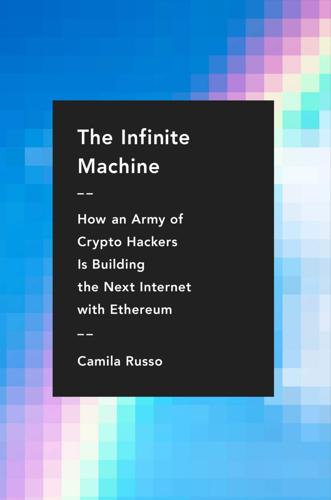
The Infinite Machine: How an Army of Crypto-Hackers Is Building the Next Internet With Ethereum
by
Camila Russo
Published 13 Jul 2020
After quitting his teaching job at the University of Colorado, he took a series of consulting contracts doing programming work. They were mostly boring jobs that paid the bills while he figured out what he really wanted to do. He kept drifting until he noticed Bitcoin was spiking. He had read the white paper in 2011 after seeing an article on the website Slashdot. At the time, he thought it was an interesting idea, but its volatility would never allow it to become a widely used means of exchange. To him, there also had to be a lot of infrastructure behind it, like credible exchanges and liquidity, before it could become a self-fulfilling prophecy and work.
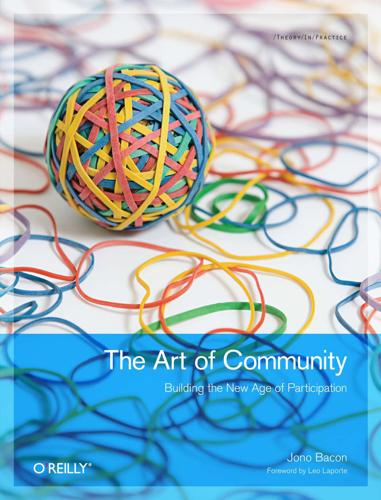
The Art of Community: Building the New Age of Participation
by
Jono Bacon
Published 1 Aug 2009
Various people had been involved over the preceding year, but essentially there were three staff [members] just before I joined. There was a very loose community initially, based on the notoriety of Lessig and other founders and some friendly coverage in the usual (for the time) geek outlets such as Slashdot—more a variety of well-wishers than a community. What kind of community did you set out to grow? The other person Creative Commons hired in April 2003 was our first international coordinator, based in Berlin. One community that we set out to grow, initially via this position, was a network of legal scholars around the world, who could collectively figure out how Creative Commons licenses work with copyright law in various jurisdictions around the world.
…
They had an indie game called Lugaru, and they wanted to find a way to promote it alongside the games made by their friends in the indie game community. They had assessed—as Cory Doctorow and others have said—that an independent creator’s number one challenge is obscurity. As indie game developers and geeks themselves, they had observed various trends through sites like Reddit, Slashdot, Ars Technica, and so on. It was clear that the gaming communities didn’t like DRM. Online sales that were package deals were very popular. Pay-what-you-want seemed to be somewhat hit-or-miss, but was almost always newsworthy. They were inspired by these various promotions and set out to combine all of the ideas into one, big, blowout Internet-melting event.

European Founders at Work
by
Pedro Gairifo Santos
Published 7 Nov 2011
Music recommendation never really was my field, but I had a go at it, and then later on we hired somebody who knew what they were doing. I was kept quite busy just with keeping the service alive. We moved it around between hosts several times. I was getting free hosting from the university originally. And then there was a Slashdot article and I had a word with the university sys admin and he told me about how to properly index my MySQL database, that kind of thing. Then other people contributed free hosting. So I would move the site every couple of months to a new server. So it jumped around all over the place at the beginning.
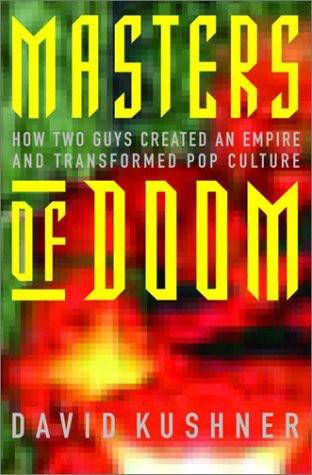
Masters of Doom: How Two Guys Created an Empire and Transformed Pop Culture
by
David Kushner
Published 2 Jan 2003
Murderers, after all, had proven that they could find inspiration in anything–the White Album, Taxi Driver, Catcher in the Rye. How many acts of violence had the Bible inspired? After Columbine, however, few had the nerve or the knowledge to defend games. Jon Kate, a writer for Rolling Stone and the tech community Slashdot, posted several essays that assailed the media’s stereotypes of geeks and gamers. “This is so crazy and hysterical,” he told the San Francisco Chronicle. “The real issue should be how teenagers get their hands on machine guns and bombs–not about a Web site and video games.” Others offered backhanded defense at best.

The Inevitable: Understanding the 12 Technological Forces That Will Shape Our Future
by
Kevin Kelly
Published 6 Jun 2016
Anyone with an internet connection could post their work and gather an audience; it was the end of publishers controlling the gates. This was a revolution! And since it was a revolution, Wired published “A Declaration of the Independence of Cyberspace” announcing the end of old media. New media was certainly spawning rapidly. Among them were the link aggregators such as Slashdot, Digg, and later Reddit that enabled users to vote up or down items and to work together as a collaborative consensus filter, making mutual recommendations based on “others like you.” Rheingold believed that Wired would get further faster by unleashing people with strong voices, lots of passion, and the willingness to write without any editors to thwart them.
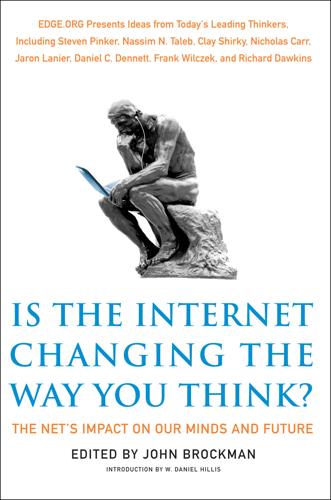
Is the Internet Changing the Way You Think?: The Net's Impact on Our Minds and Future
by
John Brockman
Published 18 Jan 2011
Only philosophical argument could establish that information overload has deprived us of our agency; the claim, at root, is philosophical, not empirical. My interlocutors might cleverly reply that in the age of Facebook and Wikipedia we do still deliberate, but collectively. In other words, for example, we vote stuff up or down on Digg, del.icio.us, and Slashdot, and then we might feel ourselves obligated—if we’re participating as true believers—to pay special attention to the top-voted items. Similarly, we attempt to reach “consensus” on Wikipedia, and—again, if participating as true believers—we endorse the end result as credible. To the extent that our time is thus directed by social networks engaged in collective deliberation, we are subjugated to a “collective will,” something like Rousseau’s notion of a general will.

Custodians of the Internet: Platforms, Content Moderation, and the Hidden Decisions That Shape Social Media
by
Tarleton Gillespie
Published 25 Jun 2018
“Censorship by Proxy: The First Amendment, Internet Intermediaries, and the Problem of the Weakest Link.” University of Pennsylvania Law Review 155 (1): 11. KUSHNER, SCOTT. 2016. “Read Only: The Persistence of Lurking in Web 2.0.” First Monday 21 (6). http://pear.accc.uic.edu/ojs/index.php/fm/article/view/6789. LAMPE, CLIFF, AND PAUL RESNICK. 2004. “Slash(Dot) and Burn: Distributed Moderation in a Large Online Conversation Space.” In Proceedings of the SIGCHI Conference on Human Factors in Computing Systems, 543–50. New York: ACM Press. http://dl.acm.org/citation.cfm?id=985761. LANE, FREDERICK S. 2006. The Decency Wars: The Campaign to Cleanse American Culture.

Boom: Bubbles and the End of Stagnation
by
Byrne Hobart
and
Tobias Huber
Published 29 Oct 2024
This phase corresponds to Nakamoto’s release of the Bitcoin white paper and software, which attracted technologists and cypherpunks who worked to improve Bitcoin’s software. Next comes the peak of inflated expectations. In Bitcoin’s case, phase two began in July 2010, when an article about Bitcoin Version 0.3 appeared on the popular technology website Slashdot. Shortly thereafter, Mt. Gox, the first bitcoin exchange, launched. With speculation running wild, the price of one bitcoin rose to $31.90 in June 2011. After that, Bitcoin hit the third phase of the hype cycle, the trough of disillusionment. Its price decreased rapidly before bottoming out in April 2013.

The Age of Surveillance Capitalism
by
Shoshana Zuboff
Published 15 Jan 2019
For details of bans in key countries, see “New Developments Regarding Google Street View,” Austrian Data Protection Agency, April 4, 2016, http://web.archive.org/web/20160404072538/https://www.dsb.gv.at/site/6733/default.aspx; Helena Smith Athens, “Google Street View Banned from Greece,” Guardian, May 12, 2009, https://www.the guardian.com/technology/2009/may/12/google-street-view-banned-greece; John Ribeiro, “Google Street View in India Faces Challenges,” PCWorld, May 26, 2011, http://www.pcworld.com/article/228713/article.html; Danuta Pavilenene, “Google Street View Banned from Lithuanian Streets,” Baltic Course, May 23, 2012, http://www.baltic-course.com/eng/Technology/?doc =57649. 57. Liz Gannes, “Ten Years of Google Maps, from Slashdot to Ground Truth,” Recode, February 8, 2015, http://www.recode.net/2015/2/8/11558788/ten-years-of-google-maps-from-slashdot-to-ground-truth. 58. Kashmir Hill, “Google’s Privacy Director Is Stepping Down,” Forbes, April 1, 2013, http://www.forbes.com/sites/kashmirhill/2013/04/01/googles-privacy-director-is-stepping-down/print; ScroogledTruth, Scroogled—Dr. Alma Whitten (Google’s Privacy Engineering Lead) Before Congress, 2013, https://www.youtube.com/watch?

Python Web Development With Django
by
Jeff Forcier
Not surprisingly, it is also more complicated to set up than the others. But if you need it, it’s worth it. It was originally created at Livejournal.com to ease the load that 20 million page views per day were putting on their database servers. It has since been adopted at Wikipedia.org, Fotolog.com, Slashdot.org, and other busy sites. Memcached’s home page is located at http://danga.com/memcached. The major advantage Memcached offers over the other options listed here is easy distribution across multiple servers. Memcached is a “giant hash table in the sky”; you use it like a key-value mapping such as a Python dictionary, but it transparently spreads the data across as many servers as you give it.
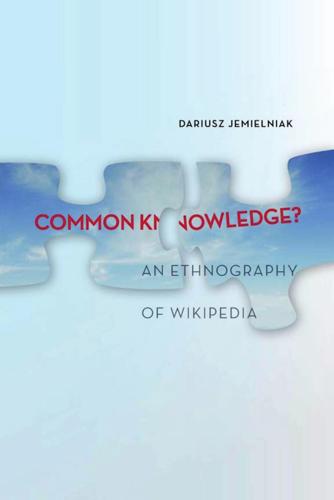
Common Knowledge?: An Ethnography of Wikipedia
by
Dariusz Jemielniak
Published 13 May 2014
Ostrom’s principles related to smaller communities, and it can be assumed that Wikipedia is a pioneer in addressing many of the social organization problems of scale and that not all principles of open-collaboration communities may be fully applicable to it. C h a p t er 5 1. Essjay’s original talk page no longer exists, but this post has been archived at http://www.wikipedia-watch.org/essjay.html. 2. This post is archived at http://en.wikipedia.org/w/index.php?title=User_talk:Ess jay&oldid=112480415#Slashdot. 3. This post is archived at http://en.wikipedia.org/w/index.php?title=User_ talk:Essjay&oldid=112480415. No t e s t o C h a p t er 6 2 3 3 C h a p t er 6 1. For a useful taxonomy of contributions to Wikimedia projects, see “Research:Contribution Taxonomy Project,” 2012. 2. I wrote these words two days after I was appointed one of seven members of the FDC, and I was later elected chair.

Liars and Outliers: How Security Holds Society Together
by
Bruce Schneier
Published 14 Feb 2012
Other examples are letters of introduction, tribal clothing, employee background checks, sex offender databases, diplomas posted on walls, and U.S. State Department travel advisories. Informal online reviews of doctors allow us to trust people we don't know anything about, with our health. Online reputational systems allow us to trust unknown products on Amazon, unknown commenters on Slashdot, and unknown “friends” on Facebook. Credit-rating systems codify reputation. In online games, security systems are less of an enhancement to, and more of a replacement of, moral and reputational pressures for ensuring game fairness. Security-augmented institutional pressure. A community might install cameras to help enforce speed limits.

Producing Open Source Software: How to Run a Successful Free Software Project
by
Karl Fogel
Published 13 Oct 2005
Publicity In free software, there is a fairly smooth continuum between purely internal discussions and public relations statements. This is partly because the target audience is always ill-defined: given that most or all posts are publicly accessible, the project doesn't have full control over the impression the world gets. Someone—say, a Hacker News poster or slashdot.org editor—may draw millions of readers' attention to a post that no one ever expected to be seen outside the project. This is a fact of life that all open source projects live with, but in practice, the risk is usually small. In general, the announcements that the project most wants publicized are the ones that will be most publicized, assuming you use the right mechanisms to indicate relative newsworthiness to the outside world.

Jennifer Morgue
by
Stross, Charles
Published 12 Jan 2006
So I duly issue Pete with a 1.4 gigahertz Toshiba Sandwich Toaster, enlist his help in moving my stuff into the new office, nail a WiFi access point to the door like a tribal fetish or mezuzah ("this office now occupied by geeks who worship the great god GHz"), and park him on the other side of the spacious desk so I can keep an eye on him. The next day I've got a staff meeting at 10:00 a.m. I spend the first half hour of my morning drinking coffee, making snide remarks in e-mail, reading Slashdot, and waiting for Pete to show up. He arrives at 9:35. "Here." I chuck a fat wallet full of CD-Rs at him. "Install these on your laptop, get on the intranet, and download all the patches you need. Don't, whatever you do, touch my computer or try to log onto my NWN server — it's called Bosch, by the way.

Django Book
by
Matt Behrens
Published 24 Jan 2015
Each time a user requests a page, the Web server makes all sorts of calculations – from database queries to template rendering to business logic – to create the page that your site’s visitor sees. This is a lot more expensive, from a processing-overhead perspective, than your standard read-a-file-off-the-filesystem server arrangement. For most Web applications, this overhead isn’t a big deal. Most Web applications aren’t washingtonpost.com or slashdot.org; they’re simply small- to medium-sized sites with so-so traffic. But for medium- to high-traffic sites, it’s essential to cut as much overhead as possible. That’s where caching comes in. To cache something is to save the result of an expensive calculation so that you don’t have to perform the calculation next time.
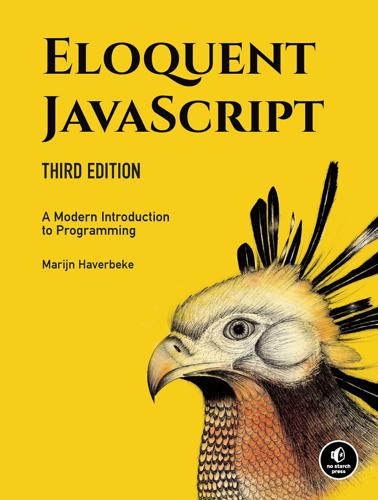
Eloquent JavaScript: A Modern Introduction to Programming
by
Marijn Haverbeke
Published 15 Nov 2018
PRAISE FOR THE FIRST AND SECOND EDITIONS OF ELOQUENT JAVASCRIPT “Provides some of the best explanations of programming concepts that I’ve ever read.” —SANDRA HENRY-STOCKER, IT WORLD “If you choose to start your JavaScript journey with this book, it can quickly teach you a lot of technical information and also programming wisdom.” —MICHAEL J. ROSS, WEB DEVELOPER AND SLASHDOT CONTRIBUTOR “I became a better architect, author, mentor and developer because of this book. It deserves to share shelf space with Flannagan and Crockford.” —ANGUS CROLL, TWITTER DEVELOPER “The best introduction into any programming language and programming overall. Period.” —JAN LEHNARDT, CO-CREATOR OF HOODIE AND ORGANIZER OF JSCONF EU “This is the book I give out when people ask me how to learn proper JavaScript.”

Networks, Crowds, and Markets: Reasoning About a Highly Connected World
by
David Easley
and
Jon Kleinberg
Published 15 Nov 2010
POSITIVE AND NEGATIVE RELATIONSHIPS be seen as a slide into a hard-to-resolve opposition between two sides. Trust, Distrust, and On-Line Ratings. A growing source for network data with both positive and negative edges comes from user communities on the Web where people can express positive or negative sentiments about each other. Examples include the technology news site Slashdot, where users can designate each other as a “friend” or a “foe” [262], and on-line product-rating sites such as Epinions, where a user can express her evaluation of different products, and also express her trust or distrust of other users. Guha, Kumar, Raghavan, and Tomkins performed an analysis of the network of user evaluations on Epinions [200]; their work identified an interesting set of issues that show how the trust/distrust dichotomy in on-line ratings has both similarities and differences with the friend/enemy dichotomy in structural balance theory.
…
[261] Ravi Kumar, Prabhakar Raghavan, Sridhar Rajagopalan, D. Sivakumar, Andrew Tomkins, and Eli Upfal. Random graph models for the web graph. In Proc. 41st IEEE Symposium on Foundations of Computer Science, pages 57–65, 2000. [262] Jérôme Kunegis, Andreas Lommatzsch, and Christian Bauckhage. The Slashdot Zoo: Mining a social network with negative edges. In Proc. 18th International World Wide Web Conference, pages 741–750, 2009. [263] Marcelo Kuperman and Guillermo Abramson. Small world effect in an epidemiological model. Physical Review Letters, 86(13):2909–2912, March 2001. [264] Amy N. Langville and Carl D.
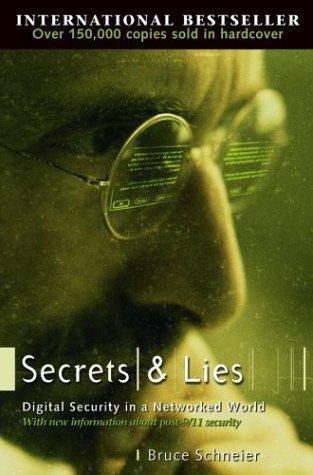
Secrets and Lies: Digital Security in a Networked World
by
Bruce Schneier
Published 1 Jan 2000
In 1990, the Secret Service raided the headquarters of a role-playing game company, Steve Jackson Games, because the company was working on a role-playing game (not even a computer program) that had something to do with “cyberpunks” and hackers, and because they believed an employee, Loyd Blankenship, was a member of the “Legion of Doom” hacker group. In 1999, the DVD Copy Control Association tried to gag 500 Web sites whose only crime was writing about the DVD encryption break. And in 2000, Microsoft tried to force Slashdot to delete postings about its proprietary extensions to the Kerberos protocol. This is also not meant to be a call for overreaction, which we saw a lot of in the 1990s. David Smith, the author of the Melissa virus, faces five to ten years in prison. Kevin Mitnick got (and served) almost five years, and was prohibited from using a computer for another three.
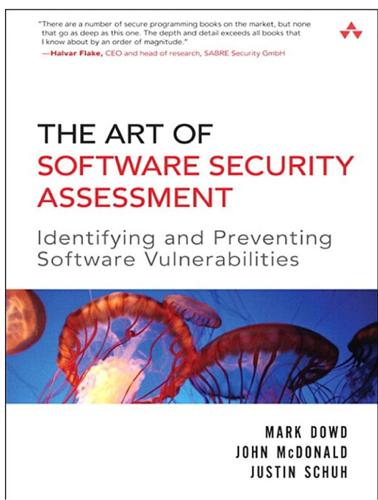
The Art of Software Security Assessment: Identifying and Preventing Software Vulnerabilities
by
Justin Schuh
Published 20 Nov 2006
The TCP stack must ensure that the option length, when added to the offset into the header where the option appears, isn’t larger than the total size of the TCP header (and, of course, the total size of the packet). TCP Connections Before two hosts can communicate over TCP, they must establish a connection. TCP connections are uniquely defined by source IP address, destination IP address, TCP source port, and TCP destination port. For example, a connection from a Web browser on your desktop to Slashdot’s Web server would have a source IP of something like 24.1.20.30, and a high, ephemeral source port such as 46023. It would have a destination IP address of 66.35.250.151, and a destination port of 80 the well-known port for HTTP. There can only be one TCP connection with those ports and IP addresses at any one time.
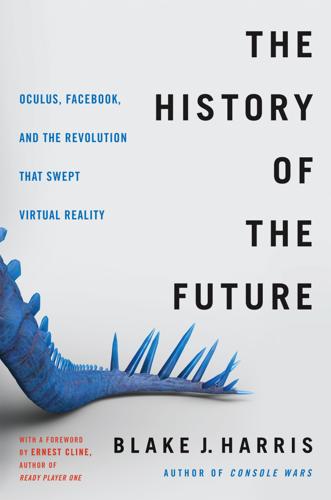
The History of the Future: Oculus, Facebook, and the Revolution That Swept Virtual Reality
by
Blake J. Harris
Published 19 Feb 2019
The New York Times, October 11, 2011. 4.Kushner, David. Masters of Doom: How Two Guys Created an Empire and Transformed Pop Culture. New York: Random House, 2003. 5.Abrash, Michael. “Valve: How I Got Here, What It’s Like, and What I’m Doing.” Ramblings in Valve Time, April 13, 2012. 6.Carmack, John. “Parasites.” Slashdot (Comments Section), June 2, 2005. 7.“Products: Personal 3D Viewer.” Sony.com, September 23, 2011. 8.Tone. “LEEP on the Cheap.” VR-TIFACTS, March 23, 2011. 9.Luckey, Palmer. “Oculus “Rift”: An open-source HMD for Kickstarter.” MTBS3D, April 15, 2012. CHAPTER 3 1.Carmack, John. “A Day with an Oculus Rift.”
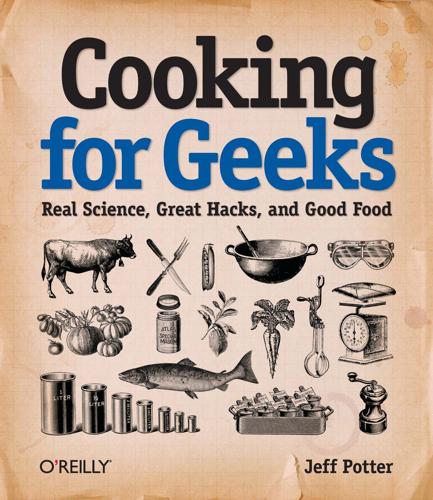
Cooking for Geeks
by
Jeff Potter
Published 2 Aug 2010
Part of that is due to not wanting to waste the food or the money, but the other part is they haven’t gotten to the point where they’re enjoying doing it over until they get it right. Have there been any particular recipes whose success has caught you off-guard? Tiramisu is the recipe that launched Cooking for Engineers. I posted the tiramisu recipe, and three days later I was getting maybe 100 page views a day on that article. Enough people saw it that I got attention from Slashdot, which wrote an article about this new cooking website geared toward geeky people. Boom, I got a lot of readership. So much so that I had a little trouble keeping up with the number of people who were looking at the web pages on the little server that I was running on. The tiramisu recipe that we have on Cooking for Engineers is a bit more simplified than many of the other tiramisu recipes.

The Architecture of Open Source Applications
by
Amy Brown
and
Greg Wilson
Published 24 May 2011
The rendering engine started as an experiment, simply to see if I could write one. whisper was written over the course of a weekend out of desperation to solve a show-stopper problem before a critical launch date. carbon has been rewritten more times than I care to remember. Once I was allowed to release Graphite under an open source license in 2008 I never really expected much response. After a few months it was mentioned in a CNET article that got picked up by Slashdot and the project suddenly took off and has been active ever since. Today there are dozens of large and mid-sized companies using Graphite. The community is quite active and continues to grow. Far from being a finished product, there is a lot of cool experimental work being done, which keeps it fun to work on and full of potential.

NeuroTribes: The Legacy of Autism and the Future of Neurodiversity
by
Steve Silberman
Published 24 Aug 2015
For two young men generally too shy to ask a girl out to the local multiplex on Saturday night, they proved adept at promoting their creation in social media, buying placement in Google’s AdSense and AdWords so a reporter new to the autism beat would inevitably be directed to Wrong Planet while generating a healthy income stream for the site. The community grew slowly and steadily until Slashdot, the preeminent tech news aggregator, linked to Plank’s interview with Bram Cohen, the autistic creator of BitTorrent, a peer-to-peer file-sharing protocol estimated to account for a third of all Internet traffic in the United States. New members poured in by the thousands. Young people on the spectrum flocked to online communities like Wrong Planet to announce their diagnoses as cause for celebration rather than as occasions for mourning, because their lives had at last come into focus.
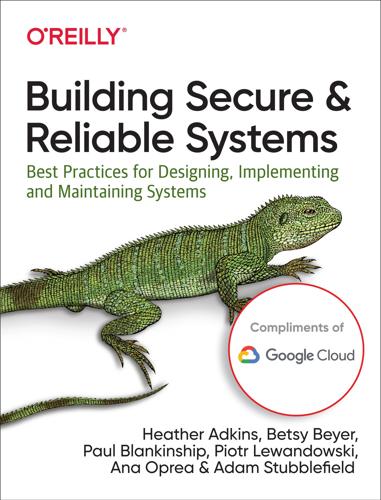
Building Secure and Reliable Systems: Best Practices for Designing, Implementing, and Maintaining Systems
by
Heather Adkins
,
Betsy Beyer
,
Paul Blankinship
,
Ana Oprea
,
Piotr Lewandowski
and
Adam Stubblefield
Published 29 Mar 2020
The global pool of similar resources also becomes smaller—for example, disk failures reduce overall storage capacity, network failures reduce bandwidth and increase latency, and software failures reduce the computational capacity system-wide. The failures might compound—for example, a storage shortage could lead to software failures. Resource shortages like these, or a sudden spike in incoming requests like those caused by the Slashdot effect, misconfiguration, or a denial-of-service attack, could lead to system overload. When a system’s load exceeds its capacity, its response inevitably begins to degrade, and that can lead to a completely broken system with no availability. Unless you’ve planned for this scenario in advance, you don’t know where the system may break—but this will most likely be where the system is weakest, and not where it’s safest.
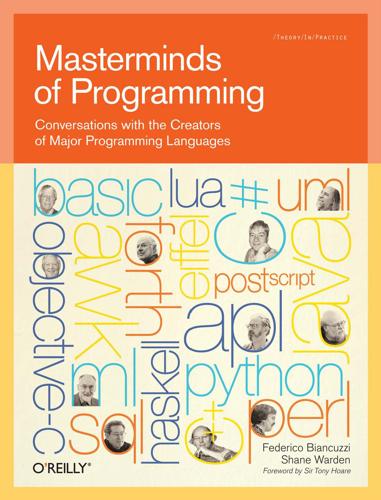
Masterminds of Programming: Conversations With the Creators of Major Programming Languages
by
Federico Biancuzzi
and
Shane Warden
Published 21 Mar 2009
To me, that’s fast, not slow. How can we transmit experience in the software field? Grady: In the Middle Ages, guilds served as a primary mechanism for the transmission of tribal memory; today, we lack such apprenticeships in software. Still, a considerable amount of experience is transmitted via the Web (consider Slashdot, for example), books, blogs, and technical meetings. It is also that case that raw, running, naked source code is a source of knowledge from the past—and this is one of the reasons I’ve worked with the Computer History Museum to preserve the code of classic software for future generations. What should today’s students study more?
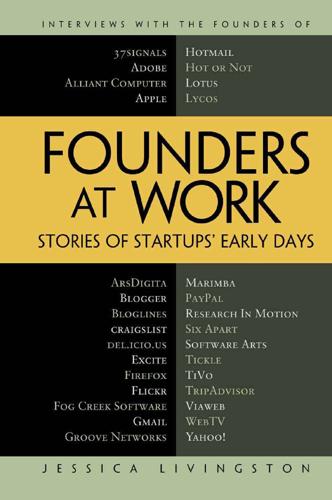
Founders at Work: Stories of Startups' Early Days
by
Jessica Livingston
Published 14 Aug 2008
I had started another company—an anti-spam company—called Trustic, and that wasn’t going very far. But as I was starting that, I was doing this other thing on the side, which became Bloglines. I had a bookmark list of about 100 sites that I went to every day just to see if there was new stuff. Things like Slashdot, CNN, my friends’ blogs. It was taking a long time; I figured there had to be a better solution to 233 234 Founders at Work this, and that’s how I found out about RSS. At that time, there were a couple of desktop-based aggregators—programs that you could download. But those weren’t really applicable to me because I’m on several different computers every day and the quality of the programs weren’t very good.

Code Complete (Developer Best Practices)
by
Steve McConnell
Published 8 Jun 2004
It is used primarily for client-side programming such as adding simple functions and online applications to Web pages. Perl Perl is a string-handling language that is based on C and several UNIX utilities. Perl is often used for system administration tasks, such as creating build scripts, as well as for report generation and processing. It's also used to create Web applications such as Slashdot. The acronym "Perl" stands for Practical Extraction and Report Language. PHP PHP is an open-source scripting language with a simple syntax similar to Perl, Bourne Shell, JavaScript, and C. PHP runs on all major operating systems to execute server-side interactive functions. It can be embedded in Web pages to access and present database information.
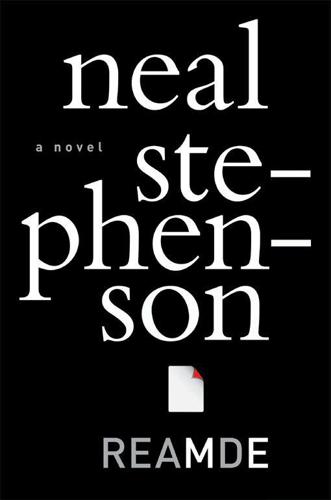
Reamde
by
Neal Stephenson
Published 19 Sep 2011
And he rolled clear of a window and pointed toward one marked UNITED STATES OF AMERICA. “What’s going on?” Zula asked. Csongor shrugged. “Some kind of conference maybe?” “Taiwan,” Peter said. “I heard about this! It’s something to do with Taiwan.” Zula goggled, not out of skepticism but because she didn’t normally look to Peter to be up to speed on current events. He shrugged. “Slashdot. There’s been some kind of hassle, connected with this. Denial-of-service attacks against Taiwanese ISPs.” “Okay, yes! I did hear something about this,” Csongor said. “They are having diplomatic talks. But I didn’t realize it was happening in Xiamen.” But this was the last they saw before Sokolov ordered that all the shades be pulled down.
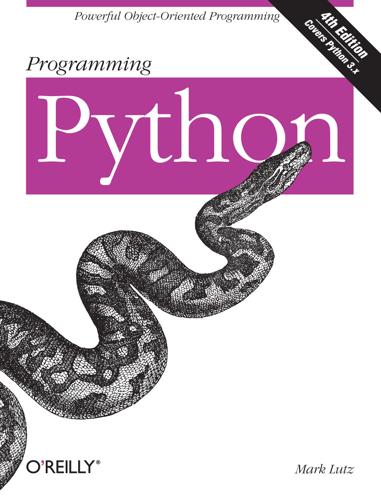
Programming Python
by
Mark Lutz
Published 5 Jan 2011
__init__(self, parent) self.pack() self.lbl = Label(self, text="none", bg='blue', fg='red') self.pix = Button(self, text="Press me", command=self.draw, bg='white') self.lbl.pack(fill=BOTH) self.pix.pack(pady=10) demoCheck.Demo(self, relief=SUNKEN, bd=2).pack(fill=BOTH) files = glob(gifdir + "*.gif") self.images = [(x, PhotoImage(file=x)) for x in files] print(files) def draw(self): name, photo = random.choice(self.images) self.lbl.config(text=name) self.pix.config(image=photo) if __name__ == '__main__': ButtonPicsDemo().mainloop() This version works the same way as the original, but it can now be attached to any other GUI where you would like to include such an unreasonably silly button. * * * [34] This particular image is not my creation; it appeared as a banner ad on developer-related websites such as Slashdot when the book Learning Python was first published in 1999. It generated enough of a backlash from Perl zealots that O’Reilly eventually pulled the ad altogether. Which may be why, of course, it later appeared in this book. Viewing and Processing Images with PIL As mentioned earlier, Python tkinter scripts show images by associating independently created image objects with real widget objects.